- Undergraduate
- High School
- Architecture
- American History
- Asian History
- Antique Literature
- American Literature
- Asian Literature
- Classic English Literature
- World Literature
- Creative Writing
- Linguistics
- Criminal Justice
- Legal Issues
- Anthropology
- Archaeology
- Political Science
- World Affairs
- African-American Studies
- East European Studies
- Latin-American Studies
- Native-American Studies
- West European Studies
- Family and Consumer Science
- Social Issues
- Women and Gender Studies
- Social Work
- Natural Sciences
- Pharmacology
- Earth science
- Agriculture
- Agricultural Studies
- Computer Science
- IT Management
- Mathematics
- Investments
- Engineering and Technology
- Engineering
- Aeronautics
- Medicine and Health
- Alternative Medicine
- Communications and Media
- Advertising
- Communication Strategies
- Public Relations
- Educational Theories
- Teacher's Career
- Chicago/Turabian
- Company Analysis
- Education Theories
- Shakespeare
- Canadian Studies
- Food Safety
- Relation of Global Warming and Extreme Weather Condition
- Movie Review
- Admission Essay
- Annotated Bibliography
- Application Essay
- Article Critique
- Article Review
- Article Writing
- Book Review
- Business Plan
- Business Proposal
- Capstone Project
- Cover Letter
- Creative Essay
- Dissertation
- Dissertation - Abstract
- Dissertation - Conclusion
- Dissertation - Discussion
- Dissertation - Hypothesis
- Dissertation - Introduction
- Dissertation - Literature
- Dissertation - Methodology
- Dissertation - Results
- GCSE Coursework
- Grant Proposal
- Marketing Plan
- Multiple Choice Quiz
- Personal Statement
- Power Point Presentation
- Power Point Presentation With Speaker Notes
- Questionnaire
- Reaction Paper
- Research Paper
- Research Proposal
- SWOT analysis
- Thesis Paper
- Online Quiz
- Literature Review
- Movie Analysis
- Statistics problem
- Math Problem
- All papers examples
- How It Works
- Money Back Policy
- Terms of Use
- Privacy Policy
- We Are Hiring

Survival Skills, Essay Example
Pages: 3
Words: 693
Hire a Writer for Custom Essay
Use 10% Off Discount: "custom10" in 1 Click 👇
You are free to use it as an inspiration or a source for your own work.
Survival Skills: Three Kinds of Discipline
For a student, the most obvious place to look for something to classify is in the unique life of the campus, classroom, and dorm-room. But this paper’s instructions state to “classify survival skills that people need to get through life.” I looked around and came up with three plausible categories that will help me in the future as both a student and non-student. My classification is the three kinds of discipline people employ to survive in the modern world. I illustrate their differences by restricting the discussion to the kinds of discipline employed by those who want to become physically fit, or want to keep the fitness they already have.
The first kind of person practicing physical fitness is the kind who naturally enjoys the process itself, not just the outcome. I will call them the naturally fit . They walk a lot, whenever they can. “I have the European urge to use my feet whenever a drive can be dispensed with,” wrote Humbert Humbert in Lolita. For such people, fitness is just the natural outcome of their lifestyle. If they attend a gym, they are likely to walk to it on the way to or from their job or their campus because they live within walking distance of most of the important functions in their lives. But they are unlikely to exercise strenuously every day. Instead, they simply follow their inspiration to do that, whenever it strikes. Suddenly they have a vision of themselves working out, or hiking, or jogging — whatever. That’s all it takes because they actually look forward to it. This fortunate kind of person actually does not employ discipline in the usual sense of the word, except to intelligently resist the temptations of the other two, discussed briefly below.
The second kind of person is what I call the punitively fit. Exercise is strictly an exercise in discipline alone. I can punish myself more than you can punish yourself is the implied boast these people live to make. An example would be the man I read about a few years ago who found himself unable to ever skip his morning jog. After he broke his ankle, he rigged up a special sort of spring-loaded cast that would enable him to jog with acceptable pain. People known as gym rats might be another example. Basically their lives revolve around their workouts and eventually their workouts come to define them. To skip a workout becomes unthinkable. And so does less than perfect fitness, as defined by exercise devices and the metrics they display.
The third type is what I call the apparently fit. These people remind me of a cigarette smoker who is always in the process of quitting but never quiet manages it. (I once saw a woman in workout clothes take a couple of quick, last deep drags on a cigarette before heading to her strip-mall fitness center.) Many of the apparently fit join commercial gyms and take yoga classes. They use their cars to get there, hassling with parking and traffic. They do not eat particularly healthy food — that’s what the exercise is for. Eventually if not sooner, the stress and bother of it all gets to the apparently fit, and they quit attending — which is exactly the outcome commercial gyms depend on. As for exercising on their own in a park or just walking to the store more often, the one doesn’t provide a group to be a part of, and the other requires too much time.
So there is natural discipline, the kind that is not punitive but rather is just the product of a particular kind of person and their lifestyle. They genuinely enjoy the process, which is not something they can quit. Then there is the punitive kind without which the goal being sought would simply be pointless. Pain is the point. And then there is the kind that does not exist in any real way, except to fool those who practice it. It is pretty clear that these three kinds of discipline can be applied to all kinds of activities in life. To survive, different kinds of people need them.
Stuck with your Essay?
Get in touch with one of our experts for instant help!
My Christian Philosophy of Education, Essay Example
Heart Disease Deaths Among Firefighters, Essay Example
Time is precious
don’t waste it!
Plagiarism-free guarantee
Privacy guarantee
Secure checkout
Money back guarantee

Related Essay Samples & Examples
Voting as a civic responsibility, essay example.
Pages: 1
Words: 287
Utilitarianism and Its Applications, Essay Example
Words: 356
The Age-Related Changes of the Older Person, Essay Example
Pages: 2
Words: 448
The Problems ESOL Teachers Face, Essay Example
Pages: 8
Words: 2293
Should English Be the Primary Language? Essay Example
Pages: 4
Words: 999
The Term “Social Construction of Reality”, Essay Example
Words: 371

NEXT LEVEL SURVIVAL
Disclosure: When you buy through links on our site we may earn a commission. Disclosure - Learn More .
Surviving the Wild: 10 Essential Wilderness Survival Skills
Discover the top 10 wilderness survival skills every adventurer should know before setting out into the great unknown.
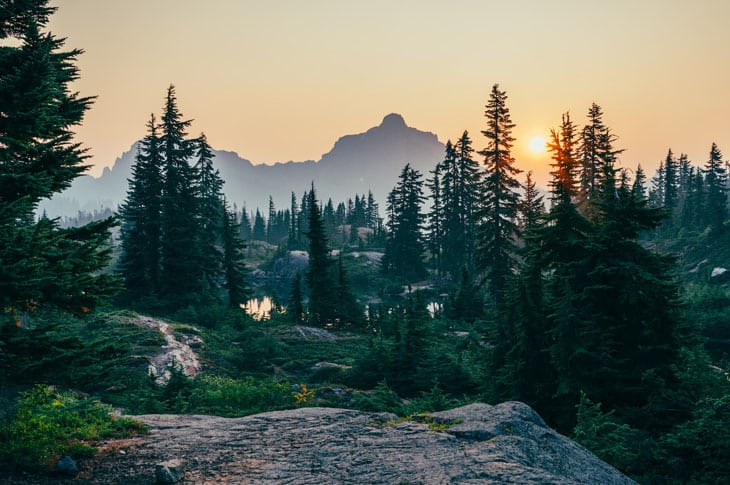
Whether you’re a seasoned adventurer or just starting out, the importance of having essential survival skills cannot be overstated. I’m talking about the skills that could save your life when you’re lost, injured, or stranded in the wild.
Why is it so important to learn these skills? Well, the answer is simple – the wilderness is a beautiful but unforgiving place. You never know when you might get caught in a sudden storm, run out of water, or get injured on a remote trail. Without the right survival skills, you could find yourself in a life-threatening situation with no way out.
But we’ve got you covered. In this article, we’ll be diving into the top 10 essential wilderness survival skills that every adventurer should know. From building a shelter and starting a fire to finding food and water, we’ll cover everything you need to survive in the wild.
So, get ready to learn how to navigate through the wilderness, signal for help, and even administer first aid in case of an emergency.
Table of Contents
The pillars of effective wilderness survival skills.
Wilderness survival skills encompass much more than merely staying alive. Several activities, such as bushcraft, camping, hiking & backpacking, and hunting, contribute to a well-rounded survivalist.
Bushcraft: Mastering Nature’s Tools
Bushcraft is the art of thriving in the wild using only natural resources. It’s a cornerstone of wilderness survival skills, teaching essential techniques like:
- Firestarting with friction
- Building shelter with natural materials
- Foraging for edible plants and insects
- Crafting tools and weapons from wood, stone, and bone
With bushcraft skills, you become a resourceful survivor, capable of adapting to any environment.
Camping: Building Your Outdoor Home
Camping and wilderness survival are cut from the same cloth. It’s a fantastic way to practice and improve upon essential skills, including:
- Setting up tents and shelters
- Cooking over open fires
- Navigating with a map and compass
- Tying knots and lashings
By camping regularly, you hone your abilities to live comfortably outdoors and respond to unexpected situations.
Hiking & Backpacking: Exploring the Great Outdoors
Hiking and backpacking prepare you for extended stays in the wilderness. These activities test your endurance and teach vital lessons, such as:
- Properly packing a backpack
- Planning and following a route
- Identifying and avoiding hazards
- Reading weather patterns
You’ll learn to travel efficiently and safely while appreciating the beauty of nature.
Hunting: Providing Food for Survival
Hunting is an indispensable wilderness survival skill. It not only provides sustenance but also teaches stealth, patience, and respect for wildlife. Key aspects of hunting include:
- Tracking and stalking game
- Field dressing and preserving meat
- Building and using hunting blinds
- Understanding animal behavior and habitats
Mastering hunting techniques ensures you can sustain yourself in the most remote locations.
Wilderness survival encompasses a wide range of activities that promote self-reliance and adaptability. By learning bushcraft, camping, hiking & backpacking, and hunting, you become a more versatile and resilient outdoors enthusiast.
Finding and Purifying Water
Without water, you have about 2 days before life gets precarious. I know the rule of thumb is 3 days, but dehydration becomes debilitating sooner than that. So when you’re in the wilderness, finding and purifying water is essential for your survival. Let’s dive in and discuss the best ways to find and purify water in the wild.
Find Sources of Water
Firstly, let’s talk about finding water sources. The key is to look for signs of life – animals, insects, and vegetation. They all need water to survive, so if you spot them, chances are there’s water nearby. Additionally, keep an eye out for depressions in the ground or areas with damp soil, as they may indicate the presence of underground water.
The next step to finding water is to head downhill. Surface water trickles into creeks that flow into valleys, where they form streams that flow into ponds and lakes. So heading downhill will significantly increase your chances of finding low lying areas, potentially where water has collected.
Once you’ve located a water source, it’s time to collect and purify it. Don’t just start gulping it down. The water may contain harmful bacteria, viruses, or parasites that could make you seriously ill.
Collecting Water
Once you’ve found a source of water, it’s time to collect and purify it. You can use a water bottle, canteen, or even a plastic bag to collect water from a stream or river. However, make sure to filter the water before you purify it to remove any sediment or debris that may be present. You can use a cloth, coffee filter, or even a piece of clothing to filter the water.
Purifying Water
To purify the water, you have a few options. One is to boil it. Bring the water to a rolling boil for at least five minutes to kill any harmful bacteria and viruses. Another option is to use a water filter or purification tablets. These can effectively remove impurities and kill harmful organisms, but make sure to follow the instructions on the label carefully.
Conserving Water
And finally, let’s discuss conserving water. In the wilderness, water is a precious resource, so it’s crucial to use it wisely. One way to conserve water is to limit physical activity during the hottest parts of the day to reduce sweating. You can also use water sparingly when washing and cooking, and reuse water whenever possible.
Remember, the key to survival in the wilderness is preparation, and that includes having the skills to find and purify water.
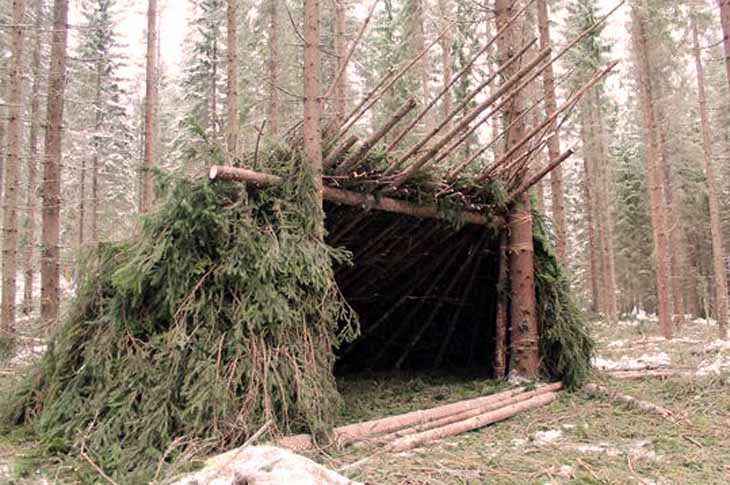
Building a Shelter
When you’re out in the wilderness, you need a good shelter that can protect you from the elements. Luckily, nature provides plenty of options for the savvy survivor.
Types of Natural Shelters
There are a few different types of natural shelters you can take advantage of, depending on what’s available in your area. A cave or rock overhang is a classic choice, but you can also build a shelter using natural materials like branches, leaves, and bark.
Building A Shelter
To build a shelter from scratch, you’ll need to find a good spot and gather some materials. Look for a spot that’s dry and protected from the wind, and clear away any debris or obstacles. Then, start building your frame using branches and saplings.
A lean-to, a-frame or debris hut are the easiest to make without any tools. You can use smaller twigs, pine needles, pine boughs, grass and leaves to create insulation and keep the elements out.
If it’s winter, your best bet is to build a snow shelter . All you need is a shovel (see the best survival shovels ), lots of snow and a few twigs.
If you don’t have access to natural materials, there are other options. Tarps or ponchos can be used to create simple survival shelters . You can even use your backpack or a piece of clothing as a makeshift roof.
Tips For Staying Warm and Dry
Staying warm and dry is crucial for survival, so make sure to add a layer of insulation to the floor of your shelter as well. Pine needles, leaves, and grass can all be used for this purpose. If you have access to a fire, use it to dry out wet clothing and to warm up your shelter. Just make sure to keep the fire small and contained.
Remember, building a shelter is a key wilderness survival skill that can mean the difference between life and death. So take the time to learn how to build a good one, and always be prepared for the worst.
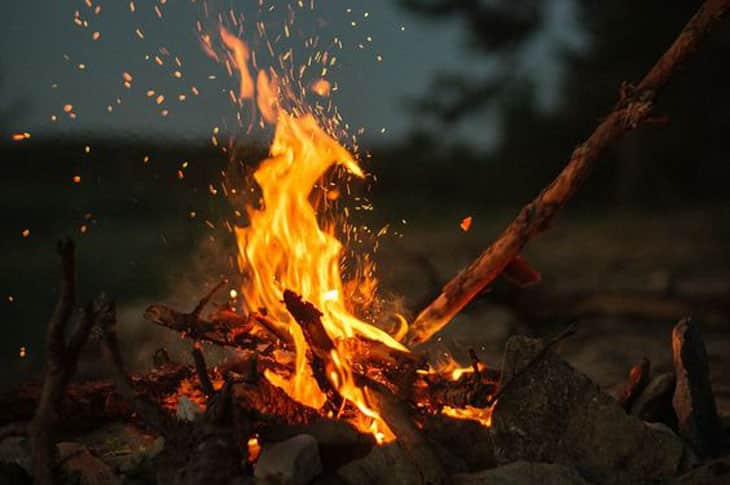
Starting a Fire
As challenging as it may be sometimes, you have to admit, fire starting is the fun part. And it can be applied across all aspects of survival: urban survival skills and long term survival skills . Here’s what to do to make it as easy as possible so you’re not struggling to catch a flame.
Materials To Make Fire
First things first, you need to find the right materials. Tinder is key – that’s anything that will catch fire easily, like dry grass, leaves, or bark shavings. Your tinder bundle needs to be as big as a bird’s nest or you run the risk of it burning up too soon.
Next, you’ll need kindling – small twigs and branches that are no thicker than your finger. See the best survival axes . Like the tinder bundle, your kindling pile needs to be twice as big as you initially think. Once you have a decent flame going, it’s time to add some sticks and logs to keep the fire burning long into the night.
In woodland areas, gather the amount of wood you think you need to burn through the night, then collect 5 times that. That’s how much people typically underestimate the amount of firewood they need.

Fire Starting
Now, onto the fun part – different methods for starting a fire. If you have matches or a lighter, count yourself lucky. But in the wilderness, you can’t always rely on modern conveniences. That’s where a good old-fashioned fire starter comes in – like a ferrocerium rod, which creates sparks when struck with a steel blade. If you don’t have a fire starter, you can try the hand drill or bow drill method, which involve rubbing sticks together to create friction and generate heat. It’s not easy, but it can be done with practice. See how to start a fire .
Fire Safety
But before you start channeling your inner caveman, it’s important to remember safety precautions. Always make sure you have a clear space for your fire, away from any low-hanging branches or dry brush. Build a ring of rocks around the fire to contain it, and never leave it unattended. And if you’re in a dry area, be sure to check for any fire restrictions or bans before starting a fire.
With the right materials, techniques, and safety precautions, starting a fire in the wilderness can be a satisfying and even enjoyable experience (see how to make your own survival fire starting kit ).
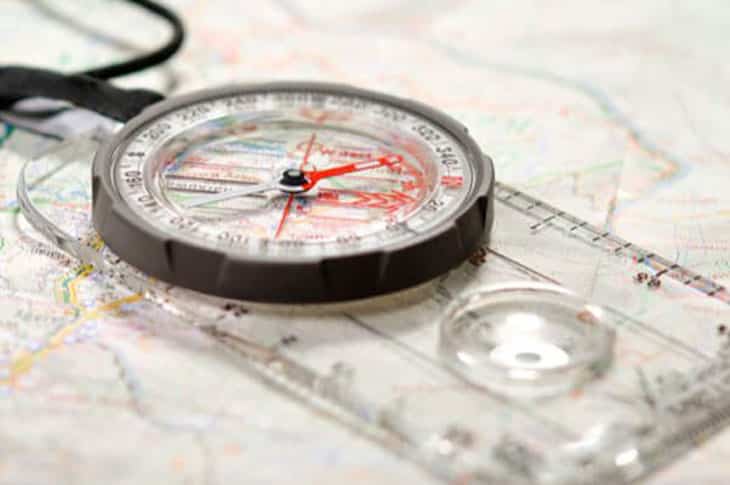
In the wilderness, it’s easy to get turned around and lose your sense of direction. That’s why having a reliable navigation system is crucial to your survival.
But with a little bit of knowledge, you can make sure that you never lose your way. In this section, we’ll cover the different tools and techniques that you can use to navigate in the wilderness.
Having a GPS
The easiest and most accurate way to navigate in the wilderness is with a GPS (Global Positioning System). A GPS can tell you exactly where you are and where you need to go. It can also track your progress and give you an estimated time of arrival. However, it’s important to remember that GPS devices can fail, run out of battery or lose reception in areas with thick tree canopies or canyons.
Using a Map and Compass
A map and compass are the most reliable backup navigation tools you can carry. A map will give you a general overview of the area, and a compass will help you to navigate in the right direction. When using a map and compass, be sure to orient yourself correctly, to ensure you are heading in the right direction. Always keep your map and compass safe from the elements, in a waterproof container or plastic zip-lock bag.
Orienting Yourself Without a Compass
Even if you don’t have a compass, there are still ways you can orient yourself in the wilderness. One method is to use the sun. You can determine the direction of east and west by observing where the sun rises and sets. You can also use the position of the stars and the moon to navigate.
Following Natural Markers
Another way to navigate in the wilderness is by following natural markers. Look for things like rock formations, rivers or creeks, and animal trails. In addition, pay attention to the direction that the wind is blowing, and the way that plants are growing. These can all be clues to help you navigate.
When it comes to wilderness survival, navigation is a key skill that you should have. Always carry a map and compass, and if possible, a GPS device.
Using Binoculars
Binoculars, in tandem with a compass and map, enhance wilderness survival navigation by offering a powerful trifecta. Binoculars magnify distant landmarks, elevating situational awareness, while a compass provides directional guidance.
Maps offer topographical context, streamlining route planning. Together, these tools empower you with superior navigational power, bolstering safety and efficiency, enabling you to confidently travel uncharted territories.
See the top binocular features for survival you should look for when shopping for that perfect pair of binoculars.
Signaling for Help
There are several ways to get the attention of rescuers or passersby, and this section will cover some of the most effective methods.
Creating a Signal Fire
One of the most recognizable ways to signal for help is to create a signal fire. A signal fire is a fire designed to produce smoke that can be seen from a distance.
To make a signal fire, you will need to gather dry materials like leaves, sticks, twigs, and some fresh green material. Once you have a pile of these materials, you can ignite the dry materials (see fire starting above). The key to making a signal fire is to keep adding dry materials to keep the fire burning bright and hot.
Then when you need lots of smoke, throw on some green materials. The smoke produced by the fire is what will catch the attention of rescuers. Make sure to keep the fire burning until you are rescued.

Making Noise
Another way to signal for help is by making noise. Yelling, screaming, and blowing a whistle are all effective methods for making noise in the wilderness. If you are traveling with a group, coordinate with them to make noise in a rhythm or pattern. This will make it easier for rescuers to identify that you are human, and not an animal or other natural sound.
However, do not waste your energy by yelling continuously. Take breaks between your noise-making efforts to preserve your energy.
Using Visual Signals
Visual signals are another way to get the attention of rescuers. Using reflective materials like mirrors or shiny metal can help you to catch the sunlight and produce a signal that can be seen from a distance. You can also use bright clothing or create an arrow or SOS sign with rocks or sticks on the ground. Remember to position your visual signal in an open area where it is visible from the air.
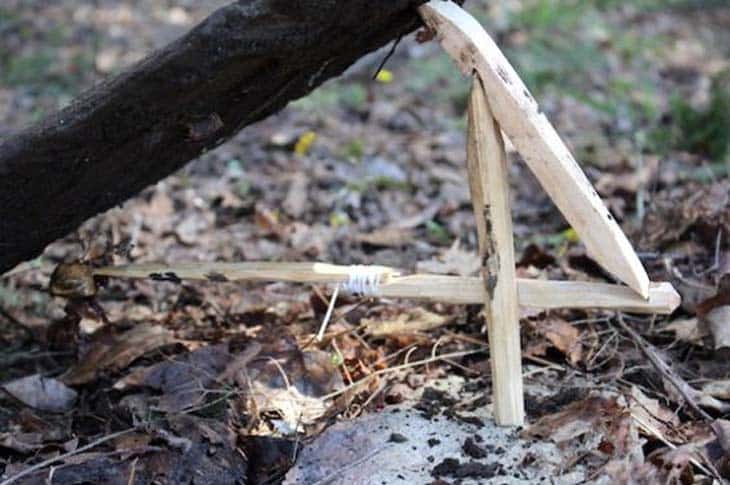
Hunting and Gathering Food
When you’re out in the wilderness, finding food is a top priority for survival. While hunting and gathering food may not be for everyone, it’s important to know how to do it in case of an emergency.
Foraging for food is another option, and can be a great way to supplement your diet. Take the time to learn the seasonality of plants in your area, otherwise you can expend more calories searching for them than you’ll get in return.
Look for wild mushrooms, berries, and other edible plants. However, it’s important to be careful and know what plants are safe to eat.
Identifying Edible Plants
Before setting out to look for plants, it’s important to know how to identify edible plants. Take the time to research what plants are safe to eat in your area and learn what parts of the plants are edible.
Some common edible plants include dandelions, cattails, wild strawberries, and blueberries. However, it’s important to note that some plants can be toxic, so it’s essential to have the knowledge to avoid them.
Finding and Trapping Small Game
If you’re looking for meat, you can find small game like rabbits, squirrels, and birds. To catch small game, you can use traps and snares. Learning how to make a trap and set it up correctly is crucial. You can also use a bow and arrow or a slingshot to hunt.

Fishing is another option for getting protein. If you have a fishing rod and bait, you can cast a line in a nearby river or stream. If you don’t have a fishing rod, you can make a simple one using a stick and some fishing line.
Learn how to make fish traps like a fish basket or a weir, both of which can be made with natural materials.
When you’re out in the wilderness, accidents can happen. Injuries like sprains, cuts, and blisters can quickly become serious if not properly treated. Knowing basic first aid skills and having a well-stocked first aid kit can make all the difference in a survival situation.
Creating a First Aid Kit
A first aid kit is an essential item for any wilderness excursion. It should contain a variety of medical supplies to help you treat a wide range of injuries. Here are some items that should be included in your kit, as a bare minimum:
- Adhesive bandages in different sizes
- Sterile gauze pads and medical tape
- Antiseptic wipes and antibiotic ointment
- Pain relievers such as aspirin or ibuprofen
- Scissors and tweezers
- Emergency blanket
- Medical gloves
Treating Common Wilderness Injuries
Knowing how to properly treat common wilderness injuries can make a big difference in the outcome of a survival situation. Here are some tips on how to handle a few common injuries :
Cuts and scrapes : Clean the wound thoroughly and apply an antibiotic ointment. Cover the wound with a sterile gauze pad and secure it with medical tape.
Blisters : If possible, leave the blister intact. Cover it with a moleskin or other blister pad to protect it from further irritation.
Sprains and strains : Rest the injured area, apply a cold compress, and elevate it to reduce swelling. Use an elastic bandage to provide support and stability.
Knowing When to Seek Medical Help
In some situations, first aid may not be enough. It’s important to know when it’s time to seek medical help. Here are some signs that you should seek medical attention:
- Severe bleeding that can’t be stopped with direct pressure
- Loss of consciousness or a change in mental status
- Broken bones or suspected spinal injuries
- Severe allergic reactions
- Signs of hypothermia or heat stroke
In the end, the key to successful wilderness survival is being prepared. Knowing basic first aid skills and having a well-stocked first aid kit can mean the difference. Remember to stay calm, assess the situation, and take the necessary steps to keep yourself and your companions safe.

Wilderness Survival Skills: Gear Choices
When it comes to surviving in the wild, your wilderness survival gear can make a big difference. Certain items are just too difficult or time consuming to replicate from natural materials. Those are the items you want to carry with you.
Here are some tips for choosing the right gear, as well as ways to minimize the amount of gear you need.
Choosing the Right Gear for Your Survival Kit
You need to make sure you have the right gear in your survival kit. Your kit should be tailored to your needs and the environment you’ll be in. Here are some things to consider when choosing your gear:
Water : Make sure you have a way to purify water, such as a water filter or purification tablets. A metal water bottle or pot can be used to boil water.
Shelter : Your kit should include some form of shelter, such as a tent or tarp, to protect you from the elements. Cordage can be used to tie things down or lash poles together.
Fire : You’ll need a way to start a fire, such as a lighter, matches, or a fire starter. Having a ready-made tinder can save you lots of time when you’re trying to get warm.
Navigation : Have a compass and map, or GPS device, so you can find your way in case you get lost.
First Aid : Your kit should have some basic medical supplies, such as bandages, antiseptic, and pain relievers.
Minimizing Survival Gear by Learning More Skills
While having the right gear is important, it’s also essential to have the skills to survive without it. Learning how to start a fire with natural materials, finding food and water sources, and building a shelter from natural materials can help you minimize the amount of gear you need to carry. With practice, you can even learn to create makeshift tools and weapons. The more you carry in your head, the less you need to carry on your back. So learn as many survival skills as you can.
Different Ways to Use a Knife in the Wilderness
A knife is one of the most essential pieces of gear you can have in the wilderness. Here are some ways to use your knife:
Building Shelter: You can use your knife to cut branches, sharpen stakes, and make notches in logs for building a shelter.
Starting a Fire: Your knife can be used to make kindling, carve a fireboard for starting a friction fire, and create feather sticks for lighting with a fire starter.
Preparing Food: You can use your knife to skin and clean game, fillet fish, and chop vegetables.
Creating Tools: With a little creativity, you can use your knife to make tools such as spears, bows, and traps.
Having the right gear in your survival kit is important, but it’s also essential to have the skills to survive without it. By learning how to make do with less, you can minimize the amount of gear you need to carry and increase your chances of survival in the wilderness. And remember, a knife is one of the most versatile tools you can have in your kit, so make sure you know how to use it to its full potential.
Self-Rescue & Mobility
When it comes to wilderness survival, it’s essential to prepare for all situations, including the possibility of self-rescue. In this section, we’ll discuss the importance of self-rescue and mobility, as well as some techniques and strategies for staying safe in the wilderness.
Preparing for Self-Rescue
Before you head out into the wilderness, it’s important to be prepared for the possibility of self-rescue. This means having a well-stocked survival kit with essential items like a first aid kit, signaling devices, navigation tools, and extra clothing.
It’s also a good idea to let someone know where you’re going and when you plan to return, so that if you do get lost or stranded, rescuers will know where to look for you.
Knowing When to Stay Put and When to Move
If you do find yourself in a survival situation, it’s important to assess your surroundings and decide whether it’s safer to stay put or to try to move to a safer location.
If you’re injured or in an area where you’re likely to be found, it may be better to stay put and wait for help. However, if you’re in a dangerous or unstable location, it may be safer to try to move to a safer spot.
Techniques for Self-Rescue
You can encounter many obstacles, especially if you’re lost.There are several skills that can help with self-rescue and mobility so you can get back to civilization safely. Here are a few examples:
Swimming : If you need to cross a body of water, swimming may be your only option. However, it’s important to be aware of the risks and take precautions. If you have a watertight backpack and it’s sealed properly, then it can act as a float. Avoid swimming in strong currents.
River Crossing : Crossing a river can be dangerous, but there are techniques that can help. Look for shallow areas, and try to cross perpendicular to the current. If you’re carrying a backpack, loosen the straps so that you can quickly remove it if you fall.
Climbing and Rappelling : Climbing and rappelling can be useful skills for navigating steep terrain. However, it’s important to have the right equipment and training. Always use a harness and rope, and make sure that you have a clear understanding of the terrain and weather conditions.
Improvising and operating Watercraft : In situations where there are no bridges, and you need to cross a body of water, improvising and operating a watercraft like a canoe or raft can be useful. However, make sure you have the necessary skills and equipment to handle the watercraft safely.
Driving : In some cases, it may be necessary to drive to safety. However, driving in extreme weather conditions or on muddy or snowy roads can be challenging. Make sure you have a reliable vehicle, and drive slowly and cautiously.
Hiking : Finally, if you need to hike to safety, make sure you have the necessary equipment and supplies, including a map and compass, water, and food. It’s also important to pace yourself and rest as needed, especially if you’re hiking over a long distance.
Remember, self-rescue and mobility skills are just one part of wilderness survival. The key to staying safe is being prepared and knowing how to react in any situation.

Self-Defense
When venturing into the wilderness, encountering wildlife is always possible. Although many of these encounters can be awe-inspiring, they can also be dangerous if not handled correctly. It is essential to know how to avoid wildlife confrontations and how to defend yourself if necessary.
Avoiding Wildlife Confrontation
The best way to avoid a wildlife confrontation is to make noise as you move. This alerts animals to your presence and gives them time to move away. Keep all food items sealed and make sure to store/hang your food at least 100 yards away from where you are sleeping.
Knowing How to Defend Against Black Bears and Grizzly Bears
If you encounter a black bear, talk to it in a calm voice, try to make yourself look bigger by standing on your tiptoes and spreading your arms out wide. If it charges at you, use bear spray or use any available object to hit it on its sensitive nose. Do not run, as this will trigger the bear’s natural instinct to chase.
Grizzly bears, on the other hand, require a different approach. If you see a grizzly bear, first, move away from it slowly and quietly, without turning your back to it. If it approaches you or attacks you, curl up in the fetal position and clasp your hands behind your neck, play dead, as the bear will eventually lose interest and leave. You cannot outrun these animals so don’t try, it will most likely provoke them to chase you. It is important to remember that grizzly bears are unpredictable, and the best defense is to avoid them.
Self Defense Tools and Makeshift Weapons
Having the right tools can make a significant difference when it comes to self-defense. Pepper spray or bear spray can be useful in deterring animals. A firearm is also an option, but it is important to have the proper training and permits to use it.
If you don’t have access to these tools, it is essential to know how to make makeshift weapons from natural resources around you. Large sticks or rocks can be used to fend off wildlife, and even your hiking poles can be used as a weapon. In a pinch, you can even use your backpack as a shield.
Avoiding wildlife confrontations and knowing how to defend yourself is crucial when it comes to wilderness survival. By making noise as you move, following food storage guidelines, and knowing how to defend against black and grizzly bears, you can significantly reduce your chances of a dangerous encounter. If you do need to defend yourself, having the right tools and knowledge to make makeshift weapons can make all the difference.
Final Word About Wilderness Survival Skills
The ten best wilderness survival skills are essential to have in your arsenal. They include creating a first aid kit, choosing the right gear for your survival kit, preparing for self-rescue, and knowing how to defend yourself.
Additionally, knowing how to find food, water, and shelter, building a fire, navigating without a map or compass, signaling for help, and staying calm under pressure can all make the difference between life and death in the wilderness.
Always remember that preparation is key, and being mentally and physically prepared for a survival situation is just as important as having the necessary skills and tools.
FAQ’s
What is the most important survival skill to learn.
The most important survival skill to learn is the ability to stay calm and maintain a positive mindset. In a survival situation, panic can be your worst enemy. It can cloud your judgment, waste your energy, and lead to poor decision-making. On the other hand, a calm and positive mindset can help you stay focused, think clearly, and take the necessary steps to stay alive. Therefore, before learning any other skills, it is important to practice techniques that help you manage your emotions, such as deep breathing, visualization, and positive self-talk. Once you are able to stay calm, you can start focusing on the other essential skills, such as shelter, water, fire, and food.
What should I do if I get lost in the wilderness?
If you get lost in the wilderness, the first thing you should do is stay put and try to remain calm. Moving around aimlessly can increase your chances of getting more lost or injured. Instead, find a safe spot to rest and assess your situation. Use any resources available to create shelter and start a fire for warmth. If you have water and food, ration it out conservatively. Use signaling techniques, such as making noise, using a whistle or mirror, or building a signal fire to attract rescuers. If you have a map and compass, try to use them to orient yourself and find your way back. Get to a high spot where you can possibly see distant landmarks like hills or rises. Then you can use them to orient yourself to your map. Remember that the key to survival is to stay calm, conserve your energy, and wait for rescuers to find you.
How can I stay warm in a survival situation?
Staying warm in a survival situation is crucial to avoid hypothermia, which can be life-threatening. The best way to stay warm is to create a shelter that can protect you from the elements, such as wind, rain, and snow. The shelter can be made of natural materials, such as leaves, branches, and moss, or can be constructed using a tarp or a survival blanket. A good shelter should be small, insulated, and well-ventilated to prevent condensation from building up. Once you have a shelter, you can start a fire to keep warm. Collect dry tinder, kindling, and fuel, and use a firestarter, such as a lighter or a ferrocerium rod, to ignite the fire. Make sure to keep the fire going throughout the night by adding more fuel and protecting it from the wind. If you don’t have a fire, huddle together with others for warmth, and insulate yourself from the ground using leaves, moss, or branches. Finally, make sure to wear dry and warm clothing, such as wool or synthetic fibers, and avoid sweating by removing layers when you start feeling too hot.
Can I drink my own urine to stay hydrated in the wilderness?
While drinking your urine may seem like a viable option, it is not recommended. Urine is full of waste products and drinking it can further dehydrate your body, which can be dangerous in a survival situation (there’s a reason why your body is getting rid of it). Look for other sources of water like streams or rainwater, and consider boiling it before drinking to purify it.
Similar Posts

Grey Man Tactics: The Ultimate Guide to Blending In and Staying Safe
Master the art of grey man tactics, become an expert at blending in, staying safe, and protecting your privacy in the digital age. Grey man tactics are a set of strategies and techniques used by individuals who want to blend…
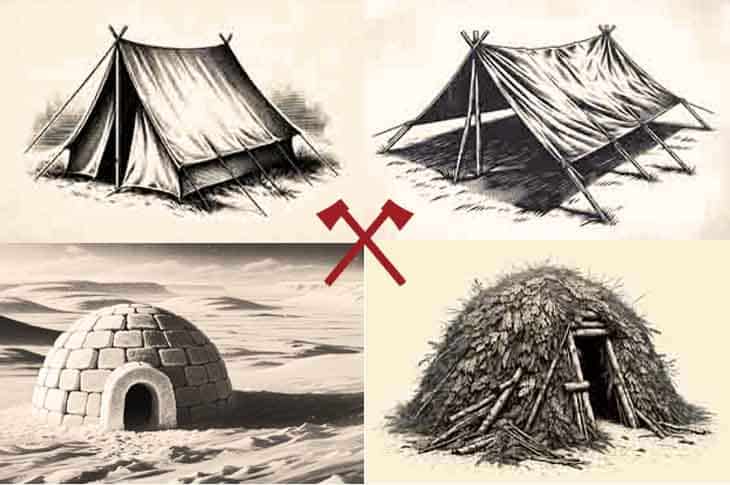
Survival Shelters: Your Complete Guide to Wilderness Shelter Building
When you find yourself stranded off the grid after disaster strikes, reliable survival shelters built from the land can be critical to making it out alive. This comprehensive guide covers various emergency shelter options and techniques to create cover and…
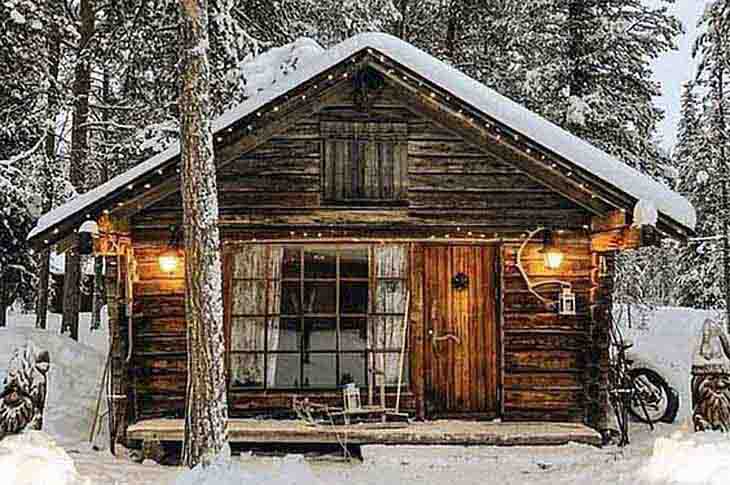
Top 10 Long Term Survival Skills for a Lifetime of Self-Reliance
From building shelter to purifying water, mastering long term survival skills is essential for anyone who wants to be self-sufficient and prepared for anything. Long term survival skills are the backbone of any self-reliant life. When resources are scarce and…

How To Make Your Own Arrows
Bowyers have been making their own arrows for centuries, and there are many reasons why people make their own arrows today. One of the most common reasons is that they want to shoot an arrow that is consistent in weight…

The Ultimate Guide to Urban Survival Skills
Are you prepared to survive in the city when the SHTF? Learn the urban survival skills necessary to thrive in any emergency or civil collapse situation. When it comes to survival, most people think of the great outdoors and their…
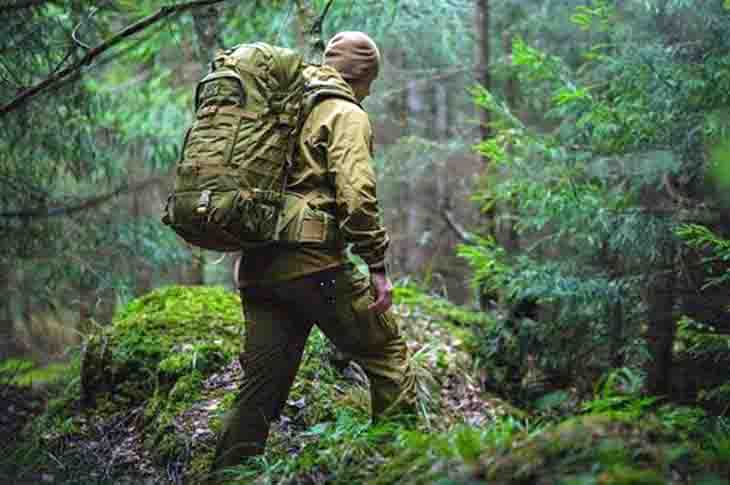
The 13 Essential Survival Skills Every Man Should Know
When the world is on fire, it’s the ones with survival skills who come out on top. In this article, we’ll explore the essential skills every man needs to survive in even the toughest situations. Survival skills – what do…
Home — Essay Samples — Life — Survival — Exploring the Essential Qualities that Help Us Survive
Exploring The Essential Qualities that Help Us Survive
- Categories: Survival
About this sample

Words: 553 |
Published: Sep 5, 2023
Words: 553 | Page: 1 | 3 min read
Table of contents
Resilience and adaptability, resourcefulness and creativity, emotional intelligence, perseverance and determination.

Cite this Essay
Let us write you an essay from scratch
- 450+ experts on 30 subjects ready to help
- Custom essay delivered in as few as 3 hours
Get high-quality help

Verified writer
- Expert in: Life

+ 120 experts online
By clicking “Check Writers’ Offers”, you agree to our terms of service and privacy policy . We’ll occasionally send you promo and account related email
No need to pay just yet!
Related Essays
1 pages / 659 words
4 pages / 1927 words
4 pages / 1970 words
1 pages / 533 words
Remember! This is just a sample.
You can get your custom paper by one of our expert writers.
121 writers online
Still can’t find what you need?
Browse our vast selection of original essay samples, each expertly formatted and styled
Related Essays on Survival
Survival is a basic necessity for all living beings. It is the drive to live and thrive, to sustain oneself and potentially pass on one's genes to future generations. While survival is viewed as a natural and innate desire, is [...]
The Call of the Wild, written by Jack London, is a classic novel that explores the themes of survival, nature, and the instinctual desire for mastery. The story follows the journey of Buck, a domesticated dog who is stolen from [...]
The story of Álvar Núñez Cabeza De Vaca’s survival is a remarkable tale of human resilience in the face of adversity. Cabeza De Vaca, a Spanish explorer, found himself shipwrecked on the coast of what is now Texas in 1528. Over [...]
Brians Winter, written by Gary Paulsen, is a compelling novel that takes readers on a thrilling journey as the protagonist, Brian Robeson, faces the challenges of surviving the harsh winter in the Canadian wilderness. Throughout [...]
tells the gripping tale of two individuals, Salva and Nya, whose lives intertwine in unexpected ways amidst the backdrop of war-torn South Sudan. The novel weaves together their stories of survival, resilience, and hope, [...]
In the deep sea, organisms must be adapted to survive stresses absent in surface waters such as extreme pressure, lack of light, food scarceness, toxic chemical flows and other factors that make it difficult for life to thrive. [...]
Related Topics
By clicking “Send”, you agree to our Terms of service and Privacy statement . We will occasionally send you account related emails.
Where do you want us to send this sample?
By clicking “Continue”, you agree to our terms of service and privacy policy.
Be careful. This essay is not unique
This essay was donated by a student and is likely to have been used and submitted before
Download this Sample
Free samples may contain mistakes and not unique parts
Sorry, we could not paraphrase this essay. Our professional writers can rewrite it and get you a unique paper.
Please check your inbox.
We can write you a custom essay that will follow your exact instructions and meet the deadlines. Let's fix your grades together!
Get Your Personalized Essay in 3 Hours or Less!
We use cookies to personalyze your web-site experience. By continuing we’ll assume you board with our cookie policy .
- Instructions Followed To The Letter
- Deadlines Met At Every Stage
- Unique And Plagiarism Free
Home :: 5 Basic Survival Skills
5 Basic Survival Skills
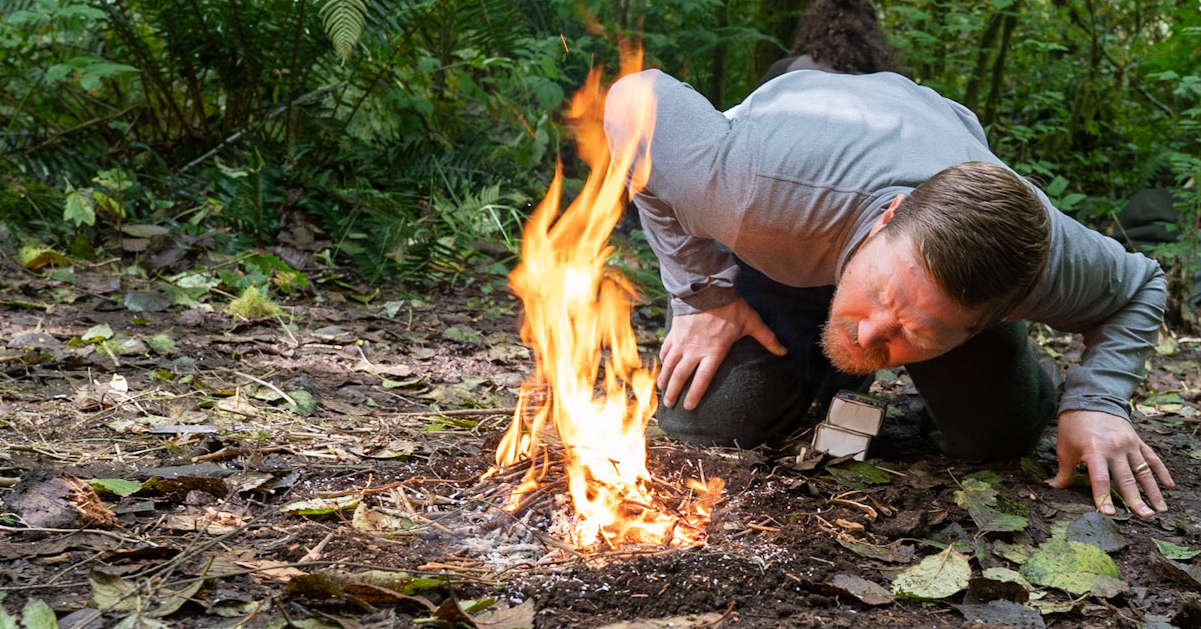
Survival techniques are plentiful, but there are five basic survival skills that everyone who ventures into the outdoors should understand, and be fully aware of their potential need and use. This is just a brief outline, not a full explanation of all the requirements and items required in each category. One of the most important elements of survival is between your ears – your brain. Of all survival techniques, the most important is DO NOT PANIC, use your wits and practice all elements of the five basic survival skills before you may need to rely on them.
Basic Survival Skill 1: Fire
Fire is the king of survival techniques! Fire can purify water, cook food, signal rescuers, provide warmth, light, and comfort. It can also help keep predators at a distance and can be a most welcome friend and companion. As a survival technique, it is one that is essential. Each and every person who ventures into the outdoors should have a minimum of two ways to start a fire with them – one on their person at all times, and the other with their gear. A few small fires provide more heat than one large fire. Collect firewood you think you will need for the night and then collect the same amount again, experience shows you will need it. Conserve fuel by making a “star fire”; where the ends of large logs meet in the fire only, push inward as more fuel is needed. Make a reflector from your space blanket on the back wall of a shelter to reflect the heat from your survival fire to your back, sit between the fire and the back of your shelter wall. To learn how to confidently make fire, check out our Fire Mastery Video Course or Ignite – A Firemaking eBook in our store.
Basic Survival Skill 2: Shelter
Shelter is the survival technique by which you protect your body from excess exposure from the sun, cold, wind, rain, or snow. Anything that takes away or adds to your overall body temperature can be your enemy. Clothing is the first line of shelter protection, have the right clothes for the right environment. Always have a hat. Do whatever you can to keep the layer closest to your body dry. Layers trap air and are warmer than wearing one thick garment. Do not expend energy making a shelter if nature provides one. Practice building a quick lean-to shelter in case you can not find your campsite, do not wait until you need to make one. Use a space blanket to prevent dampness, to insulate your shelter, or to wrap yourself up in a sitting or squatting position to concentrate your body core heat. Learn more about creating a survival shelter with this article from former Immersion instructor Laura Gunion.
Basic Survival Skill 3: Signaling
Signaling is unique among survival techniques in that it gives you the means and ability to alert any and all potential rescuers that you are in need of help. Fire, flashing light, bright color markers, flags, mirrors, whistles can all help you be found. Three fires in a triangular form are a recognized distress signal. Carefully bank your signal fires to prevent the igniting of your surrounding area. Use regular signal mirrors only when you can see a plane, or people in the distance. Use an emergency strobe light at night to help attract attention from those that may be in the area. Make smoky fire with organic material over the fire during the day to attract attention. Lay out ground messages to air signal in an open field, S.O.S. from rocks, logs, or colored clothing, whatever will be seen against the background. Most search and rescue parties use aircraft as a primary method of sighting.
Basic Survival Skill 4: Food & Water
Food and water are vital to your survival. Ration your sweat, not your water intake. You can live up to three days without water. DO NOT eat plants you do not know. Never drink urine. Always assume that you will need extra food and water when you plan your trip. Pack energy bars and candy in your pockets at all times, just in case. If possible boil all water 10 minutes plus one minute for every 1000 feet above sea level. Strain water through your handkerchief to remove large particles. Try to drink only in the cool of the evening. Never wait until you are without water to collect it. Have some poly zip bags to collect and store water. Never eat any wild berries that you cannot identify. You can catch rainwater in your space blanket by laying it out in a trench. Read more with How to Purify Water .
Basic Survival Skill 5: First Aid
First aid as a survival technique is not just the basic medical needs, it is the primary way in which you act to survive. DO NOT PANIC, remain calm, and do what you have to do to take care of yourself. STOP means Sit, Think, Observe, and Plan. It is the most intelligent thing you can do when you realize you are lost or stranded. The most important element is to keep your brain functioning rationally, this is basic first aid for survival. Analyze your needs before every trip, create a medical checklist, and carry a small personal kit with you at all times. Most survival situations require only dressing for small cuts, bruises, and personal medication needs, make sure you know what you have with you and how to use it. Do not overpack, pack what you feel you will need to carry with you at all times. Prevent hypothermia by insulating yourself in a space blanket. Concentrate on being found, pack a picture of your family in with your gear to remind you of the reasons to remain calm, and to survive.
Looking for more? Wilderness Awareness School teaches many weekend workshops centered around survival, including Wilderness Survival Basics which is held in the spring and fall each year. For those looking to become fully immersed in survival skills, naturalist studies, and earth-based resilience, check out The Immersion at Wilderness Awareness School for a nine-month transformative experience.
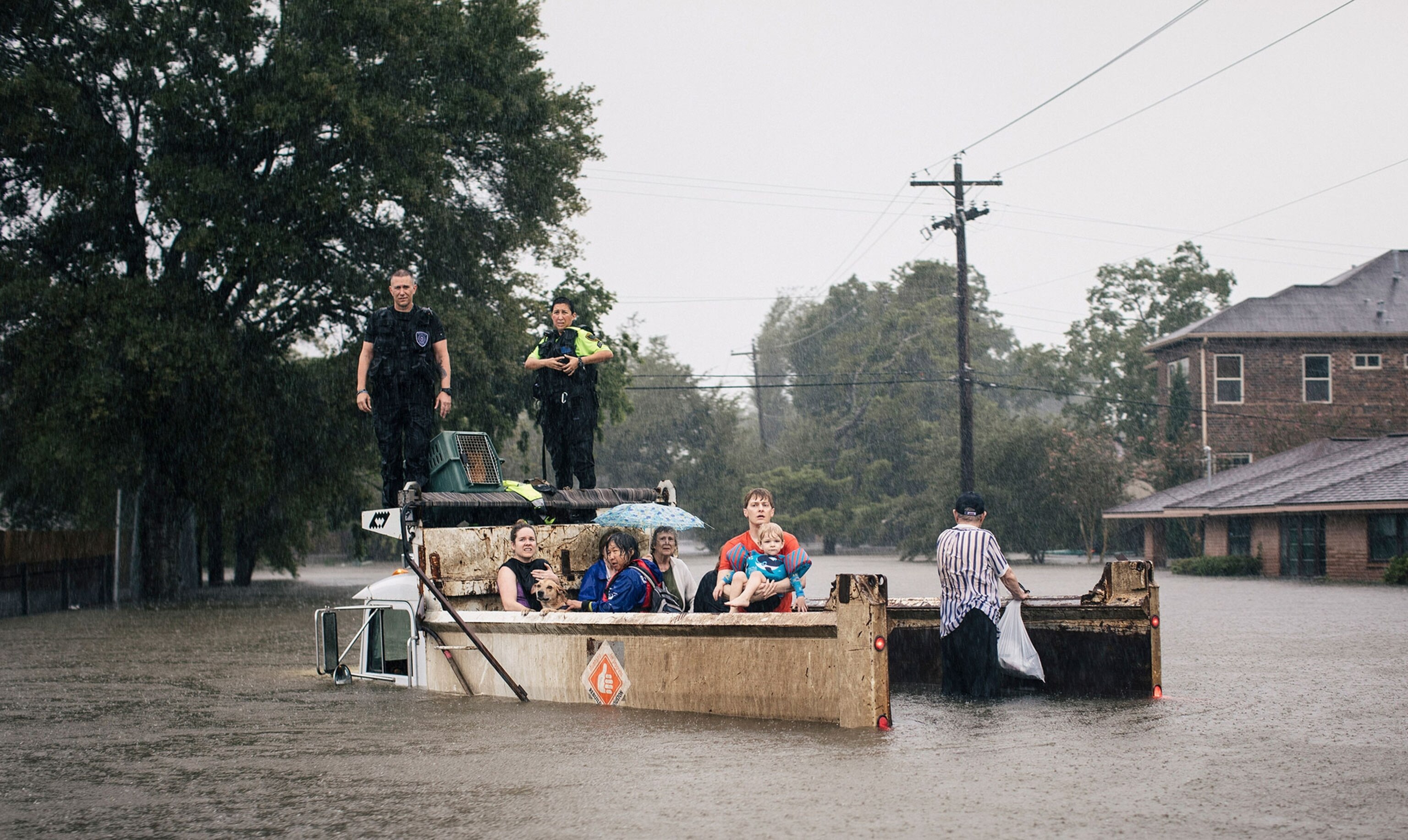
Rescue workers and civilians wait for an emergency crew in Houston, Texas, after Hurricane Harvey. Heavy rainfall from the tropical storm caused severe flooding and the displacement of thousands of residents.
How to Survive a Natural Disaster
Three experts share their tips on withstanding a devastating catastrophe.
Recently the world has seen a barrage of natural disasters: hurricanes in the Caribbean and southern U.S. , earthquakes in Mexico , and monsoons in southern Asia. These events brought devastation to communities and questions around the world about what we can do to help—and to prepare ourselves for similar events.
The safest and best thing to do when facing an approaching natural disaster is to heed your area’s evacuation notices and take advantage of evacuation assistance when it’s offered. It’s possible, however, to be caught by an unexpected emergency or to be unable to leave a disaster-striken region. When faced with those situations, what should you do to stay safe? How can you be better prepared? What kinds of choices will you need to make to survive?
We spoke with three experts— Tim MacWelch , resident survival expert for Outdoor Life Magazine , survival instructor, and author of multiple New York Times bestselling survival manuals ; Warren Faidley , extreme weather photographer, survival expert, and tactical EMT; and Jeff Masters , co-founder and director of meteorology at Weather Underground —about how to survive a disaster when you can’t evacuate. Each one shared tips on preparation, remaining safe during the event, and withstanding its often-dangerous aftermath.
Here are their tips and advice on surviving a natural disaster.
Preparation
What is something people should do far ahead of any disaster to stay prepared.
MacWelch: It's easy to focus on gear and supplies when you start thinking about preparedness, though these aren’t the only things you’d need in an emergency. Every family should have an emergency plan that addresses the most likely disasters in their region. Practical survival skills should also be part of every family’s game plan. These skills need to be learned and practiced before things get tough, because you simply won’t have time to read a survival book or watch a how-to video in the midst of a crisis. Get some first aid training, find out how to cook without utilities, learn to source and disinfect water, figure out different ways to heat and cool at least one room in your home. Learn everything you can, since you never know what might be useful in a disaster.
Learn everything you can, since you never know what might be useful in a disaster. Tim MacWelch , survival expert
Masters: Develop an emergency plan. Figure out where will you meet up if separated, what phone numbers you should have, what supplies you should stockpile.
Faidley: I’ve developed my own three rules over the years. First, know what possible dangers could arise in your area. Second, know what to do for each one of them. And third, don't delay taking action. Those three things will keep you alive.
Hurricane Harvey's Destruction

Necessary Supplies
What should people always have in their homes.
MacWelch: The government guidelines for preparedness supplies are a great foundation for someone to begin disaster prep. The basic list includes drinking water, no-cook food, non-flame light sources (flashlights instead of candles), first aid supplies, and a host of other handy supplies. Again, it’s a great place to start, though I’d encourage everyone to plan further than the recommended 72 hours. Even though many situations are significantly improved in the first 72 hours, some are not. If you’re willing to take your family’s safety seriously, why stop at three days? Stock up a week’s supply of food and water, and you’ll be far better prepared than 90 percent of the population.
Masters: A source of non-grid power. I have solar panels on my roof with a battery-backup. Tesla’s Power Wall is getting to be a good-value source of electrical power, without have to have a diesel generator. Also have a way to purify water. A micro-pore filter sold by camping stores is a good solution.
Faidley: That depends on what kind of money you have. A lot of people just can't afford to buy all the survival things you’d need, but there are some basic things you must have. The first thing is some type of lighting system or flashlight you can use for a week or longer, along with the batteries to run it. People do not realize how important that is until their power is off, and they're stumbling around to find a flashlight that’s 10 years old with corroded batteries inside. There are also solar-powered lanterns you can charge during the day or crank-power, which is even better, because you don't have to leave it out in the elements. Those are good ideas for a secondary source.
They used to say to keep three days of food, but you should have at least a week—and if you can afford it, two weeks—of non-perishable food. Even if you don’t have a big budget, just save a few things every year or two and replace them when their expiration dates come. And water is a big thing. If you can't buy bottled water, fill up everything in your house. Fill up the bathtub. Fill up the sink. Save old water cartons to fill. That way, you won’t have to spend a lot of money on bottled water, and you won't have to worry about going out and finding it, because water disappears quickly.
(Related: Hurricane Safety Tips and Earthquake Safety Tips )
What is something people often don't realize would help them in the event of a disaster?
MacWelch: One of the recommended items on FEMA’s list of home disaster kit items is a battery-powered weather radio. This communication tool (and any other type of portable radio) can provide survivors with lifesaving information, such as emergency broadcasts, evacuation orders, shelter-in-place instructions and much more. While any radio is better than none, a weather radio is the best choice, as it can tune in your local weather radio bands—which are one of your most reliable sources of emergency information.
Another critical thing to have in your survival kit is a battery-powered radio that can receive NOAA Weather Radio broadcasts. Jeff Masters , director of meteorology, Weather Underground
Masters: Cell phones are great, but the towers can go down, so a land line is handy. Another critical thing to have in your survival kit is a battery-powered radio that can receive NOAA Weather Radio broadcasts. Get one that has the feature to alert you when a weather warning is issued for your county.
Faidley: Old-fashioned AM/FM radios, the old ones that use batteries. Information is critical in today's world, and stations will give out information to people: where to get food, where to go for medical assistance, what hospitals are open.
Safety During a Disaster
What's the most important thing a person can do during a natural disaster.
MacWelch: Staying calm is the most important thing a person can do during any emergency. Of course, this is easier said than done in a scary situation, but think of it like this. A little fear is a natural and healthy response to a frightening event. Fear is like an instinct that typically keeps us out of harm’s way. But when fear runs unchecked (this state is commonly known as panic), a person may make irrational, dangerous, or even deadly choices. Staying calm and preventing panic should be a priority for each person during a crisis.
What's something most people forget to consider in those moments?
MacWelch: A lot of people forget to focus on their most basic needs, also known as survival priorities. Human beings don’t need that much to survive. Shelter, water, air, food, security, sleep, medical care, and some semblance of hygiene will keep a person alive for a very long time. But quite often, these basic needs are confused with wants. People want to save possessions and they want to have their normal comforts and entertainment. The “needs” are the only things you need during a crisis, the “wants” need to wait their turn.
Masters: Don’t look after just yourself, see if others need help too.
Faidley: The thing people probably forget most often is that a natural disaster can be a very long-term event. You have to remember, during a hurricane, there's not much you can do about it then. You need to hunker down and be safe, but you have to remember it can be a long time for recovery. You don't know how long it will be before you’ll have power and whatever else you need, so you have to plan in advance. Either evacuate or have enough survival supplies for a week or longer.
The thing people probably forget most often is that a natural disaster can be a very long-term event. Warren Faidley , extreme weather photographer
What dangerous scenarios could arise during these situations that people might not consider?
MacWelch: I mentioned hygiene as one of the basic needs for a person, and it really is a need—not just a nicety. Poor sanitation can allow for the quick transmission of dangerous bacteria in “camp” or group-shelter settings. Something as simple as the lack of a handwashing station at the bathroom can allow hazardous pathogens to spread through a group in 24-48 hours.
Masters: Electrocution from power lines.
Faidley: Believe it or not, in most urban areas, the period after a hurricane is usually the most dangerous. You have fallen trees and some trees that have only partially fallen. You have power lines. You have sharp objects. You have gas leaks. You have broken glass and windows. You may have a boil-water order in your area. During Hurricane Harvey, it was the flooding.
And one of the most dangerous things after a disaster are uncontrolled intersections. People go down the road, and they'll drive right into a major intersection without even stopping. People are upset and not paying attention, and that is really dangerous. It can also be dangerous for children to play in the water, since there could be open manhole covers sucking the water down.
How can you avoid large objects nearby that may be unstable?
Faidley: If you're in the middle of a hurricane, you want to be in the most stable part of a building. You want to stay away from the windows and be in the most interior portion. You want to put as much room between you and any flying or falling debris.
Pets and Animals

A animal rescue volunteer carries a small dog he found abandoned inside a flooded home after Hurricane Harvey. If a natural disaster forces an evacuation, it's best to evacuate with your pets or take them to a shelter.
What should people do with their pets during a disaster?
Faidley: I have a big problem when people tie their pets inside or outside their house. I’ve talked to people who love their pets and tied them up, and they say they thought it was the best way to keep the animal from being washed away or getting hurt. But if you can’t get your pets to shelter or leave them in a room where they’ll be safe, let them roam free. It’s the very last resort, but animals are amazing at surviving storms. They have a wonderful ability to swim and climb trees. The odds of a free animal sheltering themselves is much better than one that is chained. Even if there is no flooding, a chained pet can’t get out of the way of falling debris or could die from exposure.
How can you avoid dangerous animals in the aftermath of the event?
Faidley: Mainly you shouldn't be in that water. There are some search-and-rescue incidents that require it, but it’s pretty uncommon. It's something you can usually prevent. Stay out of the water as much as possible. Most of the time, animals are freaked out and don’t want to bother you.
Food and Water
What should you do if you run out of water.
MacWelch: This situation is quite common. Once the power fails, the water fails soon after. And once all the bottled water is consumed, you’re on your own to procure more. For those who have never sourced their own water before, the task seems scary and mistakes are almost inevitable. But thankfully, there are many ways to gather water and multiple ways to disinfect it. One of the easiest plans is to find the clearest water you can and boil it for 10 minutes to kill any pathogens. Sourcing and disinfecting water is one of the top survival skills that everyone should know how to do, and once you’ve done it—you’ll never forget.
Masters: Keep yourself from sweating by sheltering from the sun and reducing activity. Find groundwater sources near or underneath green vegetation, canyons, dry riverbeds or rocks. Cover as much skin as possible with loose, lightweight clothing. This will trap the sweat against your skin, slowing evaporation and therefore water loss. For this reason, it's probably best to go with a cotton undershirt rather than a wicking fabric. Cover it all with a light windbreaker. Wear a wide-brimmed hat, sunglasses, and gloves.
See if you can get to the water in your home's water heater. There's usually 40-80 gallons of clean water in there. Tim MacWelch , survival expert
Faidley: It will be pretty unusual to not have some type of water. Right after the storm, there's a lot of rainwater around, but you have to use common sense. You can't drink something that's contaminated, though you can buy water purification tablets, use chlorine, or boil water if you have power or gas. Plan ahead. It doesn’t take a lot of water to keep you going if you're not working.
Is it ever safe to drink floodwater?
MacWelch: Well, let me answer your question with a question. Is it ever safe to die of dehydration? Floodwaters are notorious for being a bouillabaisse of muddy water, raw sewage, dead animals, and toxic chemicals. That being said, it may also be the only water you have. Ironically, stranded flood survivors have found themselves praying for more rain—which is a clean and useable source of water. If the rain doesn’t return, see if you can get to the water in your home's water heater. There's usually 40-80 gallons of clean water in there. If you're the MacGuyver type and you know how to improvise any of the different apparatus for distillation, then distill the raw floodwater. Or failing that—boil the water for 10 minutes and drink only enough to maintain a low level of hydration. This limits your exposure to chemical pollution in the floodwaters.
How can people find safe food to eat after a natural disaster?
MacWelch: Regardless of the type of calamity, look for canned food in the wake of a disaster. The label may have fallen away, in which case the can contents will be a surprise, but mystery food is better than no food. Canned goods are surprisingly tough, waterproof, impervious to insects and most animals, and edible whether served hot or cold.
Medical Safety

Volunteer rescue workers in Mexico City have their names, blood type, and telephone numbers written on their arms in case they're caught in an emergency situation and cannot provide the information verbally.
What should you do to prepare for any medical concerns during a natural disaster?
Faidley: You should have everything you'd include in a basic first aid kit. It’s good to have saline solution to wash out wounds and bandages to cover them. Of course, if you have prescriptions, you want to make sure you have extra ones, because you might not be able to get to the pharmacy for a few days or more.
How can you prevent infection to a cut or injury without medical supplies?
- Nat Geo Expeditions
Faidley: It can be hard to find medical attention. During a storm surge or flooding, you can have raw sewage, bacteria, or chemicals in the water, so you want to make sure you flush out any kind of cut. You can use clean water or alcohol, but it’s important to keep those wounds clean. Even the water falling from the sky is ok. You also want to make sure you aren’t stepping into water where you can’t see the bottom, because you could step on a nail or sharp object. Puncture wounds can be really serious, since you can get a bad infection or tetanus.
MacWelch: Ever wonder how the pioneers, colonists, or Native Americans treated their wounds before the advent of the triple antibiotic ointment and Band-Aids? There are dozens of common weeds that can be used as an effective poultice on wounds. These crushed curative roots and mashed medicinal leaves can discourage infection and even speed healing, as beneficial plant compounds soak into the skin. Foraging for edible plants and utilizing medicinal plants are two more skills you should learn and practice before you actually need them.
How do you stay warm when you're wet or exposed to the elements?
MacWelch: One handy survival hack for staying warm is to stuff your clothing with insulating material. This can be crumpled paper, bubble wrap, or even leaves. These lofty materials surround your body with an insulating barrier and prevent the elements from stripping away your body heat so quickly. Sharing body heat is another effective way to stay warm in cold or wet conditions, though it may not be enough. When I get cold, I reach for a hot water bottle or a stone that has been warmed near a fire. Hold it under your clothing or between layers of clothing. As the heat soaks into your body, you’ll feel the chill melting away. This is also a safe and gentle technique to revive hypothermia victims.
Power Outages

Cars drive through Old San Juan, Puerto Rico, after Hurricane Maria destroyed the island's power grid.
What should you do if you don't have a power source for an extended period of time?
MacWelch: Life without power is unimaginable to most modern people, as few people still live who grew up without the warm glow of electricity. My father grew up in a rural area that didn’t join “the grid” until he was eight or nine years old. This may sound romantic to a few, but it would be a living hell to the average tech-addicted first-worlder. So what should you do without power? Learn to cook from scratch, gather firewood for fuel, disinfect your own water—and after a hard day's work—read paper books or play games for entertainment.
Faidley: It depends on where you are and how much infrastructure is around you. If you can get out of your place and go somewhere with power, you’ll be much better off. If you can get away from an area that doesn't have power and go to one that does, you can charge your phone, charge your computer, cool off a little bit, and get some ice. If you’re in an area that’s totally devastated and there's no way you can survive there, you have to leave.
Leaving Home and Getting Rescued
What’s a good place to go if you know you need to leave your home.
Faidley: Airports are good, even if they aren’t running flights, because a lot of times they'll let you in. There will be supplies coming in, and people will see you there and give you supplies. You just have to find a place with some kind of civilization where you can get water and shelter. People gravitate toward shelters, airports, hospitals, or places where you'd expect people to be—anywhere you can go, get a bottle of water, and maybe find some shelter.
People gravitate toward shelters, airports, hospitals, or places where you'd expect people to be. Warren Faidley , extreme weather photographer
What's the best way to alert someone of your need for rescue?
Faidley: After Hurricane Katrina, taking a white sheet and putting it up on your roof has become the new universal signal for help. You can also tear it and make a cross, which air rescues will notice.
Is it best to wait in place for rescue or search for rescue yourself?
Faidley: That depends on a lot of things, especially where you are. It also depends on if you need to move or not, and that's always difficult to tell people. If you think you're not going to be able to survive where you are, if you think there's no hope for water or help, you’re better off trying to gravitate toward where there are other people. Because people are going to help you, in most cases. You just have to know the situation and your physical condition to determine when it's going to be safe to move. There's no easy answer in those situations, because they're all different.
Once things settle down, is there anything people need to continue to consider?
Faidley: There's a lot of scammers after the storms—roofing scams, robbery scams. I advise people to look for a list of contractors that the state has approved to find a legitimate company.
Related Topics
- SURVIVAL SKILLS
- NATURAL DISASTERS
You May Also Like

Can tourism help recovery after a disaster?

2024 hurricane season forecasted to be record-breaking year

Extreme weather is coming for our homes. Experts weigh in on how to prepare.

10 years later, see how Superstorm Sandy changed the Northeast

How many 'natural' disasters can one city endure?

Weather disaster-related deaths are down—warming could undo that trend

Will the supermoon make Hurricane Idalia worse? We asked the experts.
- Paid Content
- Environment
- Photography
- Perpetual Planet
History & Culture
- History & Culture
- History Magazine
- Mind, Body, Wonder
- Terms of Use
- Privacy Policy
- Your US State Privacy Rights
- Children's Online Privacy Policy
- Interest-Based Ads
- About Nielsen Measurement
- Do Not Sell or Share My Personal Information
- Nat Geo Home
- Attend a Live Event
- Book a Trip
- Inspire Your Kids
- Shop Nat Geo
- Visit the D.C. Museum
- Learn About Our Impact
- Support Our Mission
- Advertise With Us
- Customer Service
- Renew Subscription
- Manage Your Subscription
- Work at Nat Geo
- Sign Up for Our Newsletters
- Contribute to Protect the Planet
Copyright © 1996-2015 National Geographic Society Copyright © 2015-2024 National Geographic Partners, LLC. All rights reserved
Basic Skills 101: Survival Techniques
- Print Friendly
What we might think of as survival techniques were just basic life skills for our ancestors. The more I learn about how our forebears lived, the I admire them. While they might be lost in today’s world of smartphones and the Internet, they possessed a far greater wealth of knowledge about the most basic thing in life: survival.
Now don’t get me wrong, I love technology. I think it can be great for so many wonderful things. But everything has its downside, and as our dependence on modern technology has increased, our basic skill set has decreased.
Are you skilled at any of the items mentioned below? Which survival techniques would you most like to learn?
How to Start a Fire
Of the survival techniques necessary to survival, I’d say that finding fresh water and being able to build a fire are paramount, but since the one of the best water purification methods uses fire, I decided I’d start with a video that shows one of the easiest fire-building techniques: the bow drill, or friction technique.
How to Find or Make Drinkable Water
While a man can survive up to three weeks without food, if he goes three or more days without water, he’s pretty much dead. That makes finding or making drinkable water absolutely crucial to basic survival.
There are two kinds of water in the world, fresh water and salt water, and it takes different techniques to make either of them drinkable.
If you can find a clean, fresh water source, great! Now all you need to worry about is purification. Obviously, boiling clean, fresh water will make it drinkable, but if you have access to rocks, sand, leaves or grass and charcoal, you can also make a natural water filter.
Additionally, I love the method of using a well, sometimes called the ‘sip well’ or ‘gypsy well’ method, which involves digging a hole some specific distance from a larger body of water and allowing the earth to do the filtration for you. This method can be used for both fresh and salt water, however, when you’re trying to get fresh water from a salt water environment, you’d need to dig your well about a hundred feet or so from the shore, otherwise you’d risk getting brackish water that could make you very sick. Read more about this and other water collection methods here.
How to Make a Basic Shelter
Once you’ve figured out your fire and water situation, you can get to work building a shelter. And you need a shelter.
A lot of people wonder why the shelter isn’t the first task on the survival to-do list. It’s a reasonable question.
The answer is that fire will provide light and warmth, as well as protection from some dangerous creatures, but it can be tricky to build a fire once it gets dark outside, so it’s something that you’ll want to get started right away.
And water? Well, you’ll die without it.
Once you’ve gotten those things under control, you can relax and build your shelter.
But what kind is best? Well, obviously it depends on the environment.
My favorite kind of natural shelter is a wigwam — hands down. But that may be due to the fact that some of my ancestors were Algonquian Indians from right here in coastal North Carolina, and wigwams were their favorite housing style. Maybe it’s genetic. Anyway, here’s how to construct one .
Basically, it involves using young saplings and lashing them together into a dome shape and then covering them either with leafy branches (in a survival situation) or mats woven from bulrushes and tall grasses (in a more permanent situation).
It might not be the best kind of shelter for every biome, though. Have no fear, MCRP 3-02F FM 21-76 Survival Manual , a free document produced by the United States Army, describes how to build many different kinds of shelters, both natural and employing items like ponchos or blankets. Another great resource is Shelters, Shacks and Shanties by Daniel Carter Beard , available for free on Google Books.
How to Find Food
Foraging, hunting, or fishing. It’s gonna be one of those three things that’s going to get you sustenance.
Look on the bright side. No matter where you find yourself, there are always available energy sources around you.
They might be gross. They might not be very tasty, but whether plant, insect, or animal, there is something to eat just about everywhere.
You just have to identify what that is, and the best way to get it.
If it’s some kind of animal, here is a great video that clearly and easily explains how to make both a bow and arrow, as well as a spear (which can be modified to use for fishing).
I also think it’s a good idea for everyone to study up on what they can forage locally. There might be certain edible wild plants that grow where you live. Chances are (unless you live in a big city), you pass some every day in your own yard, on the way to work, or wherever. For instance, did you know a common weed called plantain can be used for both culinary and medicinal applications ? It’s true.
Dandelions are also edible, as are acorns (although you’ll want to leach out the tannins by crushing and soaking them before you try to eat them). Here is a great article from Mother Earth News on foraging for food . (It mentions grasses, pines, and cattails as often overlooked, but common, food sources found in abundance in nature.)
Could you make it in a survival situation?
We all like to think that we would find a way, but the fact is, many of us are just not very prepared with even with the most basic survival techniques in these modern times. We are far too dependent on all kinds of gadgets and conveniences (like electricity, refrigerators, indoor plumbing and grocery stores!) in order to survive.
Then some of us enjoy studying about these kinds of topics. Whether we’re just fans of traditional lifestyles, camping and bushcrafting, or we just like feeling prepared with survival techniques, we should study all of the options and try to familiarize ourselves with them as much as possible. Then we can hope we never actually need them. ( This is a favorite survival book in our household, by the way .)
Our earliest colonial forebears built a nation from scratch. Think about that for a minute. They came here with nothing but the limited supplies they brought with them from Europe. They had to do some variation on every single topic covered above just to survive. Having a shortcut in the 17th or 18th century often just meant having a metal hand tool to do the job rather than having to craft a tool from scratch.
As a challenge to yourself, why not spend some time watching videos, visiting websites, and reading books about basic survival techniques.
This post originally appeared at my author website, SaraWhitford.com .
Interested in planting a Survival Garden? Click here to learn how to do it and why you should.
Have you seen these?
Ten amazing & unexpected uses of vinegar, are ‘hybrid’ fruits and vegetables genetically modified (gmos), make pizza from scratch, old fashioned buttermilk pie, traditional cranberry sauce – an old-time favorite for the holidays & gift giving, ✨ easy chicken fried rice ✨, chocolate lasagna – a decadent, chocolatey, no-bake favorite dessert, how to make fluffy biscuits – an old-fashioned country recipe, easy lemon chicken piccata, pin it on pinterest.
Survival: An Introductory Essay
- First Online: 15 December 2021
Cite this chapter

- Rudolf Freiburg 3 &
- Gerd Bayer 3
330 Accesses
This introduction emphasizes the multidimensionality of the issue of ‘survival’, which frequently implies complex acts of ethical decisions. First focussing on the ‘survival of individuals’, it studies survival in the context of the philosophy of ‘natural law’, connecting it to mythology and theology. A passage on the ‘survival of groups’ exemplifies the supportive character of ‘team spirit’ in the act of survival. Survival in Holocaust camps illustrates the blurring lines of the ‘ethics of survival’. Discussing the Darwinian notion of the ‘survival of the fittest’ in the camps, ‘survivor’s guilt’ and the depressions and suicides of many survivors, the introduction develops a hypothesis about the ‘dialectics of survival’, arguing that survival often requires a high price. The introduction closes with comments about the Anthropocene, when survival can no longer rest exclusively on anthropocentric principles.
This is a preview of subscription content, log in via an institution to check access.
Access this chapter
- Available as PDF
- Read on any device
- Instant download
- Own it forever
- Available as EPUB and PDF
- Compact, lightweight edition
- Dispatched in 3 to 5 business days
- Free shipping worldwide - see info
- Durable hardcover edition
Tax calculation will be finalised at checkout
Purchases are for personal use only
Institutional subscriptions
Dawkins ( 1989 , 20).
Wilson ( 1976 , 562).
Spencer ( 1884 , 444). This èlan vital , however, should be imagined as a force devoid of any teleological meaning; see Des Pres ( 1976 , 193–194).
See Rosenfield ( 1968 ).
In this book the focus of most analyses will lie on the survival of ‘human’ individuals and partly on that of ‘mankind’.
Of course, this does not concern atheists; see Julian Barnes’s humorous remark in Nothing to be Frightened of on the “fury of the resurrected atheist” ( 2008 , 64).
Elliott ( 2018 , 16).
Elliott ( 2018 , 3).
Elliott ( 2018 , 1).
See Burgess ( 1986 , 6).
See Maechler ( 2001 ).
Kluger ( 2001 , 64).
Kluger ( 2001 , 184–185).
See Kilby ( 2002 ).
Seen in this context, it is precisely the Holocaust which rendered witnessing almost impossible; see Laub ( 1995 , 65).
LaCapra ( 2001 , 42).
Caruth ( 1995 , 4–5).
See Ganteau and Onega ( 2017 , 5).
These two ‘failures’ are discussed by Caruth ( 2003 , 60) and by Gilmore ( 2001 , 6).
See, for example, Wiesel ( 2006 , viii), who in his “Preface” to Night (vii–xv), asks himself why he tells the story of his suffering and comes to the conclusion: “However, having survived, I needed to give some meaning to my survival.”
See Laub ( 1992a , 85).
See also White ( 2016 ).
Felman and Laub ( 1992 , xiv–xv).
LaCapra ( 2001 , 186).
The term was coined by David Rousset; see Horowitz ( 1997 , 33–46). Laub compares the traumatic experience with the qualities of a ‘black hole’; see Laub ( 1992b , 64).
See Levi ( 1996 , 51 and 62).
Améry ( 1986 , 12).
Améry ( 1986 , 13–15).
Améry ( 1986 , 19).
Astonishingly, there is no entry on ‘survival’ in most handbooks of philosophy, including the prestigious Historisches Wörterbuch der Philosophie , a standard work of reference in Germany.
See the online entry on “Survival” on oed.com .
See Elliott ( 2018 , 1 and 4).
This is a vital distinction between suffering prisoners and the ‘Muselmann’ described by various Holocaust survivors; having given up any forms of active life, the Muselmann was doomed to die, with no chance to survive the Nazi camps; see Chap. 2 in Agamben ( 1999 ).
See the chapter by Freiburg in the present volume.
Derrida ( 2007 , 26).
Derrida ( 2007 , 24).
Derrida ( 2007 , 32–33).
Derrida ( 2007 , 51).
Derrida ( 2007 , 52).
See Butler ( 2009 , 1–32).
For this distinction, see Hobbes ( 1986 , 189).
For the new awareness of vulnerability in contemporary society, see Ganteau and Onega ( 2017 ).
Blumenberg ( 1985 ).
For the power of resilience, see Neenan ( 2009 ).
For a discussion of natural law, see also the chapter “Life Interest” in Elliott ( 2018 , 63–82).
See the entry on “Naturrecht” in Ritter, Gründer and Gabriel ( 1984 , 560–623).
Hobbes ( 1986 , 189–190).
See Bacon ( 1974 , 36).
See Krohn ( 1987 , 93–107).
For the pessimistic redefinition of human reason as ‘instrumental rationality’, see Horkheimer and Adorno ( 2017 ).
In most of Defoe’s novels, especially in Robinson Crusoe , the protagonists interpret accidents and misfortunes as divine warnings and signs.
For a philosophical interpretation of the topos ‘the book of nature’, see Blumenberg ( 1986 ).
See Freiburg and Gruss ( 2004 ).
Defoe ( 1986 , 84–88).
See the satirical attack on the syllogism presented to defend the notion of the ‘best of all worlds’ at the end of the novel; Voltaire ( 1947 , 144).
This aspect is also addressed by Vanessa Guignery in her contribution to the present volume.
See the first chapter of McEwan ( 2006 , 1–16).
See Wilson ( 1976 , 547–575).
The actual Corona crisis exemplifies what prices societies all over the world have to pay for security.
See Foucault ( 1994 , 1995 ).
Examples for societies who have given up individual autonomy and changed into a ‘panopticum’ are to be found in dystopias such as Aldous Huxley’s Brave New World (1932), George Orwell’s Nineteen Eighty Four (1949) or, more recently, Dave Eggers’s The Circle (2013).
See McEwan ( 2006 , 14).
McEwan ( 2006 , 14).
For the complex dynamics between groups and ‘masses’, see Canetti ( 2006 ).
Des Pres ( 1976 , 111).
Philip Roth, “A Conversation with Primo Levi”, in Levi ( 1996 , 179–180).
See Levi ( 1996 , 180).
See Wiesel ( 2006 , 110): “In this place, it is every man for himself, and you cannot think of others, not even your father. […] Each of us lives and dies alone.”
See Des Pres ( 1976 , 97).
According to Johannes Ibel, Director of the Historical Department of Flossenbürg Memorial, there are no historical documents which could prove Haft’s report concerning cannibalism in the concentration camp in Flossenbürg.
Levi ( 1996 , 87).
Levi ( 1996 , 88–89).
See Des Pres ( 1976 , 162–163), who passionately refutes this comparison.
See Agamben ( 1998 ).
See Levinas ( 1998 ).
See Des Pres ( 1976 , 51–71).
See Des Pres ( 1976 , 98; 135–136).
See the chapter “This Side of Good and Evil”, in Levi ( 1996 , 77–86).
For an authentic report of this breakdown of morality, see Des Pres ( 1976 , 78–79); see also the horrible torture scene, Chap. 2, of Orwell ( 1989 , 275–298).
Kluger choses the ‘elbow’ as an emblem for this fight for survival and imagined her father, who died on his way to one of the camps, as a man without elbows; see Kluger ( 2001 , 26).
See Freiburg ( 2017 ).
See Haft ( 2006 , 61–62).
See Levi ( 1996 , 89–95).
Des Pres ( 1976 , 6).
Barnes felt just like this after the traumatic loss of his wife; see Barnes ( 2013 , 114–115).
Kluger ( 2001 , 112).
LaCapra ( 2001 , 89). See also the similar description of trauma in Van der Kolk and Van der Hart ( 1995 , 173).
Améry ( 1986 , 20).
See also Butler ( 2009 , 14): “Precariousness implies living socially, that is, the fact that one’s life is always in one sense in the hands of the other.” Ganteau ( 2015 , 8) emphasizes the interferences between the ‘ethics of care’, ‘the theory of alterity’ and ‘feminism’; see also his contribution to the present volume.
Améry ( 1986 , 68).
For the role of ghosts and gothic elements, see the chapter “Ghost Texts” in Ganteau ( 2015 , 100–131).
For the interpretation of postmodernism as an intentional reaction to the Holocaust, see Eaglestone ( 2004 ).
See Kluger ( 2001 , 15–16).
Améry ( 1999 , 109–110).
See also Judith Butler’s highly speculative reflexion on Levi’s ‘suicide’ in Butler ( 2016 ).
See also Des Pres ( 1976 , 10–14).
Kluger ( 2001 , 146).
Kluger ( 2001 , 137–138).
On Adorno’s dictum on art and the Holocaust, see Freiburg and Bayer ( 2009 , 4–6).
See Peli ( 2007 , 249).
See also Schweid ( 2007 , 227).
Wiesel ( 2006 , 34); see also Freiburg ( 2009 ).
Wiesel ( 2006 , 67).
See Wiesel ( 2006 , 65).
Shapira ( 2007 , 45).
Donat ( 2007 ).
Kluger ( 2001 , 65).
Erikson ( 1995 , 186).
See the comments above about Defoe’s Journal of the Plague Year , that is, Defoe ( 1986 , 29–30).
See Elliott ( 2018 , 32).
See Blumenberg ( 1997 ).
Kluger ( 2001 , 151).
Améry ( 1986 , 80).
Améry ( 1986 , 69).
On literary writing on detention centres and the lasting effects on their (former) inmates, see Janet Wilson’s contribution to the present volume.
For a brief history of neoliberalism, which can be defined as a ‘mode of government’, a ‘policy package’ or an ‘ideology’, see Steger and Roy ( 2010 , 11).
Neenan ( 2009 , 3).
See Chandler and Reid ( 2016 , 53; 57; 71; 100).
See Chandler and Reid ( 2016 , 122).
Chandler and Reid ( 2016 , 69).
See Ganteau and Onega ( 2017 , 1–18).
For a discussion of related aspects of the relationship between humanity and the natural environment, see the chapter by Pat Brereton in the present volume.
See “The Last Days of Death” in Harari ( 2017 , 24–34).
Agamben, Giorgio. 1998. Homo Sacer: Sovereign Power and Bare Life . Trans. Daniel Heller-Roazen. Stanford: Stanford University Press.
Google Scholar
———. 1999. Remnants of Auschwitz . Trans. Daniel Heller-Roazen. New York: Zone.
Améry, Jean. 1986 [1980]. At the Mind’s Limits: Contemplations by a Survivor on Auschwitz and its Realities . Trans. Sindey Rosenfeld and Stella P. Rosenfeld. New York: Schocken Books.
———. 1999 [1976]. On Suicide: A Discourse on Voluntary Death . Trans. John D. Barlow. Bloomington: Indiana University Press.
Bacon, Francis. 1974. The Advancement of Learning and New Atlantis . Ed. Arthur Johnston. Oxford: Clarendon Press.
Barnes, Julian. 2008. Nothing to be Frightened of . London: Jonathan Cape.
———. 2013. Levels of Life . London: Jonathan Cape.
Blumenberg, Hans. 1985. Work on Myth . Cambridge: MIT Press.
———. 1986. Die Lesbarkeit der Welt . Frankfurt: Suhrkamp.
———. 1997. Shipwreck with Spectator: Paradigm of a Metaphor for Existence . Trans. Steven Rendall. Cambridge: MIT Press.
Burgess, Anthony. 1986. Introduction. In A Journal of the Plague Year , Daniel Defoe, ed. Anthony Burgess, and Christopher Bristow, 6–19. Harmondsworth: Penguin.
Butler, Judith. 2009. Frames of War: When Is Life Grievable? London and New York: Verso.
———. 2016. Fiction and Solicitude: Ethics and the Conditions for Survival. In Probing the Ethics of Holocaust Culture , ed. Wulf Kansteiner, Todd Presner, and Claudio Fogu, 373–388. Cambridge: Harvard University Press.
Canetti, Elias. 2006. Masse und Macht . Frankfurt a.M.: Fischer.
Caruth, Cathy. 1995. Introduction. In Trauma: Explorations in Memory , ed. Cathy Caruth, 3–11. Baltimore: Johns Hopkins University Press.
Chapter Google Scholar
———. 2003. Parting Words: Trauma, Silence, and Survival. In Acts of Narrative , ed. Carol Jacobs and Henry Sussman, 47–61. Stanford: Stanford University Press.
Chandler, David, and Julian Reid. 2016. The Neoliberal Subject: Resilience, Adaptation and Vulnerability . London: Rowman & Littlefield.
Dawkins, Richard. 1989. The Selfish Gene . Oxford: Oxford University Press.
Defoe, Daniel. 1986. A Journal of the Plague Year . Ed. Anthony Burgess and Christopher Bristow. Harmondsworth: Penguin.
Derrida, Jacques. 2007. Learning to Live Finally: The Last Interview . Houndmills: Palgrave.
Book Google Scholar
Des Pres, Terrence. 1976. The Survivor: An Anatomy of Life in the Death Camps . New York: Oxford University Press.
Donat, Alexander. 2007. Voice from the Ashes: Wanderings in Search of God. In Wrestling with God: Jewish Theological Responses during and after the Holocaust , ed. Steven T. Katz, Shlomo Biderman, and Gershon Greenberg, 275–286. Oxford: Oxford University Press.
Eaglestone, Robert. 2004. The Holocaust and the Postmodern . Oxford: Oxford University Press.
Elliott, Jane. 2018. The Microeconomic Mode: Political Subjectivity in Contemporary Popular Aesthetics . New York: Columbia University Press.
Erikson, Kai. 1995. Notes on Trauma and Community. In Trauma: Explorations in Memory , ed. Cathy Caruth, 183–199. Baltimore: Johns Hopkins University Press.
Felman, Shoshana, and Dori Laub. 1992. Foreword. In Testimony: Crises of Witnessing in Literature, Psychoanalysis, and History , ed. Shoshana Felman and Dori Laub, xiv–xv. New York: Routledge.
Foucault, Michel. 1994. The Order of Things: An Archaeology of the Human Sciences . New York: Vintage.
———. 1995. Discipline and Punish: The Birth of the Prison . New York: Vintage.
Freiburg, Rudolf. 2009. ‘Moments that murdered my God and my Soul’: Der Theodizee-Diskurs im Spiegel ausgewählter Holocaust-Literatur. In Literatur und Holocaust , ed. Gerd Bayer and Rudolf Freiburg, 111–139. Würzburg: Königshausen & Neumann.
———. 2017. ‘Fighting Trauma’: Silencing the Past in Alan Scott Haft’s Harry Haft: Survivor of Auschwitz, Challenger of Rocky Marciano . In Traumatic Memory and the Ethical, Political and Transhistorical Functions of Literature , ed. Susana Onega, Constanza del Río, and Maite Escudero-Alías, 137–151. London: Palgrave.
Freiburg, Rudolf, and Gerd Bayer. 2009. Einleitung: Literatur und Holocaust. In Literatur und Holocaust , ed. Gerd Bayer and Rudolf Freiburg, 1–38. Würzburg: Königshausen und Neumann.
Freiburg, Rudolf, and Susanne Gruss, eds. 2004. “But Vindicate the Ways of God to Man”: Literature and Theodicy . Tübingen: Stauffenburg.
Ganteau, Jean-Michel. 2015. The Ethics and Aesthetics of Vulnerability in Contemporary British Fiction . New York: Routledge.
Ganteau, Jean-Michel, and Susana Onega. 2017. Introduction. In Victimhood and Vulnerability in 21st Century Fiction , ed. Jean-Michel Ganteau and Susana Onega, 1–18. New York: Routledge.
Gilmore, Leigh. 2001. The Limits of Autobiography: Trauma and Testimony . Ithaca: Cornell University Press.
Haft, Alan Scott. 2006. Harry Haft: Auschwitz Survivor, Challenger of Rocky Marciano . Syracuse: Syracuse University Press.
Harari, Yuval Noah. 2017. Homo Deus: A Brief History of Tomorrow . London: Vintage.
Hobbes, Thomas. 1986. Leviathan . Harmondsworth: Penguin.
Horkheimer, Max, and Theodor W. Adorno. 2017. Dialektik der Aufklärung , ed. Gunnar Hindrichs. Berlin: de Gruyter.
Horowitz, Sara R. 1997. Voicing the Void: Muteness and Memory in Holocaust Fiction . Albany: State University of New York Press.
Kilby, Jane. 2002. The Writing of Trauma: Trauma Theory and the Liberty of Reading. New Formations: A Journal of Culture / Theory / Politics 47: 217–230.
Kluger, Ruth. 2001. Still Alive: A Holocaust Girlhood Remembered . New York: The Feminist Press at The City University of New York.
Krohn, Wolfgang. 1987. Francis Bacon . München: Beck.
LaCapra, Dominick. 2001. Writing History, Writing Trauma . Baltimore: Johns Hopkins University Press.
Laub, Dori. 1992a. An Event without a Witness: Truth, Testimony, and Survival. In Testimony: Crises of Witnessing in Literature, Psychoanalysis, and History , ed. Shoshana Felman and Dori Laub, 75–92. New York: Routledge.
———. 1992b. Bearing Witness of the Vicissitudes of Listening. In Testimony: Crises of Witnessing in Literature, Psychoanalysis, and History , ed. Shoshana Felman and Dori Laub, 57–74. New York: Routledge.
———. 1995. Truth and Testimony: The Process and the Struggle. In Trauma: Explorations in Memory , ed. Cathy Caruth, 61–75. Baltimore: Johns Hopkins University Press.
Levi, Primo. 1996 [1958]. Survival in Auschwitz: The Nazi Assault on Humanity . New York: Simon & Schuster.
Levinas, Emmanuel. 1998. Totality and Infinity: An Essay on Exteriority . Trans. Alphonso Lingis. Pittsburgh: Duquesne University Press.
Maechler, Stefan. 2001. The Wilkomirski Affair: A Study in Biographical Truth . New York: Schocken Books.
McEwan, Ian. 2006. Enduring Love . London: Vintage Books.
Neenan, Michael. 2009. Developing Resilience: A Cognitive-Behavioural Approach . New York: Routledge.
Orwell, George. 1989 [1949]. Nineteen Eighty-Four . London: Penguin.
Peli, Pinchas. 2007. Borderline: Searching for a Religious Language of the Shoah. In Wrestling with God: Jewish Theological Responses during and after the Holocaust , ed. Steven T. Katz, Shlomo Biderman, and Gershon Greenberg, 245–262. Oxford: Oxford University Press.
Ritter, Joachim, Karlfried Gründer, and Gottfried Gabriel, eds. 1984. Historisches Wörterbuch der Philosophie . Vol. 6. Darmstadt: WBG.
Rosenfield, Leonora Cohen. 1968. From Beast Machine to Man Machine: Animal Soul in French Letters from Descartes to La Mettrie . New York: Octagon Books.
Schweid, Eliezer. 2007. Is the Shoah a Unique Event? In Wrestling with God: Jewish Theological Responses during and after the Holocaust , ed. Steven T. Katz, Shlomo Biderman, and Gershon Greenberg, 219–229. Oxford: Oxford University Press.
Shapira, Kalonymous Kalman. 2007. Holy Fire. In Wrestling with God: Jewish Theological Responses during and after the Holocaust , ed. Steven T. Katz, Shlomo Biderman, and Gershon Greenberg, 40–50. Oxford: Oxford University Press.
Spencer, Herbert. 1884. The Principles of Biology . New York: Appleton.
Steger, Manfred B., and Ravi K. Roy. 2010. Neoliberalism: A Very Short Introduction . Oxford: Oxford University Press.
Van der Kolk, Bessel A., and Onno Van der Hart. 1995. The Intrusive Past: The Flexibility of Memory and the Engraving of Trauma. In Trauma: Explorations in Memory , ed. Cathy Caruth, 158–182. Baltimore: Johns Hopkins University Press.
Voltaire. 1947. Candide or Optimism . Trans. John Butt. London: Penguin.
White, Hayden. 2016. Historical Truth, Estrangement, and Disbelief. In Probing the Ethics of Holocaust Culture , ed. Claudio Fogu, Wulf Kansteiner, and Todd Presner, 53–71. Cambridge: Harvard University Press.
Wiesel, Elie. 2006 [1985]. Night . Trans. Marion Wiesel. London: Penguin.
Wilson, Edward O. 1976. Sociobiology: The New Synthesis . Cambridge: Belknap Press of Harvard University Press.
Download references
Author information
Authors and affiliations.
University of Erlangen-Nuremberg, Erlangen, Germany
Rudolf Freiburg & Gerd Bayer
You can also search for this author in PubMed Google Scholar
Corresponding author
Correspondence to Gerd Bayer .
Editor information
Editors and affiliations.
Rudolf Freiburg
Rights and permissions
Reprints and permissions
Copyright information
© 2021 The Author(s), under exclusive license to Springer Nature Switzerland AG
About this chapter
Freiburg, R., Bayer, G. (2021). Survival: An Introductory Essay. In: Freiburg, R., Bayer, G. (eds) The Ethics of Survival in Contemporary Literature and Culture. Palgrave Macmillan, Cham. https://doi.org/10.1007/978-3-030-83422-7_1
Download citation
DOI : https://doi.org/10.1007/978-3-030-83422-7_1
Published : 15 December 2021
Publisher Name : Palgrave Macmillan, Cham
Print ISBN : 978-3-030-83421-0
Online ISBN : 978-3-030-83422-7
eBook Packages : Literature, Cultural and Media Studies Literature, Cultural and Media Studies (R0)
Share this chapter
Anyone you share the following link with will be able to read this content:
Sorry, a shareable link is not currently available for this article.
Provided by the Springer Nature SharedIt content-sharing initiative
- Publish with us
Policies and ethics
- Find a journal
- Track your research

Survival Skills
Survival skills Survival skills are techniques a person may use in a dangerous situation (e.g. natural disasters) to save themselves or others (see also bushcraft). Generally speaking, these techniques are meant to provide the basic necessities for human life: water, food, shelter, habitat, and the need to think straight, to signal for help, to navigate safely, to avoid unpleasant interactions with animals and plants, and for first aid. In addition, survival skills are often basic ideas and abilities that ancient humans had to use for thousands of years, so these skills are partially a reenactment of history. Many of these skills are the ways to enjoy extended periods of time in remote places, or a way to thrive in nature. Some people use …show more content…
Recent thinking is that boiling or commercial filters are significantly safer than use of chemicals, with the exception of chlorine dioxide.[6][7][8] The issues presented by the need for water dictate that unnecessary water loss by perspiration be avoided in survival situations. To thus avoid these problems, culinary root tubers, fruit, edible mushrooms, edible nuts, edible beans, edible cereals or edible leaves, edible moss, edible cacti and algae can be searched and if needed, prepared (mostly by boiling). With the exception of leaves, these foods are relatively high in calories, providing some energy to the body. Plants are some of the easiest food sources to find in the jungle, forest or desert because they're stationary and can thus be had without exerting much effort.[9] Also, many commentators discuss the knowledge, skills, and equipment (such as bows, snares and nets) necessary to gather animal food in the wild through animal trapping, hunting, fishing. Some survival books promote the "Universal Edibility Test".[10] Allegedly, one can distinguish edible foods from toxic ones by a series of progressive exposures to skin and mouth prior to ingestion, with waiting periods and checks for symptoms. However, many other experts including Ray Mears and John Kallas[11] reject this method, stating that even a small amount of some "potential foods" can cause physical discomfort, illness, or death. An additional step called the
The 10 Habits Of Highly Successful Survivors
The fairytale, “Hansel and Gretel” by the Grimm Brothers, is about two children who are left in the woods by their parents. While looking for a way back home, Hansel and Gretel stumble upon a house made of candy. That house is owned by a witch who eats children. Before being eaten, they outsmart the witch and escape, eventually finding their way back home. In the article, “ Habits of Highly Successful Survivors” by Laurence Gonzales, the author describes the 10 habits of highly successful survivors. In the fairytale, there is one character that is an effective survivor. That character is Hansel. He shows the survivor traits “take action” to trick the witch and to find the way back home and the “stay calm” trait to help comfort Gretel.
Essay On The Sinking Of The Uss Indianapolis
Without fresh water to drink, you experience an unimaginable thirst. The survivors in the water
Explain Why We Need To Survive
Survival for me means to survive. It means that you get to have another chance in life. It means that you have to use your knowledge to stay alive. I think it also means to live through something that was
Summary Of Survival By The Numbers By Peter Kemmerfeldt
In Survival by the Numbers by Peter Kummerfeldt he talks about some of the thing people have to have to survive in the wilderness. The article was very informational and told
An Essay On Hatchet By Gary Paulsen
Bear Grylls once said “Survival can be summed up in three words Never Give Up, that's the heart of it really, just keep trying.” Skills can be used in everyday life; math skills when you are at the grocery store or restaurant, and grammar skills when addressing people. Another set of skills that can be useful are survival skills if you are stuck in a life or death situation. In the award-winning novel, “Hatchet” by Gary Paulsen, Brain has to learn how to use his tools to survive in the for example how to uses the fire as guard, how he strives to kill the animals, and how the tools help him kill the animals.
Anne Frank Survival
- 1 Works Cited
Survival is living on the hope that better things are yet to come in your life. Right now in our country people survive because of hope and the belief that people are good and they will help them out. People survive when they are homeless on the streets only because of the people who are good at heart and give them food or money to buy clothing for the winter. Gerta survived because of her family and friends. Anne Frank survived because she believed that “Despite all the evil going on in the world I still believe that all people are good at heart.”
The Hatchet Quotes
Survival is number 1 in the book hatchet. Brian has to learn how to survive out in the forest where his plane crashed. He has to learn how to hunt, build a shelter, and find a good stream of water that is clean. The common thing is to keep a good mindset
The Good Run, Mamere, Paul, And Abital
In order to survive, people have been known to go to great lengths to which people will go in order to ordinarily do. Survival to me means that to live or exist, typically in spite of an accident, ordeal, or difficult circumstances. “The good lie” (the film), ZombieLand (the movie), and the movie Dorry, all three movies experience a difficult obstacle to face for survival.
Compound Bow Vs Hunting
The hunters families depended on them for survival, they hunted animals and gathered wild plants for their sustenance (Time Maps). People not just acquired meat from the animals but they used the whole carcass. The animal’s pelt (or hide) was used for clothing or blankets, and the bones could be manipulated into a multitude of different tools, such as, shovels, needles, musical instruments, fish hooks, spoons, and knives. Food and tools were the two major driving factors behind hunting; an argument could be made that they killed for protection. That a dangerous animal was endangering the group, but that animal would just turn into food and
Thomas Jukes
These humans used complex hunting tools and techniques to stalk and kill the targeted pray. The precise planning that went into hunting large game consisted of technological advances in the production of tools used to kill, and the cooperation of a group to obtain the game. The adoption of hunting strategies presented humans with daily reliable access to essential proteins and other micronutrients. The animals also proved to be easier to digest and contained more calories, which gave humans more energy to continue hunting these large

Bushcraft Research Paper
A bushcraft survivalist does not simply rely on tools and a few tricks to keep themselves
Surviving Process Analysis
One of the worst things that can happen in a survival situation is not being prepared. There are two ways you can not be prepared the first is with knowledge the second is not being supplied. When one is not prepared the elements can quickly take their life. Depending on what part of the world you are in animals can are a large danger. Hear are some examples the rattlesnake,bobcat,mountain lion and coyotes. If this is not scary enough then consider starving or dying of dehydration. One way to fix all of this is to be prepared with knowledge. What i mean if you know how to use the great outdoors to your advantage it can help you to survive. A example of this is making a shelter and fire with nothing but bear hand and a shoelace. This is the only solution to not being prepared
Persuasive Hunting Research Paper
All over the world, people have hunted for thousands of years. From the lions and rhino in Africa to the whitetail and hogs across the United States, people have always been right there watching them and planning their next move. The reasons behind their hunting have varied over the years. Before, hunting was required for survival and every piece of a harvested animal would be utilized. Today, there are still people who hunt for that reason, but the thought of hunting has become more of a sport. Considering hunting as a sport, hunters can be organized by the reason for hunting pleasure, necessity, and trophy.
Survival Is The Key Struggle
Survival is the key struggle in The Shawshank Redemption. This film takes place in the corrupt Shawshank State Penitentiary where mental and physical abuses inflicted upon prisoners are the hard realities of the system. For the prisoners of Shawshank, life is often bleak and violent. However, the will to survive is what keeps the characters motivated to retain their humanity and challenge the institutionalization of Shawshank. In particular, the film’s main protagonists, Andy Dufresne and Ellis “Red” Redding, exemplify the struggle for survival in the face of a corrupt, frightening, and oppressive prison system. In order to survive the harsh realities of the world, people adapt with personal traits like courage and resourcefulness in addition to forming community with other people.
The Mbuti Pygmies in the Ituri Forest Essay
- 8 Works Cited
In addition they gather and trade with the local villagers for items other than meat.
Related Topics
- Survival skills
- Survival kit
- Survivalism
My Learning Springboard
School Planning | Academic Tutoring | Test Preparation
A Multidisciplinary Educational Consulting Firm
More results...
7 Survival Skills for 21st Century Students
October 18, 2020 Brad Hoffman Leave a Comment

So frequently, parents and teachers get caught up in short term education problem solving . Parents and teachers, naturally, become narrowly focused on an upcoming standardized test or the content demands of a particular course or grade level. In fact, we see this happen at every type of school–public, charter, and private. However, if we all take a step back, and spend some time in the helicopter rather than the blender, we can see what really matters. This reflection rarely happens for a teacher working in isolation. In order to effectively assess one’s teaching practice and raise the bar on teaching and learning, educators must work collaboratively and constructively , a model that happens much less frequently than you might imagine, even at the most elite schools.
Since learning is a lifelong journey , our goal as educators must be to help our students meet the demands of today’s world – with consideration for these 7 survival skills – while also helping students to remain engaged, motivated, and curious . Learning should be meaningful and applicable. Two of the most important skills we can help our children master is the ability to research and communicate effectively, both verbally and in writing. At all grade levels, we need to stretch our children’s ability to think critically, synthesize information, and present their findings . When we tutor students at My Learning Springboard, we consider the investment in lifelong skills and use each assignment as an opportunity to develop these competencies. We never lose sight of our role as mentors.
7 Survival Skills For 21st Century Students
From Tony Wagner’s website:
CRITICAL THINKING AND PROBLEM SOLVING
“The idea that a company’s senior leaders have all the answers and can solve problems by themselves has gone completely by the wayside…The person who’s close to the work has to have strong analytic skills. You have to be rigorous: test your assumptions, don’t take things at face value, don’t go in with preconceived ideas that you’re trying to prove.” —Ellen Kumata, consultant to Fortune 200 companies
COLLABORATION ACROSS NETWORKS AND LEADING BY INFLUENCE
“The biggest problem we have in the company as a whole is finding people capable of exerting leadership across the board…Our mantra is that you lead by influence, rather than authority.” —Mark Chandler, Senior Vice President and General Counsel at Cisco
AGILITY AND ADAPTABILITY
“I’ve been here four years, and we’ve done fundamental reorganization every year because of changes in the business…I can guarantee the job I hire someone to do will change or may not exist in the future, so this is why adaptability and learning skills are more important than technical skills.” —Clay Parker, President of Chemical Management Division of BOC Edwards
INITIATIVE AND ENTREPRENEURSHIP
“For our production and crafts staff, the hourly workers, we need self-directed people…who can find creative solutions to some very tough, challenging problems.” —Mark Maddox, Human Resources Manager at Unilever Foods North America
EFFECTIVE ORAL AND WRITTEN COMMUNICATION
“The biggest skill people are missing is the ability to communicate: both written and oral presentations. It’s a huge problem for us.” —Annmarie Neal, Vice President for Talent Management at Cisco Systems
ACCESSING AND ANALYZING INFORMATION
“There is so much information available that it is almost too much, and if people aren’t prepared to process the information effectively, it almost freezes them in their steps.” —Mike Summers, Vice President for Global Talent Management at Dell
CURIOSITY AND IMAGINATION
“Our old idea is that work is defined by employers and that employees have to do whatever the employer wants…but actually, you would like him to come up with an interpretation that you like—he’s adding something personal—a creative element.” —Michael Jung, Senior Consultant at McKinsey and Company
Leave a Reply Cancel reply
Your email address will not be published. Required fields are marked *
Notify me of follow-up comments by email.
Notify me of new posts by email.
ISAAGNY-Logo

Company Overview
School Planning
Private Tutoring
Test Preparation

Understanding Water Survival
Kyle Howington 1/25/24 7:18 PM
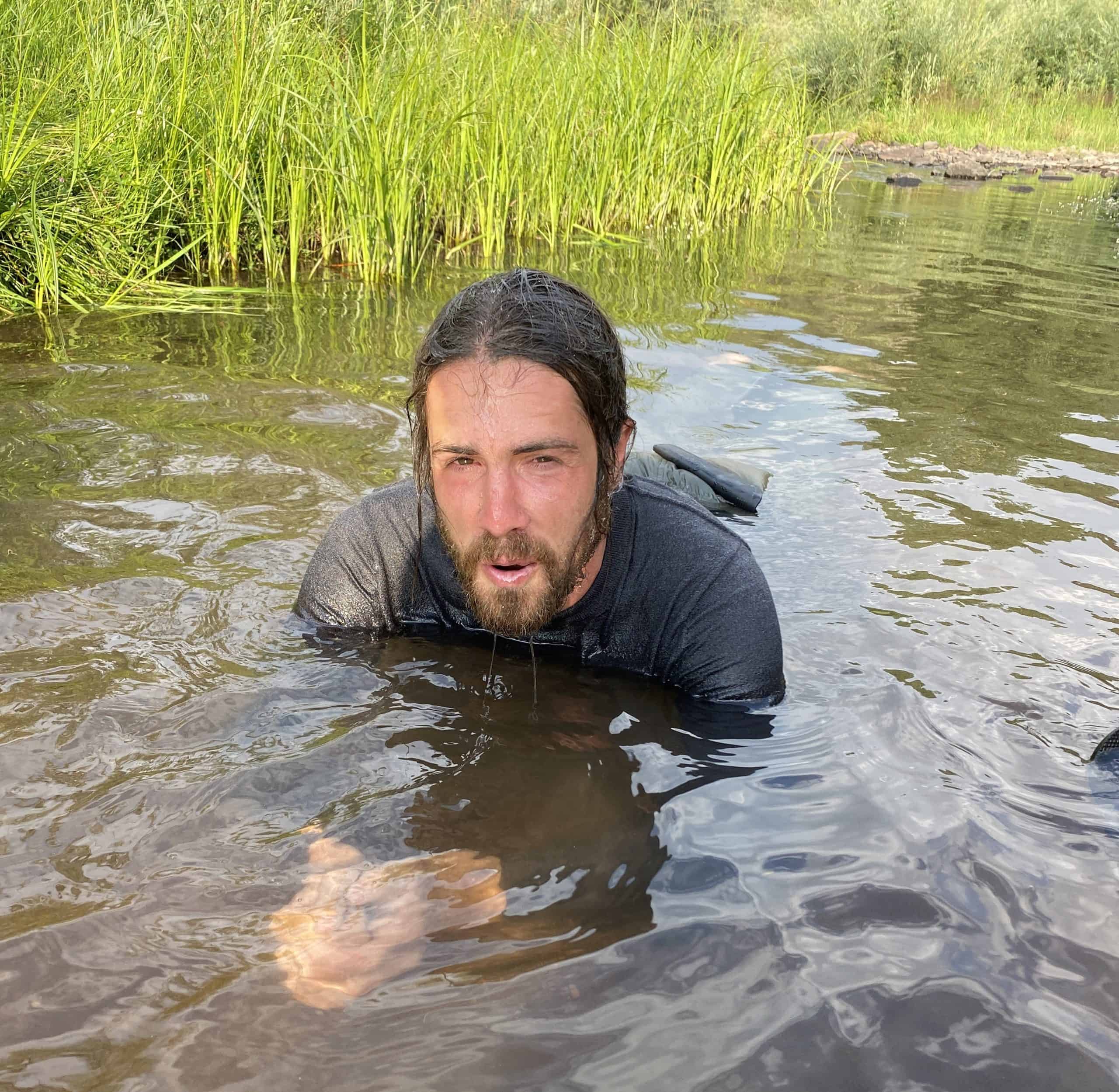
Water is both friend and foe. Even though sips from a cold spring can be refreshing during a hike, being immersed in water can be dangerous for various reasons. It’s best to be prepared for all water related disasters. Weather it’s ending up in a frigid lake, escaping a sinking vehicle, or surviving a flood, understanding water survival is important for everyone.
Remember the 1-10-1 Rule for Cold Water Survival
Water immersion can be dangerous in waters under 60℉, and the body’s cold shock will be as intense at the that temperature as it would be at 35℉. Therefore, anyone who recreates or works around cold water should remember the 1-10-1 Rule . Essentially, after cold water immersion you have about 1 minute of cold shock and then roughly 10 minutes before hypothermia sets in to cause death after about 1 hour .

This stage can actually be as long as 2-3 minutes, and it’s a good idea to be mentally and physically prepared for it with prior training.
It’s important to remain calm and use higher level cognition to control breathing. This is the key to survival in the first few minutes of cold water immersion.
Controlling the Effects of Cold Shock
During this first stage of cold water immersion, the body reacts by hyperventilating. Unfortunately, this is when many cold water deaths occur since even strong swimmers can inhale water if not prepared for the cold water shock.
Pursed Lip breathing is a good technique for regulating air intake to regain control of the body. Simply focus on taking long, deep breaths with pursed lips until the breath is under control.
Cold Water Acclimation

According to Adverse situations researcher Mike Tipton , “ On immersion, unhabituated people assume a fetal position, shiver violently in an attempt to maintain deep body temperature, and are very uncomfortable .” This fact highlights the need for survival preparation with breathing techniques and cold water exposure.
Wim Hof , also known as the IceMan, has developed a progressive technique of cold tolerance that every survivalist should look into. Safely exposing oneself to cold water is a serious consideration for survival preparation.

This phase may be 5-15 minutes long, but occurs after the body has acclimated enough for hyperventilating to stop. If boating, wear a life jacket to increase survival chances since arms and legs will stop working as hypothermia sets in.
Self-Rescue From Cold Water Immersion
If you have fallen through ice , kick your legs to swim back onto a surface, and remember to get out the same direction that you came in. Once out of the water, it’s important to remain on your hands and knees to distribute body weight and decrease your risk of breaking the ice.
If Self-Rescue Fails
Get as much of your body out of water as possible to avoid hypothermia. This might mean planting arms in a way to freeze them to the ice to avoid sinking, or finding debris to help stay afloat. The idea is to avoid sinking and drowning once you become unconscious.
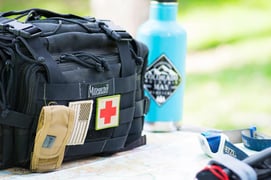
If wearing a life jacket in open water, conserve body heat by remembering HELP :
- E scape

In as little as 45 minutes at water temperatures below 35℉, death from hypothermia can occur. This time frame can be prolonged somewhat, but unconsciousness will have set in by 15 minutes after cold water immersion.
Rescuing a Cold Water Victim
The only hope at this stage is assisted rescue, and even then survival is not guaranteed. A strong rope with a simple slipknot can be secured around the victim’s body underneath their armpits to pull them out. It is important that rescuers keep their safety in mind by not falling into water or through ice themselves.
Making a Hypo Wrap
If you find someone who is unconscious from cold water immersion, it’s important to act quickly to mitigate the effects of hypothermia. It’s best to put them in a hypo-wrap :
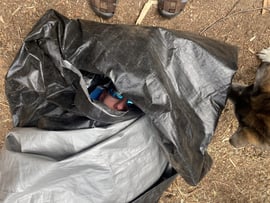
- Lay out a tarp
- Place padding on the tarp
- Stack 3 sleeping bags on pad
- Replace victim’s wet clothes with dry ones
- Place victim in the middle sleeping bag
- Put hot water bottles in armpits/ crotch
- Wrap them up in the tarp like a burrito
- Get the victim to a hospital
Surviving Vehicle Submersion
8-10% of drownings in the US occur in vehicles, so knowing how to act quickly and correctly is important for survival in these situations. Vehicles will float for about 1 minute before taking on enough water to sink, and appropriate behavior in this short time is crucial.
Remember these four priorities to safely escape a vehicle in water:
- Remove seat belts IMMEDIATELY
- Break or lower your window
- Get children into the front seat
- Escape through the window
Use Windows to Escape Sinking Vehicles

It’s always important to carry a reliable center punch or window breaker in your vehicle. Don’t count on escaping through doors since water pressure will make it impossible to open car doors. Water pressure can also slam doors shut as a vehicle sinks, so the best bet is to always escape sinking vehicles through a rolled down or broken window.
How to Survive a Flood
Floods are the number one cause of weather-related death in the United States. Being prepared is important since flooding occurs in every U.S. state and territory. Anywhere it rains, it floods.
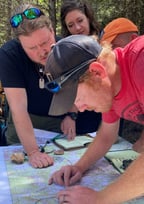
Make a Flood Plan
Being prepared is the most effective way to survive any disaster. Putting together a flood plan is important, and there are many ways to go about this task.
Get to Higher Ground
Getting to higher ground is important when escaping flood waters. In regions like the Colorado Rockies , this can be done by climbing mountains and hills when heavy rain poses a threat. In urban areas, finding refuge on building and vehicle roofs is a common strategy.
Have a Bug-Out Bag in Case of Evacuation
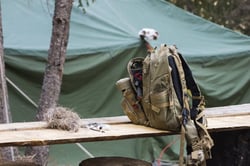
It’s always a good idea to have a bugout bag ready for adverse situations. If you live in an area that is prone to flooding, be vigilant and always ready to evacuate in case a flood occurs. Having a preparation kit will make escaping disasters more efficient, safe, and comfortable.
How to Survive Floodwaters
Do not try to cross floodwaters, no matter how slow or shallow they may seem. If you do find yourself caught in a flood, swim against the current with your feet pointed downstream while staying on your back with your face above water. Grab onto debris if available, and keep feet at or above water level to avoid them getting caught.
Spending time outdoors incurs certain risks, and some of these can be mitigated by understanding water survival before hand. Get training, and remember these things when it comes to water survival:
- The 1-10-1 will help you overcome cold shock in cold water survival situations.
- Break windows to escape sinking vehicles within the the first minute of immersion.
- Have plans for surviving floods and get to higher ground to avoid flood waters.
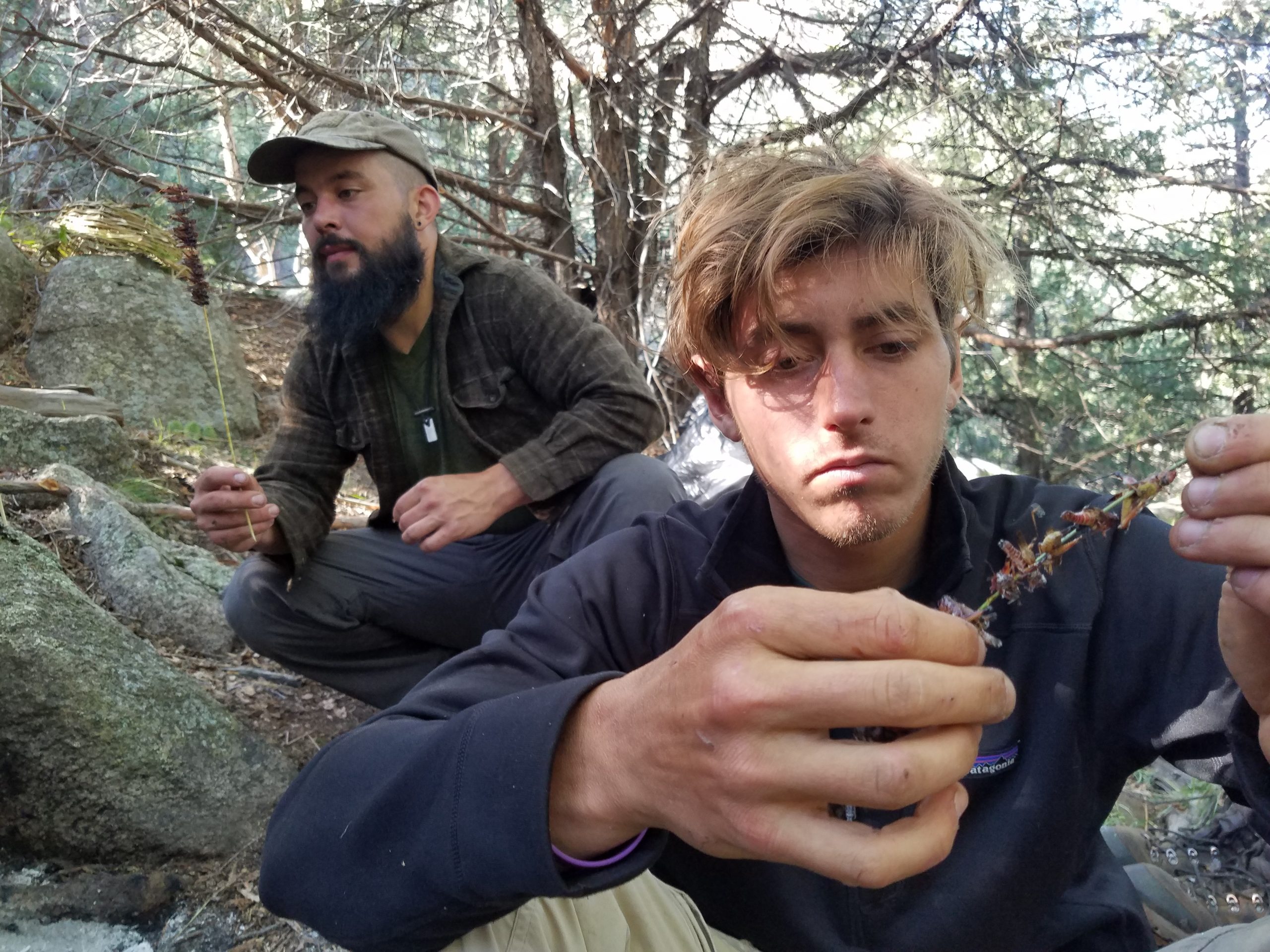
Survival Psychology and Creating a Survivalist Mindset
Having a well developed survival mindset can be the difference between living and dying during and after a disaster. The field of survival psychology...
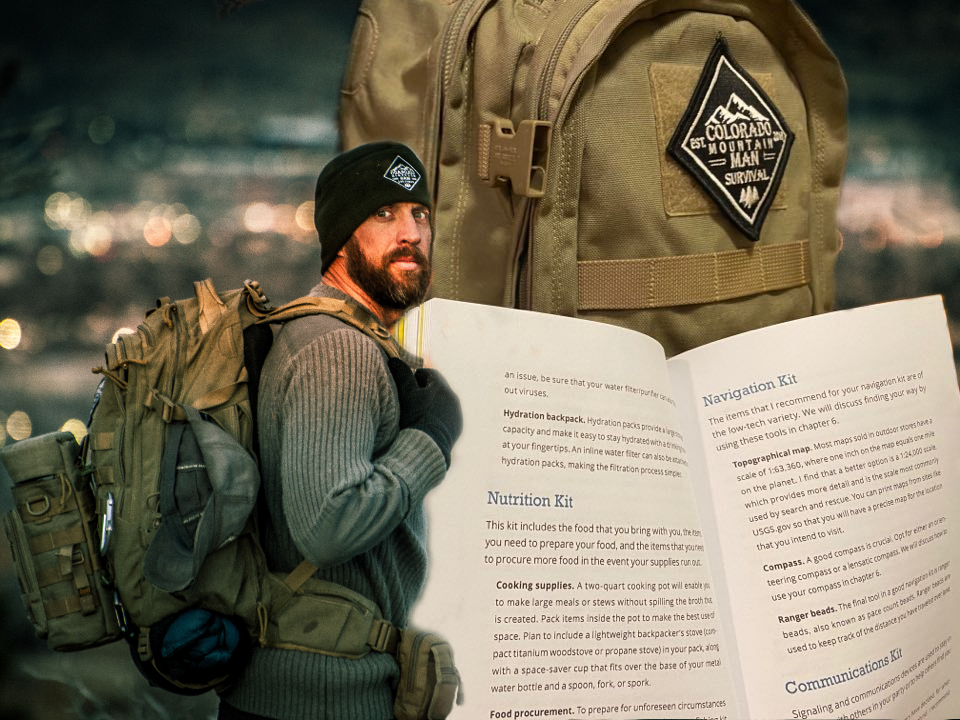
Analogy of a Survival Kit
Analogy of a Survival Kit Survival kits are portable packages containing essential items and supplies that are designed to help individuals survive...
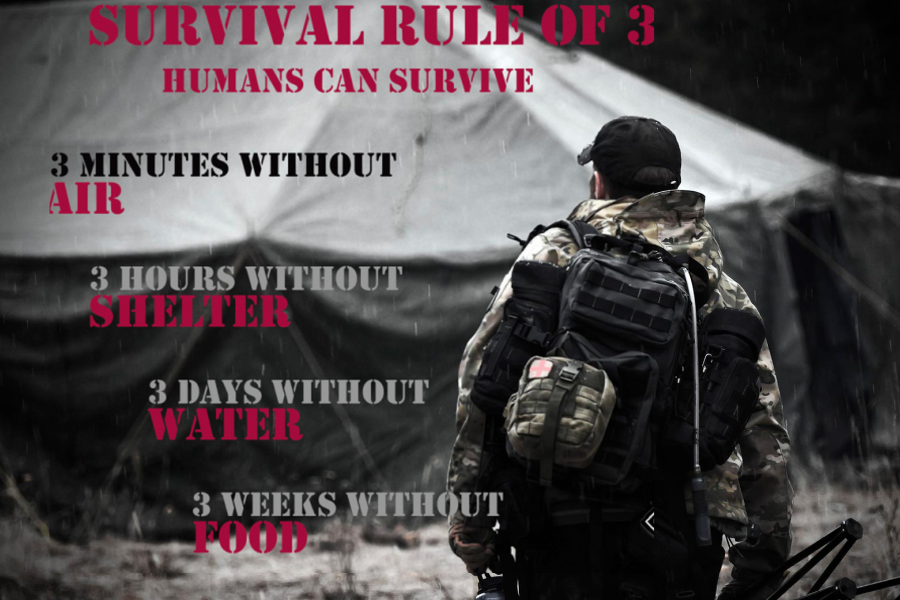
The Rule of Threes
When it comes to survival, there are four basic rules that you should consider. These rules help you when preparing for an emergency and the...
Our editors carefully select every product we recommend. We may earn a commission from these links. Learn more
The 8 Basic Survival Skills Every Man Should Know
By: Sean Tirman Updated: Apr 25, 2023
We live in a world marked by modern conveniences. Which is totally fine, most of the time. But, every once in a while, disaster strikes. Whether there’s a horrendous storm that knocks out your power or you just get lost by wandering too far off the trails, a very bad situation can be mitigated exceptionally if you just know a few basic survival skills.
In order to help you be a little bit more prepared for whatever might befall you, we’ve put together this list of the 8 most important survival skills that every man should know. From making fire, to building shelter, to binding your wounds – these are the talents that, when properly practiced and honed, can make all the difference between being utterly without hope and coming out the other side a victorious survivor. So bone up on the following skills, because some day you might need them.
Finding & Purifying Water
Nothing is more important in a survival situation than having suitable drinking water. Humans can survive weeks without food and can live entire healthy lives in temporary shelters, but without water we can die in just a matter of hours – minutes, even, if the heat is bad enough. So whether you’re trapped without power by a snowstorm or you’ve taken a bad spill off the trails and into a ravine, one of your top priorities should be seeking out and, potentially, purifying water for drinking. There’s no guaranteed way to make that happen in every circumstance, but there are a few tips and tricks that will go a long way toward getting the job done. They are as follows:
Gravity, Greenery, & Ground: If you find yourself in hilly terrain, remember that the flow of water is always going to be downhill. You can count on seeking out streams and creeks in the crevasses where hills meet. If you can’t see the flow of water, it doesn’t mean it’s not there. Take a quiet moment and try to listen for the sound of water cascading over rocks – then just follow the sound. If you can’t see or hear the life-giving liquid, look for signs of life. Animals frequent areas with suitable drinking water, as do insects. As a final resort, digging a hole in damp soil will sometimes reveal some groundwater. Just remember to use groundwater as a last resort, as it can be very filthy and riddled with germs and parasites.
Beware Of Stagnant H20: Always beware of standing water, as it is likely chalk full of every manner of parasites and bacteria. The same goes for pooling water in streams. Your best bet for finding suitable drinking water is always going to be in places with a strong flow, as all the stuff that will almost certainly make you ill propagates wherever water doesn’t move. For reference, both malaria and dengue fever – two extremely dangerous diseases – are amongst the dangers of standing water, as is anything else a mosquito might be carrying because the bloodsucking insects breed in stagnant pools. If you have a choice, avoid standing water at all cost.
Boil It If You Can: Even if you find a flowing stream with what looks like crisp and clean water, you’ll still want to try and purify it. Yes, it will take more time and you might be thirsty, but the alternative is potentially getting a parasite or an infectious disease that could lead to a far worse situation. If you have the means to build a fire and a vessel in which you can place water, bringing that water to a boil is probably the safest and most reliable way to get any sickness-inducing impurities out of the liquid. Barring that, you can bring with you a personal water filter or purification tablets (which you can find at most outdoor retailers) or, if you are absolutely desperate, drinking questionable water might be your only option. Again, this is an absolute last resort. If you have the means, take the time to try and purify any and all naturally gathered water – even snow or ice. The risk just isn’t worth it, if you have a choice.
LifeStraw Personal Water Filter
It isn’t always easy or even possible to boil water out in the wilderness. Whether you’re having trouble starting a fire or you just don’t have a vessel in which to place that life-giving liquid, you can better prepare yourself for a bad situation if you bring the $25 LifeStraw personal water filter along with you on your adventures. Not only does it kill up to 99.9% of all waterborne bacteria and parasites, but it will filter up to 1,000 liters of water without the use of chemicals.
Starting & Tending To A Fire
Second only to finding suitable water, the ability to make fire is one of the absolute most important and useful skills anyone can develop in the case of an emergency . Not only will it give you life-saving warmth in the cold of night, but you can use it to purify water, cook food, ward off predators, cauterize wounds, and even signal for help. Ideally, you’ll have a lighter or matches on your person in the case of an emergency, but you should also be able to start a fire from scratch, just in case. Because unless you carry an ignition source on you at all times, you could easily be caught in a survival situation without one. Here are some tips to get you started:
The Drier The Better: It doesn’t matter how skillful you are with a bow drill, magnifying glass, or flint and steel if your fuel (e.g. wood, brush, twigs, sticks, etc.) is too wet/hydrated. Rather than pulling branches off of living trees or grabbing anything that looks even remotely green, seek out dry, cracked, dead branches off the ground. Same goes for your kindling – dry dead grass works 10x better than freshly plucked greenery and will save you both time and energy. The only time you want to use any kind of green vegetation on a fire is if you are trying to create smoke signals. And even then, you want to get a good fire going with dry wood first and then “cook” the greenery above it.
Start Small: The smaller the fibers of whatever it is you are trying to burn, the easier it will be to get them lit. You can start a raging bonfire with just a few smoky sparks in a handful of dead grass if you coax the flames properly. Don’t bother trying to light even medium-sized branches, as it will likely be a waste of time, fuel, and precious energy. In fact, you’re probably better off lighting your kindling outside of your main stack of wood and then gently moving it beneath your larger branches once you’ve got a small flame going. Remember, even a single spark can make all the difference. Be patient, be gentle, and you’ll have a flame in no time.
Be Creative: Matches, lighters, and friction aren’t the only way to start a fire. Sure, they’re probably the easiest, but if you’ve got creativity you can pull a MacGyver and figure out other ways to make a flame. Burning ants with a magnifying glass is a cruel childhood trick, but it’s also a useful skill later on in life. If you’ve got glasses, you can focus light from the sun into a concentrated beam and easily ignite your tinder. That same tactic can be applied to clear ice, if you’re in a cold climate. And those are just two ways to use your environment and put the gear around you to good use.
Exotac Waterproof Lighter Case
Never underestimate how important fire can be in a survival situation. Whether you need to keep warm, cook some food, or cauterize a wound, the ability to make fire is an absolute necessity. But rather than struggling with a bow drill or a pocketful of flimsy matches, you can stash a disposable lighter in this small, lightweight, and waterproof $18 Exotac FireSleeve and you’ll always have a flame available at your fingertips.
Building A Temporary Shelter
Hopefully, if you get lost in the woods, you can find your way back to civilization in less than a day or so. If not, however, you’ll probably want to know how to build a shelter to protect yourself from the elements. After all, the danger and risk in an emergency can be compounded by cold, rain, snow, or even a thick fog if you don’t have a shelter to protect yourself from your surroundings. Now, the way that you can build one is going to depend heavily on your surroundings and the environment in which you are, but the following are two common shelter types and the easiest ways to build them:
Lean-To: One of the easiest survival structures to build, the lean-to is called such for the fact that it generally consists of leaning building materials up against a pre-existing structure or natural formation, such as a wall, rock face, fallen tree, etc. It can also be built free-standing if you can construct a 3-piece standalone frame onto which you can lean your building materials. The downside to this type of shelter is that it does not generally offer 360 degrees of protection and, unless you are quite diligent in your build or have some kind of tarp or trash bags, it will likely not be very resistant to water. That being said, it’s an excellent structure in a pinch.
Round Lodge: Commonly known as a teepee, wickiup, or wigwam, this type of survival structure is kind of like the natural evolution of a lean-to. It is built in a similar fashion, with a large number of branches leaning together to create the larger structure, but it offers a bit more protection because it can encircle the user almost entirely when built well. It will certainly take more time and materials to make, but it also offers a greater return in a survival situation as it can protect you, your gear, and any potential food you gather from the elements and, to a degree, any scavenging animals or predators.
Other structures, which are environmentally and materialistically dependent, include the Igloo/Quinzhee snow huts, a snow cave, Ramada, and various tarp shelters. But the ideas are all the same: get a roof over your head to protect you from whatever environmental follies might be coming your way. They also have their own risks. For example, a snow shelter has the potential to collapse and either suffocate or freeze you to death. Dry shelters can easily catch fire if you have your campfire too close or a bad gust of wind blows burning ash into your structure.
While there are some unforeseen circumstances you’ll have to deal with as they come about, there are a couple things you can do to make things easier: do not ever build a structure too close to water or in damp or muddy basins – you don’t want to get washed away in a flash flood. Seek out high and dry land. It’s also a very good idea to stay away from any areas that look too frequented by wildlife – watch out for footprints and droppings. Sure, it might be a good spot to catch dinner, but you might not be the only one looking for a meal. Lastly, it’s always a good idea to build a base frame to keep you and your shelter up off the ground. This will help protect you from bugs, dirt, and minor flooding.
Schrade Survival Hatchet
Although you could arguably break enough wood by hand to build yourself a shelter, the work is going to be a hell of a lot easier if you have an axe handy. This Survival Hatchet from Schrade is one of the best for the job because, while it is an excellent chopping and cutting tool, it also comes with the added bonus of a built-in ferro rod – so you can hack up some firewood and get it lit all with this one handy outdoor tool. And it’ll run you less than $50.
Navigating & Reading A Compass
Let’s say for the sake of argument that you are hiking at your favorite national park and, through some unfortunate accident, you’ve lost your way and there are no trails in sight. Well, what do you do, then? Scream for help until someone comes along? Pick a direction and just start walking? Curl up in a ball and cry? No. Your best bet for survival is to know how to navigate the world that surrounds you. And there are a couple simple way to do that which will come in handy in just such a situation.
Find The High Ground: While not always practical or necessary, finding a high point in the surrounding land is probably the simplest way to see where you need to go. Or at least where not to wander. If you can meander your way to the top of the nearest hill or even climb a small tree, it will help orient you in a much better way. It might seem pretty obvious when said aloud, but if you are lost and panicking, finding a vista to gauge your location is, at the very least, a good starting point.
Use The Sun: Barring the extreme North and South Poles, no matter where you are on planet Earth, the sun moves from relative east to relative west. It’s not a perfect system, but it is certainly better than nothing. There’s also a simple trick to make this easier: take a long stick and push it into the ground so that it stands up on its own. Then, make a marking in the dirt where the tip of the stick’s shadow is. Wait a few minutes and check to see in which direction the shadow has moved – that general direction is east.
Follow Water Civilization and life itself hinges on the availability of water. If you can find a river – follow the flow. Chances are you will come across other people at some point, so long as you aren’t completely off the grid. Even if you don’t immediately find your way back, you’ll at least have a decent source of drinkable liquid in the case that you remain lost. If you’re lucky enough to carry a water bottle with you, you can also fill it up before venturing off.
Bring A Compass: We aren’t going to profess to be expert navigators by any stretch, but you don’t really need to be in order to read and use a compass . Even the most basic understanding of the device (one side of the needle always points north) can help in a survival situation. Of course, reading a compass also helps if you’ve got a map to reference, but it’s still entirely useful if you don’t. The greatest benefit of a compass is that it will continue to work when your other technology doesn’t – and that makes it more reliable. For a more in-depth guide, look to REI’s instructions on how to use a compass .
SE Sighting Compass
Even if you only have a basic understanding of how compasses work, you should keep one with your camping, hunting, hiking, or emergency survival gear. Really, it can be an invaluable means by which you can find your way out of some of the worst situations and back to civilization – especially if you’re lost at night or on a cloudy day and cannot navigate by the sun. For just $11, you can pick up this comprehensive military-style sighting compass and it will make a world of difference in an emergency.
Hunting & Foraging For Food
In the case that your emergency survival situation stretches into days and/or weeks, you’re going to need to know how to find and catch food to keep yourself alive. There are a number of different ways to do this, all of which have both benefits and drawbacks. The following are a few methods you can use to catch food in the wild, so long as you have or can make the proper tools in order to do so:
Hunting Game: If you have the ability to fashion a weapon by sharpening a long sturdy stick, you can use that tool to spear small game or fish. The benefit to this method is that it takes very little craftsmanship to make a stick pointy enough to pierce the body of a small creature, but you can waste a lot of precious energy in your pursuit, as you burn a lot of calories chasing after and trying to spear small critters for food. And that’s compounded the larger the animal is, as is the risk of injury.
Trapping: There are a number of different small survival traps you can make out in the wild using just the materials you have on you and stuff from your surroundings. While it takes patience and some skill to build a trap and use it to catch a meal, it will also cost you far fewer calories than actively hunting for food.
Fishing: If you have something you can use as a fishing line and hook, you’re near a body of water, and you’ve got some time, this is probably your best option for finding high-protein safe-to-eat food. All you really have to do is set up your fishing line – with bait, if you can manage it – and wait until you catch something. Just be aware that places with an abundance of fish are also going to be frequented by other larger predators.
Foraging: You aren’t going to get the same physical returns from eating local flora, but you also probably won’t be expelling the same amount of energy collecting it. You’ll probably also be shocked by the wide variety and number of available plants there are to eat in some places. As a general rule, however, you’ll want to stay away from anything that looks or has a reputation for being even remotely poisonous – like mushrooms, for example. Whenever you go off on a long-form outing, you should familiarize yourself with the local plant life beforehand. Try grabbing a survival book to help.
Edible Wild Plants Field Guide
Unless you are a life-long botanist with a PhD, you’re going to have a hard time telling which flora is edible and which will send you painfully to an early grave. Rather than risk it, you can bring along a handy Edible Wild Plants Field Guide with you on your adventures. This $20 one covers the plant life around the central and eastern parts of North America, but you can easily find guides that are appropriate for any part of the world. Since this can literally be the difference between life and death, we can’t stress its importance enough.
Camp Cooking
Even if you do catch some wild game, you can’t just eat it raw, unless you want to risk getting parasites or other diseases carried by those animals. As such, it’s important that you know both how to cook in the wild and what’s safe to eat. While the rules are going to vary from locale to locale, there are – of course – some general guidelines that can get you started. They are as follows:
Get Out The Guts: In a 5-star restaurant, goose liver can be considered a delicacy. In the wilderness, it can kill you. Whenever you are dressing your meat for cooking, you should dispose entirely of any and all of the guts – especially with regards to the digestive tract. Yes, we know that Bear Grylls and Les Stroud have eaten raw hearts and livers, but they are long-time professionals. And unless you are too, you don’t want to mistake something safe to eat with something that will, at the very least, give you diarrhea. Stick with muscles and limbs.
Overcook Rather Than Undercook: Burning your meat might make it a little bit tougher to eat and perhaps a mite less savory, but it is far far better than the alternative. A part of the reason you want to cook your food through entirely is to help kill off any potentially harmful bacteria or pathogens that might be in the meat. These are wild animals we’re talking about here, not factory-grown meats or steak cuts you can pick up in a store. So, you never know what might be lurking. As a general rule, you’re better off with tough jerky than anything even remotely rare.
Dispose Of All Waste: This is not so much a tip about camp cooking as it is an important note on keeping yourself safe in the wilderness. Any time you finish cooking, you’ll want to dispose of any and all waste away from wherever you have your shelter set up. And it’s for the same reason you would at a regular campsite: wild animals will smell the food and want to have a bit for themselves. And while some of those animals could be relatively harmless, you wouldn’t want to come face to face with a bear, mountain lion, or otherwise. If you can, bury your garbage. If you can’t, make sure you ditch it far from wherever you sleep.
Snow Peak Giga Power Stove
We know you’re not always going to be 100% prepared for the situations that befall you, but you can still try and do your best to mitigate the worst circumstances by preparing for a number of contingencies. Knowing how to build a camp stove out of materials you find in nature is an excellent skill to have, but your life can be made simpler in the most dire circumstances if you have the foresight to pack something like the Snow Peak Giga Power Stove . It’s tiny, it folds down for storage, and you can use it for everything from cooking to purifying your water.
Dressing A Wound
Being injured in an emergency situation is arguably the worst worst-case scenario, because it just compounds everything that’s already bad about the situation. And while you may be able to avoid any kinds of serious injuries, it’s always better to be ready to deal with them head-on if you or someone you are with suffers a gash, break, or otherwise. Here are some ways you can take care of common types of injuries, as well as other tips and tricks for first aid :
Close The Wound: It might seem obvious, but its importance cannot be overstated: an open wound is a gateway for bacteria and, subsequently, infection – which can lead to even greater complications. If you suffer a cut, even a small one, you’re going to want to do your best to clean the injury (alcohol can do the trick) and seal it shut. There are a few different methods you can use, including bandaging with cloth, using a first-aid kit (band-aids and such), or – in a dire emergency – you can even burn closed a wound that wont stop bleeding.
Bandage Reasonably: Tourniquets should only be used as an absolute last resort. And that’s because the tight binding of a limb can result in that limb’s loss. So unless it’s a life or death situation, using a tourniquet shouldn’t be a consideration. That being said, you still want to be sure that your bandage closed any fresh wounds with sterile cloth, if its available. And change those bandages often, because a dirty bandage can lead to a festering wound. For reference, check out Backpacker’s guide to treating deep wounds .
Brace A Break: In the unfortunate circumstance of a broken limb, you’re going to want to bind the injury in a way that keeps you from making it worse. Luckily, that’s as easy as finding a sturdy relatively straight tree branch and tying it to the limb with some rope, cloth, or – if you’re lucky enough to have some – a bit of 550 paracord. Unless you are a medical professional, do not try to reset a broken bone, as you could potentially make the fracture even more severe.
Sportsman Medical Kit
Anytime you go on an outing, you should have a first-aid kit stashed in your pack. You might not always need it, but it can make all the difference in the case that you do. The Sportsman Series Medical Kit from AMK costs just $54 and is loaded with all the stuff you might need if you or someone you’re with suffers an injury from a number of outdoor activities – like hunting, fishing, camping, or off-roading. And it’s loaded with enough stuff to care for up to 7 people.
Tying A Knot
This is an absolutely underrated skill set, not just for survival, but for a number of different leisurely or sporting activities, including sailing (or, more generally, boating), camping, rock climbing, and more. And the applications can be incredibly helpful in a survival situation. Knots aren’t just for shoes and hastily tied together packages; when properly learned and executed they can help with securing hunting traps, fishing line, bandages, survival shelters, and will play a part in pretty much every other skill on this list.
If you think you know how to tie a proper knot, but you’ve never actually looked into types and instructions as to how they work, you’re probably not doing it right. Sure, with enough experimenting, you might be able to come up with something that’s relatively satisfactory, but you could also end up with a shelter that falls apart, a trap that doesn’t work, or you’ll waste much of your precious paracord , rope, twine, or otherwise. At the very least, you’ll want to know how to tie a clove-hitch, square, and bowline. There are dozens of different types of knots, but the basics should do you right in an emergency. If you want to know more of the ins and outs of tying knots and for what you can use them, check out our guide to the 10 basic knots you should know.
RattlerStrap Paracord Survival Belt
If you were to take just one thing onto a desert island, you might want to make it the RattlerStrap Paracord Survival Belt . This $97+ belt can hold your pants up, but it also unravels into over 80 feet of 550 paracord – an extremely handy survival tool that can be used to build shelter, hunting traps, can be used in fishing applications, is useful for binding wounds, and more. Truly, the applications are as endless as your imagination.
Purchase: $97+
From Our Partners
Gerber Ventures Into More Premium Territory With Its USA-Made Fastball Knife
Presented by Gerber
Nike’s Air Jordan Golf Shoe Has Design Elements Informed by MJ’s Basketball and Baseball Careers
Presented by Nike
The Best USA-Made Everyday Carry Essentials [VIDEO]
Tested: The Best Tactical Knives For Everyday Carry
By Tim Huber
Hands-On: Gerber’s Fastball Urban Grey Edition Is a Versatile American-Made Workhorse
Timex & The James Brand Join Forces For an All-Titanium “True GMT” Watch
The James Brand Just Dropped a Limited Huckberry Edition Of Its Gen-2 Chapter Knife
Blackout: The Best All-Black EDC Keychain Essentials
Benchmade’s Water Collection Knives Are Built Specifically For Maritime Use

- Mount Kilimanjaro
- Mount Kenya
- Mount Toubkal
- Mount Aconcagua
- Mount Everest
- Mera Peak and Island Peak
- Mount Kinabalu
- Himalayan Mountains
- Borneo treks
- Nepal treks
- Moroccan Atlas treks
- Treks in East Africa
- Trek in Europe
- Wildlife Safaris
- School Expeditions
- Family Holidays
- Medical Electives
- Volunteering
- Private Expeditions
- Indonesia and Papua
- Experiences
- Trip Finder
- Trip Leaders
- Sustainable Tourism
- Adventure blog
- Add a review
- Trip reviews
Ask Us A Question...

Jungle Survival Tips
- Tips for Surviving the Jungle
The last 12 months have been a big period for adventure movies in Hollywood, with The Revenant, The Jungle Book and now ‘Jungle’ starring Daniel Radcliffe .
The film is based on the memoir Lost In The Jungle by Yossi Ghinsberg, which recounts the experience of four travellers’ desperate attempts at survival after becoming lost in the Amazon rainforest.
While being lost in the jungle is a terrifying prospect, there are several things that you can do to make your chances of survival easier. Here are the top tips we teach clients on our rainforest trips in Borneo – you never know when you might need them!
If you get lost in the jungle then S-T-O-P:
Initially, it is a very frightening feeling to feel lost. It’s really important to act calmly and objectively as much as possible. Every decision you make now is critical.
Shouting for help can be useful if you think you are close to your group or a village or a trail but remember that it’s difficult to know where a shout is coming from in the jungle.
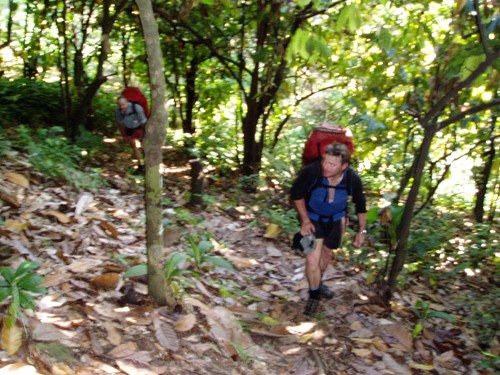
First decisions
If you are stuck in the jungle due to a plane crash, stay at the site of the plane to see if rescue arrives and only start moving once you are certain no one is coming to the rescue.
If you are on foot and you know you are not far from a village or trail try to figure out where you came from and get back to a point you recognize. This could be a stream or a high point or a jungle trail.
Go through in your mind the last hour or so of walking and picture it in your head. What did you see? What landmarks did you pass? Which direction was the sun in? Any memory will help.
Look around you carefully and see if there is any evidence of where you came from, for example broken branches. This may help you decide which direction to start moving in.
Orientation In The Jungle
If nothing seems apparent then you need to pick a direction and keep going in a consistent direction. If possible leave a note saying where you are going and what time it was. Travelling in the jungle is very slow but with luck rescuers might follow you and find you.
Travel during the day and sleep at night. Heading downhill will likely lead to a stream which you can follow until it becomes a river, which will lead you out of the jungle. The wider the river the more likely there will be civilization.
Walk In One General Direction
Focus on something ahead of you to aim for and something behind you to walk away in order to stay in a straight line and stop yourself walking in circles. Jungle travel can be very disorientating and the fear factor creeps up if you are not confident in your movements. Always feel you are in control of where you are going and justify it loudly to yourself.
The jungle canopy can make things quite dark and difficult to get your bearings so also look for some high ground where you might see a depression where there could be a river.
Follow Animal Trails
Look for animal trails left by animals in the jungle, and follow them if they are heading in the same direction as you. They might lead to water sources or open areas where you might more easily be seen by rescue parties. Carry a stick to push away any plants in your way and as an aid for balance.
Clambering over fallen tree trunks is a very common way to have an accident. Try to avoid using your hands, many plants will sting or prick you.
Establish Your Priorities To Stay Alive
These priorities are:
- Find drinking water
- Build a shelter before nightfall
- Create a weapon or tool for making things
- Find a source of food
Finding water in the jungle
Collect rainfall.
Leaves in the jungle are usually large and can be bent into a funnel shape and used to collect rain water. Store it in your water bottle or drink it straight, the most important thing is that you remain rehydrated.
Look for streams of running water and avoid stagnant pools. Preferably you will want to boil any water that you collect from streams in order to kill any bacteria. Check the water for any particles or bits, you can filter them out (through your sock if necessary).
Bamboo Stalks
Bamboo collects rainwater in the compartments of the stalks and can provide an excellent source of water. Look for the lines across the trunk, these divide the inside into compartments which you could use as water bottle if possible. Otherwise bend the bamboo to allow the water to flow out into a container.
Create a Solar Water Still
- Dig a hole in the soil in an area where there is at least some direct sunlight
- Place a container in the hole like a bowl or water bottle, plate or cup
- Fill the area around the container with anything wet, such as leaves.
- Lie a plastic sheet over the hole and anchor it with rocks around the edge.
- Place one small stone in the centre of the plastic, just above the container.
- Condensation will occur on the underside of the sheet and run down to the middle and drip into the container with distilled drinking water.
Building a shelter in the jungle
The shelter is vital in protecting against the elements and is a top priority. The easiest shelter to make is a lean-to out of branches and leaves.
- Find a long fairly straight branch and lean one end against a tree.
- Place more shorter branches along the length of the long one at 45 degree angles
- Cover the whole thing with large leaves to make a cover.
Finding food in the jungle
Build a trap.
Don't waste energy and time hunting animals. It’s very difficult and you need to be use a weapon like a bow and arrow which takes a lifetime to perfect. Your best bet is to trap animals and conserve your energy or fish.
There are many variations of traps but basically they choke, crush, hang or entangle wild animals by trapping them in a snare or in a hole or under a falling log or boulder. The more you make the more chance you have of catching something but knowing where to place a trap is key and in the jungle a good place would be on an animal trail.
To make a deadfall trap you need a large rock, two sticks about the diameter of a C battery and 5" long, a strong, thin stick, about the diameter of a pencil and a knife.
Fishing in the jungle
An effective way to catch them is through the use of a pronged fishing spear which you could make with a piece of bamboo. Find a 6’ piece of bamboo and cut two 6” splits at one end to make four prongs. Separate the prongs with some vine in the gaps and then sharpen them with a knife or sharp rock.
Find a rock to stand on or wade into knee-deep water. Move slowly to avoid scaring away the fish. Once you spot a fish, wait for it to swim close to you and jab quickly and forcefully to pin the fish on the bed of the stream. This takes practise.
To cook your fish:
• Heat 6 to 8 medium-sized rocks in a fire for a few hours. • Dig a hole in the dirt 1 foot deep and 2 feet across • Move the hot rocks into the hole using a stick. • Wrap your fish in green leaves and tie it with vine. • Put the wrapped fish on top of the rocks and cover it all with dirt. • After about an hour, dig up the fish and eat
What are the main dangers in the Jungle?
Fallen trees, slippery rocks.
- Dehydration
Falling trees and branches are the most common reason for injuries in the jungle, so choosing a night camp is important. Keep on clear ground.
Common perils in rivers or streams include slippery rocks , submerged branches, strong currents, leeches and possibly larger animals like crocodiles. Keep footwear and clothes on and use a stick for balance and choose your crossing point carefully. Don’t cross rivers more than knee deep unless absolutely necessary.
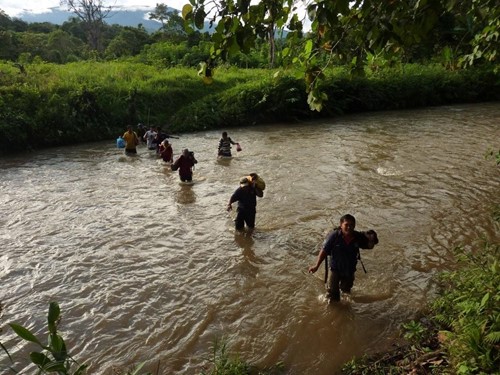
Sunstroke, sunburn, heatstroke and dehydration
Sunstroke, sunburn, heatstroke and dehydration are all very easy to fall prey to, so always keep your clothes on, especially covering your head and neck. Ants, snakes, venomous spiders, plants with spines or thorns are all quite common in the jungle so use a stick to help get through vegetation and don’t grab things with your hands. A cut or bite or sting could quickly lead to infection.
Mosquitoes spreading diseases like malaria, dengue, and yellow Fever . Use repellent if possible or rub mud on exposed skin to avoid bites, and wear long-sleeved shirts and trousers and tie a shirt over your head to it covers your shoulders. At night, use a mosquito net if you have one or use sap from a camphor or eucalyptus tree.
To find out more about Adventure Alternative jungle trips in Borneo.
Read more:
Daily Mail Online article: http://www.dailymail.co.uk/travel/travel_news/article-3796700/Get-water-bamboo-create-leaf-shelter-use-mud-repel-mozzies-Daniel-Radcliffe-films-new-movie-Amazon-ultimate-guide-jungle-survival.html#ixzz4KsdSDi8h
Explore the Jungle with experts:
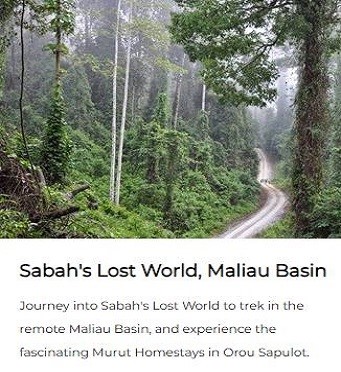
- Entertainment
- Environment
- Information Science and Technology
- Social Issues
Home Essay Samples Life
Essay Samples on Survival
What does it take to survive: an exploration of resilience.
The journey of survival, whether in the face of physical challenges, adversity, or life's uncertainties, is a testament to the strength of the human spirit. As we ponder what it takes to survive, we delve into the intricate web of factors that contribute to resilience....
We Need The Endangered Species As They Need Us And Why We Should Protect Them
Adam Smith once said, “Human is an animal of desire.” In this respect, humans have made tremendous economic and technological development based on that desire, which also led to countless destructions of nature and wildlife. Accordingly, many species have been gone extinct or close to...
- Endangered Species
Into The Wild: Self Reliance Of Chris Mccandless
“A fool thinks himself to be wise,but a wise man knows himself to be a fool” (william shakespeare). Into the Wild is a nonfiction book by Jon Krakeur on the life events of Chris Mccandless from when he was growing up and when he adopted...
- Into The Wild
Selfish Nature Of Man: Being Selfish To Survive
Many are unaware of the true nature of man, whether it is good or evil. These three qualities: selfish, egocentric, and instinct, can all describe certain aspects of one thing. Mankind. To soon be discovered, the true nature of man is evil because man is...
- Selfishness
Struggle For Survival In Frank Mccourt's Novel Angela's Ashes And The Street By Ann Petry
Angela's Ashes and The Street both deal with the theme of struggling for survival. McCourt’s Irish slum and Petry’s Harlem are separated by a vast ocean, yet their struggles are simular. McCourt and Petry both use characters, events, and settings to develop the theme of...
- Angela's Ashes
Stressed out with your paper?
Consider using writing assistance:
- 100% unique papers
- 3 hrs deadline option
Chuck Noland's Experience Of His Island Survival And How It Changed Him As A Person In The Movie Movie Cast Away
In the film Cast Away, Tom Hanks shot as Chuck Noland, a FedEx worker who crash lands within the Pacific. He drifts till he reaches an isolated island and is deserted for four years. His life before the crash, being treed on the island, and...
The Rising Dead: A Zombie Apocalypse Survival Guide
The groan of the undead; the sputter of hisses they make with their decaying rotten teeth and the boils of putrid flesh that lingers around like the smell of oven baked cookies. Their molten skin peals back, revealing rotted ligaments and tissue that swarms with...
The Interconnection of Hope and Hopelessness with Tragic Events
Hope is closely associated with the feelings of trust and existence. Stories of hope are central not only in literature but also in science, cultural movements and spiritual studies. In hope, someone tends to focus on the idea of positive change – either personal or...
The Study of Survival Skills in Into the Wild
Christopher McCandless was a young man who wanted to give the world a challenge and use his energy to survive in the wild. He had very few reasons for venturing out into the wild without the proper equipment and gear to survive for at least...
- Chris Mccandless
Waldyslaw Szpilman's The Pianist: A True Story of One Mans Survival Novel Analysis
Introduction Jews survived all the defeats, expulsions, persecutions and pogroms, the centuries in which they were regarded as a pariah people, even the Holocaust itself, because they never gave up the faith that one day they would be free to live as Jews without fear....
- Literature Review
- The Pianist
Wilderness Search And Rescue Assigment
Introduction Nature is a beautiful thing that should be explored and persevered for the future generation, it does come with its challenges such as patient getting injured and exposure to elements in the environment can produce many types of emergencies. Emergency practitioners must be ready...
- Emergency Management
What a Person Needs to Survive on the Moon
Have you ever thought about what would happen if we had to move to a different planet? What would we need to survive? All those questions you might be asking yourself now? Well here is a little idea of what it might be like to...
The Dangers of Natural Disasters and the Means to Survive Them
Every year our Earth is affected by something or the other. Be it storms, global warming, even pollution. But there is one topic that is heard of every year and happening before our very eyes. Natural disasters. Did you know that all over our Earth,...
- Natural Disasters
The Ignorance of Hitchiking in the Into the Wild by Jon Krakauer
Have you ever wanted to go exploring out in the wild all by yourself? If so you might want to change your mind. Based on Jon Krakauer’s novel, “Into the wild”, The author explores the life of a young man named Chris McCandless who hitchhikes...
The Theme of Never Giving Up in Gary Paulsen's "Hatchet"
Gary Paulsen’s Young adult fiction story, Hatchet, takes place on a small island, an island with no people where he is alone. Brian got in this situation as the pilot of the plane he was on had died and Brian with no experience of flying...
The Theme of Survival in "Hatchet" by Gary Paulsen
In Gary Paulsen's novel, "Hatchet," Brian Robinson is a 13-year-old city boy who lives in Hampton, New York, and is going through a tough time as his parents are getting a divorce. Brian has to ride a plane all by himself from Hampton, New York,...
- Book Review
The Story of Robinson Crusoe - Travelog Written by Daniel Defoe
The passage assigned to deals with Crusoe’s personal account on survival in an uninhabited island with limited resources, just after his ship gets wrecked due to strong winds and storms. He talks about the events in the story in chronological order. The passage is described...
- Robinson Crusoe
Adaptation to the Environment as a Way to Ensure Ecological Survival
An ecological niche is the relationship between an organism and its surroundings to ensure its survival and includes the physical habitat, activity pattern, and environmental conditions. Physical habitats are the natural environment an organism lives where resources and shelter is provided. Environmental conditions are the...
The Fatherly Figure and Surviving in Elie Wiesel's Life
The Holocasut was the extermination of the Jewish people by the Nazi Germans. By the year 1945, 6 million Jews were murdered as a result of the Nazi’s ideology of racial superiority. The horrific events that occurred during the Holocaust, as seen through the eyes...
- Elie Wiesel
Elie Wiesel: The Holocaust Survivor and Fighter for Human Rights
New York is considered a melting pot because of its unique diversity of nationalities, cultures, and ethnicities, thanks to a large number of immigrants that come from all over the world. These different cultures and ethnicities that exist in New York can be seen through...
The Price of Survival in Sabaibaru Famiri
This essay will be doing an analytical exploration of the civil concern confronted by the Japanese kazoku in the masterpiece film called “Sabaibaru famirî” made by Shinobu Yaguchi in 2016 which resolves around an unforeseen global electricity cessation that forces a Tokyo living kazoku in...
- Movie Summary
Report on the Film Survival Probabilities
There are considerable theoretical and empirical works of literature in favor of the benefits of international trade on firms’ survival prospects from various perspectives. This, in turn, provides a rationale for various countries’ government for intervention to help firms develop their exporting activities in a...
- Organization
- Stock Market
My Fantasies About The Apocalypse
The year was 2027 and the world as we knew it was gone forever. Everything had changed so fast. We were living in a world filled with technology, a time when electricity was fueled by the sun and your clothes changed their color at the...
Effect Of Low PH On The Survival And Management Of Freshwater Aquatic Life
pH is an important factor to sustainable aquatic life because it effects the ability of such organisms to regulate and carry out vital life-sustaining processes, including the exchange of respiratory gases and salts within the water they occur. If the pH range exceeds the physiologically...
The Impact Of Thermal Fluctuations On Ectothermic Animals
Ectothermic animals such as turtles, snakes and lizards rely on external environments for heat and therefore the environment heavily influences the animals cellular, organ and organismal functions. There are many adaptations used by these animals in order to function at low or high temperatures, such...
The Analysis Of The Novel "A Long Walk To Water" By Linda Sue Park
“If you want to start learning to appreciate what you have and stop wanting more we have to become educated of the reality of those who have less. There is a saying that states “When you practice gratefulness, there is a sense of respect towards...
The Need Of Survival In The Book "The Road" By Cormac Mccarthy
Many people believe that life is a fancy word humans use to hide the pain that exists beneath it. That humans don’t actually live as they wished when they were little. They think, that what they do, by waking up in the morning, going to...
Best topics on Survival
1. What Does It Take to Survive: An Exploration of Resilience
2. We Need The Endangered Species As They Need Us And Why We Should Protect Them
3. Into The Wild: Self Reliance Of Chris Mccandless
4. Selfish Nature Of Man: Being Selfish To Survive
5. Struggle For Survival In Frank Mccourt’s Novel Angela’s Ashes And The Street By Ann Petry
6. Chuck Noland’s Experience Of His Island Survival And How It Changed Him As A Person In The Movie Movie Cast Away
7. The Rising Dead: A Zombie Apocalypse Survival Guide
8. The Interconnection of Hope and Hopelessness with Tragic Events
9. The Study of Survival Skills in Into the Wild
10. Waldyslaw Szpilman’s The Pianist: A True Story of One Mans Survival Novel Analysis
11. Wilderness Search And Rescue Assigment
12. What a Person Needs to Survive on the Moon
13. The Dangers of Natural Disasters and the Means to Survive Them
14. The Ignorance of Hitchiking in the Into the Wild by Jon Krakauer
15. The Theme of Never Giving Up in Gary Paulsen’s “Hatchet”
- Personal Experience
- Perseverance
- Career Goals
- Self Assessment
Need writing help?
You can always rely on us no matter what type of paper you need
*No hidden charges
100% Unique Essays
Absolutely Confidential
Money Back Guarantee
By clicking “Send Essay”, you agree to our Terms of service and Privacy statement. We will occasionally send you account related emails
You can also get a UNIQUE essay on this or any other topic
Thank you! We’ll contact you as soon as possible.
You won't be able to get these critical items post-collapse.
Enter your e-mail below to get your free pdf and start stockpiling.
or close this window and go to the blog
I will never SPAM you. Your e-mail is 100% safe.

10 Critical Basic Survival Skills To Save Your Life
Whether you’ve been a prepper for some time, or if you’re just starting out, you probably know that having the right set of skills is one of the best ways to improve your chances of survival in short-term emergencies, as well as large-scale catastrophes.
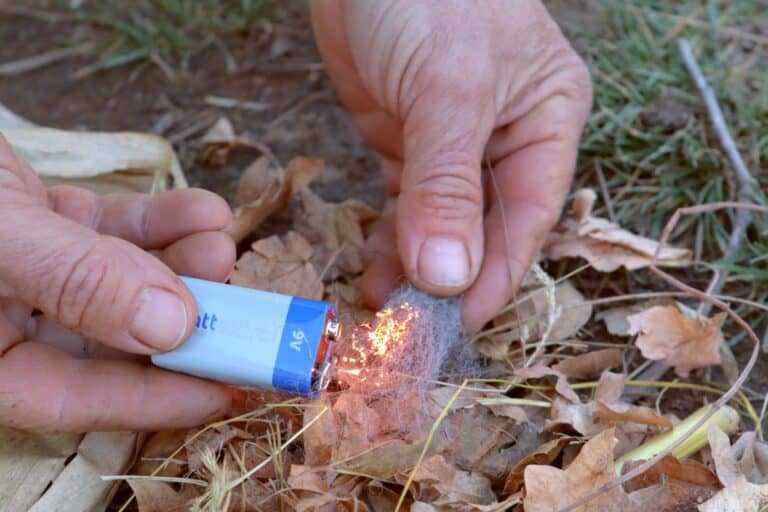
Whether you’re a rural prepper or you live in a crowded city, whether you’re thinking about bugging in our out, whether you live alone, or if you have children, these basic survival skills are mandatory to know regardless of your unique situation.
Table of Contents
Which Survival Skills are Most Important?
There may be hundreds of different survival skills to learn, and there’s no way anyone can get good at all of them.
I hand-picked the ones that will be most useful to you in most emergencies, and the way I did that was by looking at one of the most basic survival concepts: the rule of threes .
This simple rule states that one can live up to 3 minutes without air, 3 hours without shelter, 3 days without water, and 3 weeks without food. As you can see, shelter and water are much more important than food.
Work on these 10 skills first and get GOOD at them, before moving on to other, more advanced survival skills.
Skill #1: Shelter Building
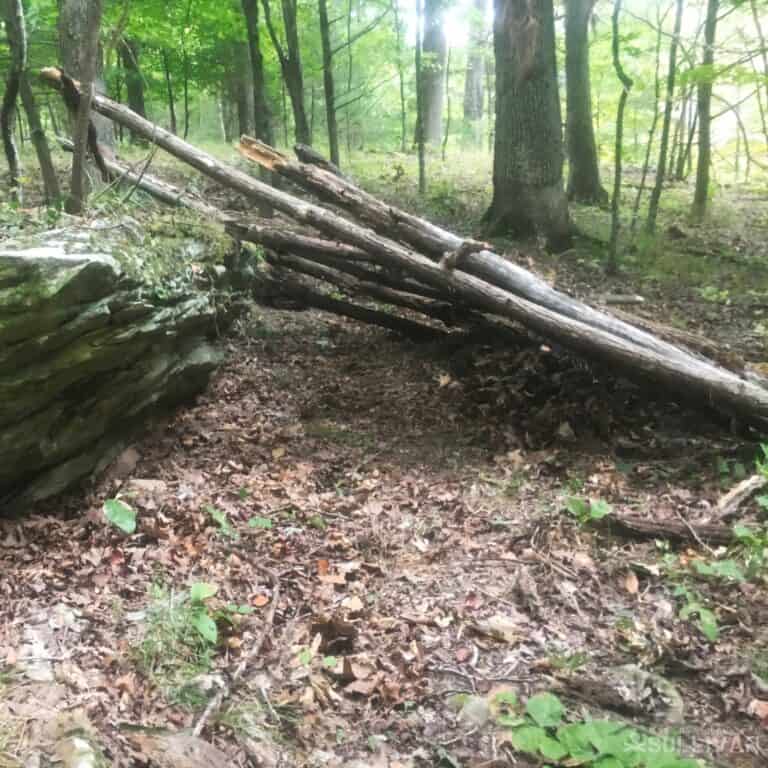
Building a shelter or finding one is by far the most important survival skill you could have.
This is because, while you may be able to go on for days or even weeks without food and water, hypothermia and not having a roof over your head could get you pneumonia, and hypothermia, and eventually kill you.
Any good prepper will already have several ways to make shelter in his bug out bag and bug out vehicle, including:
- a 2 person tent – probably the most comfortable type of shelter you can have in a bug out situation
- a bivvi bag
- an emergency blanket
… but the real skill is to find or even build shelter on your own, whether you’re out in the wilderness or even in a big city, in an apocalyptic setting.
Some of the “ready-made shelters” you could find include:
- finding an abandoned house or building that you’re sure it’s safe
- staying inside your car or bug out vehicle
- finding a cave in the wilderness
Building a Shelter in the Wilderness
If you can’t find a shelter, the last option is to make your own. There are urban shelters, and there are wilderness shelters, but keep in mind the elements, as you might be forced to set camp in the rain .
A lean-to shelter (see above) is the most common type and the one that requires the least amount of gear to make.
You’ll need either a fallen tree branch or something to lean into the main branch, such as a large rock (see above).
Next, place branches and twigs of various sizes left and right of the main one. To isolate the makeshift shelter even better, use moss or dry leaves.
Last but not least, make an opening to allow yourself and the heat from the nearby open fire to get inside.
Ensure the entrance is not directly facing the dominant direction of the wind. In fact, the location of your shelter is critical for your survival.
Now, there are several other ways to make shelters out in the wild, such as:
- tree pit snow shelters
- tarp burritos
- … and more .
Cardboard Box Shelter
The cardboard box emergency shelter is for urban scenarios , but if you’ve got nothing else, you can attempt to make one anywhere.
City dumpsters are full of cardboard boxes which will be more than enough to keep you warm, especially since the buildings’ walls will already keep the wind away. Homeless people use them all the time, so why can’t you in an emergency?
Easiest Way to Practice Shelter-Building
Take your spouse or kid and go camping in the woods. Bring a tent and a tarp, then practice setting them up. Gather twigs and practice making a basic lean-to. See what you can find to insulate it.
Skill #2: Water Filtration and Purification
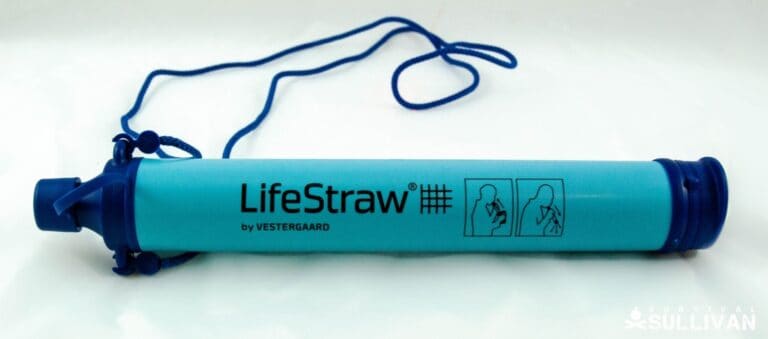
There are easy ways and not-so-easy ways to filter water…
Disclosure: This post has links to 3rd party websites, so I may get a commission if you buy through those links. Survival Sullivan is a participant in the Amazon Services LLC Associates Program. As an Amazon Associate, I earn from qualifying purchases. See my full disclosure for more.
If you have a personal water filter such as a LifeStraw or a Sawyer Mini , you should be covered.
However, pre-filtering water before running it through your filter is always a good idea. I’m talking about muddy water with large particles that could clog your filter.
A second option would be water purification tablets . These are cheap, lightweight, and will kill all microorganisms.
If the water has dirt and debris, you’ll want to filter that first.
Third, you could boil water . Unless you’re dealing with a virus, boiling water will probably kill all bacteria and pathogens from it.
Depending on the altitude you’re at, you may want to keep the water to a rolling boil for at least a few minutes (though some say getting it to a rolling boil is enough).
Tip: if at all possible, stay away from stagnant water, such as that lakes and ponds. It’s most likely chock-full of bacteria and other diseases .
Unless you’re desperate, you might want to look for alternative water sources in spite of the fact that your water filter would be able to remove those parasites.
Probably the most complicated (and questionably safe) way of filtering water is to make your own water filter using activated charcoal, sand, small rocks, and even a cotton cloth.
You can use charcoal from your campfire and a bandanna or something similar to put at the top of the filter to remove large particles first.
You should also place a second cotton cloth or a coffee filter at the bottom of the filter to be the very last thing the water passes through before reaching the second container.
How to Practice Water Filtration
Get dirty or muddy water from a nearby river or lake. use your water filter to filter some of it. Use your DIY water bottle filter to filter some of it as well.
Compare the results by looking at how clear the resulting water is, how it smells etc. Take all 3 water samples to a company that can analyze them and tells you which ones are safe to drink.
Skill #3: Fire-Starting
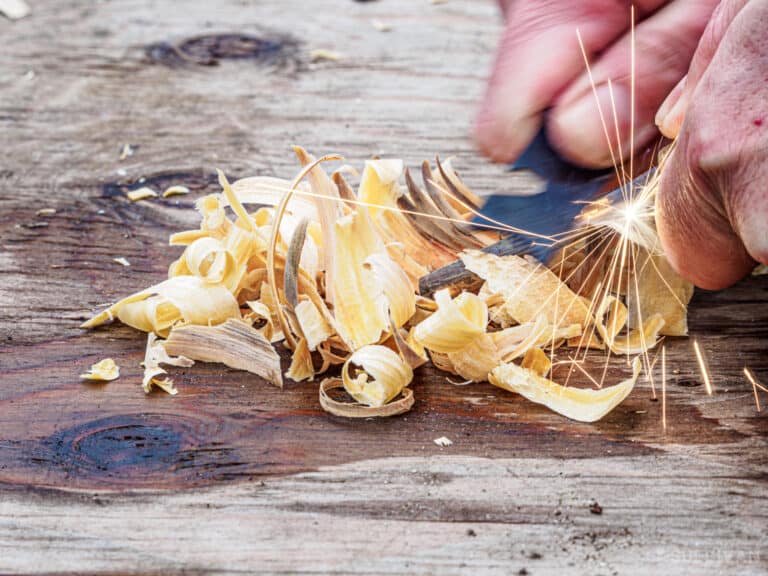
Starting a fire is one of the most important basic survival skills you can have. It’s not enough to have a lighter .
It’s what you do when you don’t have one available, or if the lighter stops working (happens all the time).
Ways to start a fire without matches or lighters:
- using sticks (the bow drill method, the hand drill method)
- using a ferro rod
- using a magnesium firestarter
- using a fresnel lens
- using steel wool and a 9V battery
- … and many more
Two popular fire-starting methods that I don’t actually recommend are the bow drill and the hand drill.
Any method that requires rubbing sticks together is time and energy-consuming, and if you don’t have the right wood or if the wood is wet, you’re wasting your time.
Starting a fire is NOT a skill you should get creative with. You need to have those 3 or 4 methods of starting a fire, and to make sure they’re functional.
Inspecting your gear doesn’t take that much time, and is something you should be doing at least every 6 months.
A very important “skill” to include here is remembering to stay dry at all times. If you cross a body of water or get caught in a rain or flood, you’ll be soaking wet.
Without adequate shelter and fire, hypothermia could set in, and it could go as far as to kill you.
How to Practice Starting a Fire
The next time you do some outdoor cooking (even if it’s in your backyard), avoid using a lighter to start a fire. Use a ferro rod and some tinder to do it, even if it takes a little bit longer to get it started.
Skill #4: Self-Defense

In order of importance, the best ways preppers can defend themselves when SHTF are:
- a solid fixed-blade knife plus knowledge of how to use it
- pepper spray or similar non-lethal alternative
non-lethal weapons such as crossbows, bows and arrows, slingshots, tactical pens, etc.
- knowing how to fight or knowing self-defense moves
- being able to use the items around you in self-defense (a mug, your keys, a solid flashlight, a pen
- being able to calm your opponent down and avoid a fight all-together
If you can’t defend yourself without a knife or a gun, what will you do when you don’t have access to them? You have to take these possibilities in mind.
Remember the most sensitive body parts of the human body and practice ways to hit them, such as the eyes, the ear, the neck, the nose, and the groin.
You won’t be able to kill your attacker but you might gain precious seconds that will allow you to flee.
In addition, keep in mind you might run into four-legged predators. From stray dog packs to bobcats and bears, keep them in mind as you’re hunting, bugging out, or setting temporary camp.
There is advice for each predator, but in general, you should:
- stay calm; don’t panic or run; move slowly
- don’t keep food in a tent or just lying around
- this is easier said than done, but try not to hide or crouch – you want to make yourself appear larger and more intimidating
Skill #5: Basic First-Aid
At the very least…
- you should know what’s in your first aid kit and how to use each item
- you should be able to do chest compressions and CPR
- treat bruises, cuts, and wounds
- how to stop a bleeding wound, including a gunshot wound
- take care of fractures
- treating a burn
- solve breathing problems such as tongue blocks
- what to do in case of electric shocks, stings, bites, and much, much more.
How to Practice Basic First-Aid
How do you improve your first-aid skills? Well, you can’t practice them on your own, that could be really dangerous.
You should definitely take a first aid course. Youtubes are a good reminder but will NOT improve your skill level, because the retention rate is not that good, and this is a life-and-death skill, you cannot afford to screw up.
Nevertheless, you can find dozens of first-aid YouTube videos to learn from.
Skill #6: Outdoor Cooking

Knowing how to start a fire is just the beginning. You need to be able to keep it going, you need to make sure it’s not easily seen from afar, and to make sure you don’t set anything around you on fire.
If you don’t have an open fire, then maybe you have a small camping stove. Whatever you have, you should be able to use to cook the freeze-dried food you carried with you, to cook using sticks you cut for yourself and even use cast iron for more complex meals.
How to Practice Outdoor Cooking
Start with backyard cooking and with a few very basic recipes, such as cooking meat and veggies on a stick. You can also try baking potatoes in aluminum foil.
Here’s a great starter article on all of the ways to cook outdoors, and here’s a kick-ass video on how to cook on hot coals:

Skill #7: Off-the-Grid Communication
Whether you want to use a HAM radio, a walkie-talkie, or CB radio to communicate in an emergency , you should know how to operate them.
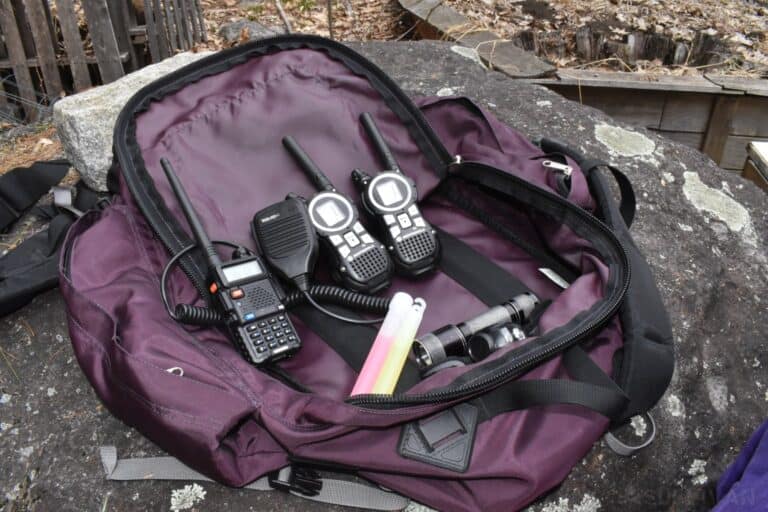
You should also know a HAM radio requires you get a license, but it’s perfectly ok to use it without a license in an emergency.
You should also have ways to gather information in an emergency, be it using the obvious choices such as a TV or the Internet, to using a hand-crank emergency radio, or by developing a prepper group to keep each-other informed.
Skill #7: Knot-Tying
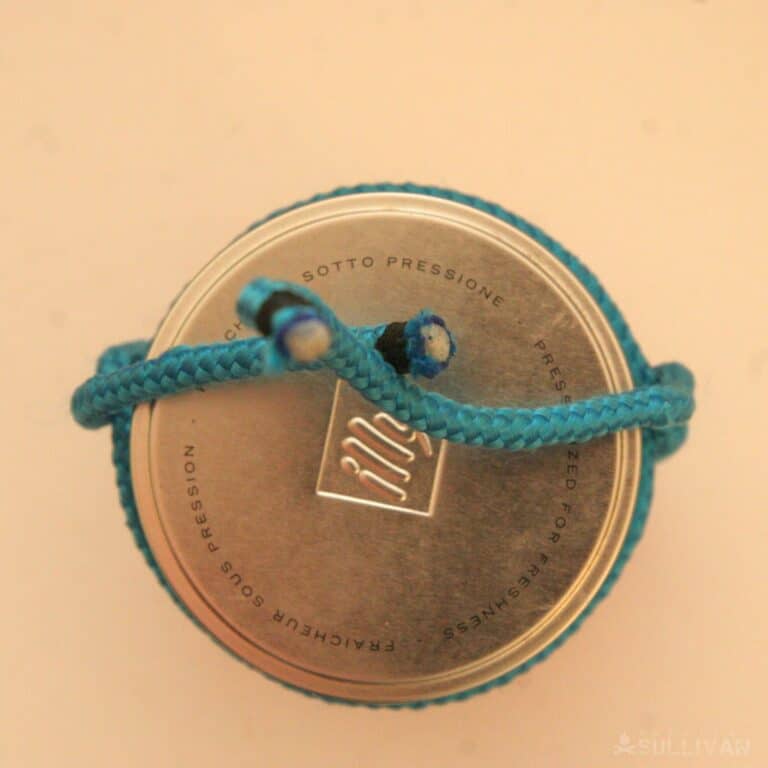
There will be a lot of situations in which you’ll need a good, solid knot. While there are tons of various knots out there to learn, you only need to know one good knot, such as the Clove Hitch Knot , and practice it over and over again.
Our guide has all the essential knots you might need for survival, but learning 2 or 3 should be more than enough before you move on to learning the next skill.
Skill #8: Shooting a Gun
Owning a gun without knowing how to use it is pointless and even dangerous. That’s why proper firearms training is paramount.
You should also be able to pick the right gun for your needs (whether you live in the city or in a small town, in a house or in an apartment building, whether you want to bug in or bug out when disaster strikes, and so on).
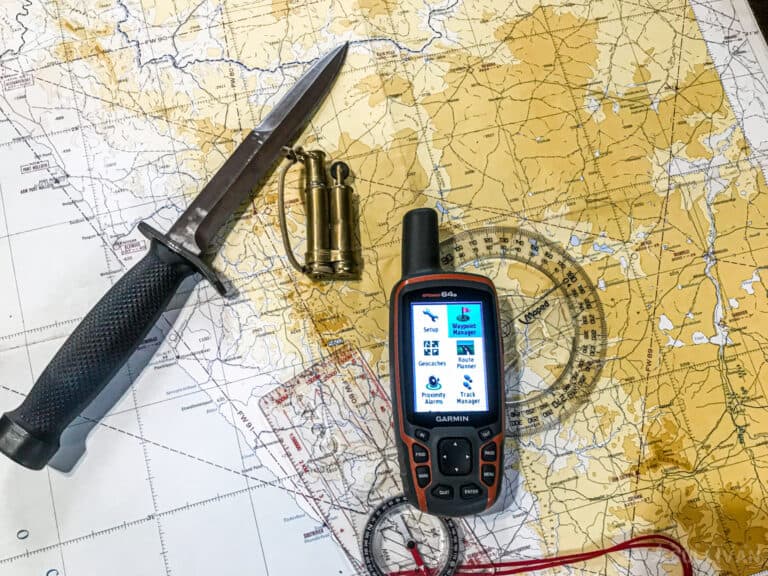
Skill #9: Navigation and Orientation
A few of the things you should know:
- how to tell time without a watch
- how to navigate using landmarks
- how to read a topographic map
- how to find your way back when you get lost
You should also know how to use a map and a compass to find your way in the wild. A good lensatic compass is not that expensive, but you really need to get out there and practice getting from point A to point B without a GPS.
Skill #10: Finding Food and Water
Finding water can be tricky because it depends on the latitude, altitude, location, and so on. Lakes and rivers are good source of water provided you can filter it before you drink it, but what happens if you can’t find any?
Birds, bees and insects could mean water is nearby, although parrots and reptiles are not good indicators of water. You might find water inside rock crevices, in valleys, or you can be smart and collect it from dew, tree leaves, or by digging the earth.
City dwellers have options too: lakes, ponds, fountains, swimming pools, vending machines, and so on.
Another easy way of getting clean water is to harvest rainfall. You can use your tarp or poncho to do this, but other containers such as buckets and canteens will be able to gather small amounts as well.
As far as food is concerned, the easiest way to get some calories is to forage for berries, fruit, and other plants that you can eat. Even if you’re an urban prepper, you should still be able to find lots of wild edibles in your city post-collapse.
The most common and most widely available wild edibles include:
- elderberries
- …and more .
Fishing, hunting, trapping small game (such as rabbits ), and finding bird eggs are all good options in the wilderness, but you have to know how to fillet a fish, how to skin an animal, and how to cook it.
These are a little trickier to learn, so if you’re not comfortable practicing them, just stick to foraging, and get good at identifying wild edibles as well as any poisonous lookalikes.
Within cities, look for vending machines and city ponds that may have ducks and fish, but foraging for wild edible plants and for fruit may also be possible.
Above all, probably the most important survival skill is your mental attitude. In an emergency or SHTF, something most of us have never experienced, keeping our cool and remaining calm and assertive are probably the most important things we could do.
Without it, we won’t be able to put into practice any of the skills discussed in this article.
You should take a good, honest look at yourself, your family, and your situation, and figure out to what extent you’re ready for a disaster, and whether or not you have what it takes to survive it .
If you don’t – that’s fine! you realized you’re not ready and that’s a BIG step forward. Now you know what to do.
Keep a positive mindset and remember that every little thing you learn, every skill you improve upon, and every bottle of water you stockpile will increase your chances of survival. Even if just by a little bit.
So, now what? Well, you could take these 10 skills one by one, but don’t just try them out – get GOOD at them, then make sure you practice them regularly.
It’s the only way to guarantee you’ll remember them when it’ll matter most.

My dad was military. My grandfather was a cop. They served their country well. But I don’t like taking orders. I’m taking matters into my own hands so I’m not just preparing, I’m going to a friggin’ war to provide you the best of the best survival and preparedness content out there.
8 thoughts on “10 Critical Basic Survival Skills To Save Your Life”
You really don’t need a 9v battery to make fire with steel wool. It might be a little easier, but any battery will do, just touch the steel wool to the positive and negative terminals.
Also, be careful not to burn yourself. The steel wool will warm rapidly before catching fire, and break into fire almost instantly.
BTW, if you are storing steel wool, store it in an airtight can, glass jar, or something that will keep it from corroding. I once had a bag sitting on my work bench. It was open, partially used. Reached up to grab a pad that had a bit of rust on it (from humidity in the air…Pacific Northwest then) and as I stretched the pad, it burst into flame. Evidently well known that rusty steel wool can self-ignite.
Yeah, I always wondered whether this can be done with a regular battery. As you said, it’s more dangerous, but still, it might be the only choice in an emergency situation. All you need is steel wool and one of your flashlight’s battery.
A zipper bag should work as far as storage is concerned.
I enjoyed this very much, thanks for posting.
Excellent article, but I have one correction. HAM License: I teach the HAM Licensing Class in our city In an “emergency situation” you DO NOT need a license to communicate. Even if you never get a license, a “hand held” (HF and UHF) transceiver with power up to 10 watts is reasonably priced and should be in every preppers kit. If you never use it to transmit, you can listen in on what is happening in your area and react accordingly.
It should be made clear that “emergency” means a situation with immediate life-and-death urgency. If you use the radio to declare an “emergency” for some other than a life-threatening situation, there could be serious consequences.
Beggars use them all the time… . How very un-PC. . Love it!
One way to turn a 72 hour bag into an INCH (I’m Not Coming Home) is to fill your smartphone with GPS app, maps, edible plant guides, personal apps, survival info, edible plant guide, backup document and personal pictures and backups of contacts. Than add a small solar waterproof shockproof flashlight powerbank to your EDC (EveryDay Carry) and a lightwieght solar panel (Nekteck, Anker, Foxelli, Enerplex that matches your use of juice) to your bag. Add a mini A/C and cigarette lighter power adaptor to your bag. You can charge everything (flashlight, electric plasma ligher, phone, radio) with the correct (mostly USB) adaptors.
None of these are non-lethal weapons…
Leave a Comment Cancel Reply
Your email address will not be published. Required fields are marked *
Survival Skills
There are many skills that would be needed to survive on an uninhabited island. The difficulty of surviving would be lessened if a person had the knowledge in hunting, building shelters, and first aid. Hunting is important because this skill will keep people from starvation. Knowing the difference between what animals and plants are a good food source and which animals and plants can harm a persons' body can save or kill a person. Being able to build a sturdy shelter Is Important, whether It Is raining or extremely hot.
Gathering sucks, thick plants, tree branches, and any type of wood Is an easy Job, however figuring out how to keep It In place can get tricky. Being stranded on an uninhabited Island Is bound to some sort of Injury. Knowing first lad skills can benefit any Injury a person can be faced with, from a simple scrap to a broken bone. An Island that a person Is stranded on seems unlivable, but knowing these simple skills; hunting, building shelter, and first aid, will help an uninhabited situation. This was a good paper It was on survival skills. I hope you enjoy It.
I learned all of these survival skills on my own when I was at camp we were taught all of these skills even how to build a tent. I am just the coolest person ever that is why I know how to survive on my own. Mr.. Sullivan English 60 A March 17, 2011 or kill a person. Being able to build a sturdy shelter is important, whether it is raining or extremely hot. Gathering sticks, thick plants, tree branches, and any type of wood is an easy Job, however figuring out how to keep it in place can get tricky. Being stranded on an uninhabited island is bound to some sort of injury.
Order custom essay Survival Skills with free plagiarism report
Knowing first aid skills can benefit any injury a person can be faced with, from a simple scrap to a broken bone. An island that a person is stranded on seems unlivable, but knowing these simple skills; hunting, building shelter, and first aid, will help an uninhabited situation. Survival Skills By valetudinarian situation. This was a good paper it was on survival skills. I hope you enjoy it. I learned skills even how to build a tent. I am Just the coolest person ever that is why I know wood is an easy Job, however figuring out how to keep it in place can get tricky. Being
Related Questions
on Survival Skills
Cite this Page
Survival Skills. (2017, Oct 25). Retrieved from https://phdessay.com/survival-skills/
Run a free check or have your essay done for you

More related essays
Introduction: The strength of the house depends on its foundation similarly for the survival of business in market its foundation plays a crucial role. A start-up can be defined as a.
The urgent crave to survive at all costs is known as the primacy of survival. Survival is essential for every animal, and there is no shortage of lengths they will.
Survival of the Fittest His sweaty palms clutch a few coins. The bus line moves forward. Ticket paid for, a quick glance to the back of the bus. They wait,.
Introduction In a competitive global market, micro, small and medium-sized enterprises (SMEs) play an increasingly important role in a nation’s economy. Today they make a substantial contribution to job creation, innovation,.
Personal Trainer & Nutritionist have been a personal trainer and nutritionist for over 6 years. I got my certification from A. F. T. A in the USA Speaker conducts various.
A prospective, randomized and comparative study of oocyte survival by slow freezing and vitrification methods. Dr. Suresh Babu Chaduvula, Abstract: Aim and Objectives: To determine the efficacy of slow freezing.
Our world has experienced many pandemics over the course of history, from the bubonic plaque to the HIV/AIDS virus. But what happens when a virus brings us back from the.
There is no doubt that some societies are more fragile than others. The subjective observation of a societies ability to succeed or fail can sometimes be misleading when not all.
We use cookies to give you the best experience possible. By continuing we’ll assume you’re on board with our cookie policy
Save time and let our verified experts help you.
Understanding the Core Function of the Muscular System
This essay about the muscular system explains its essential role in human survival and daily activities. It describes how the system, comprising over 600 muscles, works in conjunction with other bodily systems to facilitate movement, maintain posture, generate heat, and support various physiological processes. The essay highlights the different types of muscles—skeletal, smooth, and cardiac—and their specific functions, from voluntary movements and digestion to blood circulation and temperature regulation.
How it works
Muscle system – only from systems more critical in human meat, chargé for myriads positions, that above all for survival and daily activities. In his kernel, position of initial letter muscle system – to unload advancement, and his roles draw out he far after the simple moving. This trickle muscles tangled trains the soul ? the soul with framework system, system, and combine other corporal nervous systems, to provide not only advancement, and and stability, position, and physiological vital processes.
Human meat moves over 600 muscles, that can categorized in three : places of crossing frameworks, hand-rail, and cardiaque strengthen muscles.
Aspect every muscle frisks a role and legible skeleton, plays in favour of functionality muscle the system complements. Frameworks muscles join despite fish bones tendons and under voluntarily control, means, as them can be conscious directed, to execute specific tasks. These muscles chargé for advancements so as for example walking, undercutting, and other physical activities. Muscles, found in walls entrails so as for example smooth a stomach, bowels, and blood vessels, no under voluntarily control and function automatically, to manage corporal processes well-assorted in manner from digestion and whirlwind. Muscle, found only in a cardiac heart, too unintentional and specialized despite continuously blood pump in one flow from.
Advancement is position muscle system more obvious. It is arrived at through a compression and relaxation frameworks strengthen muscles, that train in_pairs, to move fish bones at connections. For example, when you want to bend your hand, muscle a biceps enters into a contract, while triceps strengthens muscles tearing down, settles elbow joint despite a supple cord. From other side, for straighten hand, triceps agreement and biceps destroy. It coordinates possible made an effort system, that delegates signals nervous muscles, instructing they on that, when to conclude a treaty and when to destroy.
After a lumber-room advancement, muscle the system frisks an in vital role manners position and relation meat. Even, when we stand whole yet or meeting, our muscles train constantly, to have us vertical and balanced. Postural strengthen muscles, that include muscles side, neck, and reverse stomach, train continuously, to neutralize force gravitation. These muscles operate easy corrections despite our relation meat, mixes us to prang and provides, that we remain immobile and balanced.
Muscle too above all system for making heat and manners temperature meat, process, celebrates so as thermogenesis. When muscles enter into a contract, make them heat so as by-product metabolic processes, that flexibly energy for activity muscle. This critical heat for manners temperature the most important meat, private in cold environments. Trembling, for example, is an unintentional answer despite a cold, that includes compressions muscle rapid, renews he, to make a heat and warm meat.
? addition despite these mechanical positions, muscle system close obligated by in corporal positions, that critical for survival well-assorted. Smooth muscles in the digestif system help move food through a digestif highway through a process under an appeal peristalsis. This rhythmic compressions provide, that food is present things with digestifs enzymes and moved along intestins for nourishing absorption. So, smooth muscles in blood vessels manage a diameter pools, fleuve sanguin and blood pressure regulator. This criticism for diffuse oxygène and nutritives despite fabrics and organs and for manners cardiovascular complete health.
Cite this page
Understanding the Core Function of the Muscular System. (2024, May 28). Retrieved from https://papersowl.com/examples/understanding-the-core-function-of-the-muscular-system/
"Understanding the Core Function of the Muscular System." PapersOwl.com , 28 May 2024, https://papersowl.com/examples/understanding-the-core-function-of-the-muscular-system/
PapersOwl.com. (2024). Understanding the Core Function of the Muscular System . [Online]. Available at: https://papersowl.com/examples/understanding-the-core-function-of-the-muscular-system/ [Accessed: 29 May. 2024]
"Understanding the Core Function of the Muscular System." PapersOwl.com, May 28, 2024. Accessed May 29, 2024. https://papersowl.com/examples/understanding-the-core-function-of-the-muscular-system/
"Understanding the Core Function of the Muscular System," PapersOwl.com , 28-May-2024. [Online]. Available: https://papersowl.com/examples/understanding-the-core-function-of-the-muscular-system/. [Accessed: 29-May-2024]
PapersOwl.com. (2024). Understanding the Core Function of the Muscular System . [Online]. Available at: https://papersowl.com/examples/understanding-the-core-function-of-the-muscular-system/ [Accessed: 29-May-2024]
Don't let plagiarism ruin your grade
Hire a writer to get a unique paper crafted to your needs.

Our writers will help you fix any mistakes and get an A+!
Please check your inbox.
You can order an original essay written according to your instructions.
Trusted by over 1 million students worldwide
1. Tell Us Your Requirements
2. Pick your perfect writer
3. Get Your Paper and Pay
Hi! I'm Amy, your personal assistant!
Don't know where to start? Give me your paper requirements and I connect you to an academic expert.
short deadlines
100% Plagiarism-Free
Certified writers

Santa Clarita Valley's #1 Local News Source
From drab to fab: elevate your essay writing with powerful techniques, sponsored post.
- May 28, 2024
Essays. The mere word can make some students groan and break out in a cold sweat. Some of them don’t know where to start, and others wonder, “How do I make my essay better to get a good grade?” But essays don’t have to be your nemesis. With the right tools and tricks, you can transform your essays from drab to absolutely fabulous!
Whether you panic at the sight of a blank page or feel like your texts always end up being a confusing jumble, you’re in the right place. And yes, sometimes it helps to get extra guidance from websites like WritePapers when it comes to academic writing. Yet, with the strategies we’ll talk about here, you can start crafting those A+ essays your teachers will rave about.
Let’s ditch the dull texts and get creative!

Spice Up Your Sentences
Basic sentences get the job done, but they won’t make your essay pop. To really elevate your writing, you should experiment with different sentence structures and words.
Think about how you can add flair to your writing strategies. A mix of sentence lengths is a great starting point. Short, punchy sentences can create emphasis. Longer, detailed sentences are perfect for describing complex ideas.
And don’t forget the power of those vivid verbs! They bring your writing to life. Instead of describing something as “interesting,” try words like “fascinating,” “captivating,” or “riveting.”
Master Transitions
Smooth transitions are essential for creating a strong, cohesive essay. Imagine trying to cross a river without any bridges…it’d be tough! Effective transitions show the relationships between your ideas, taking your reader on a clear and logical journey.
Using signal words and phrases is a cornerstone of successful transitions. For example, if you’re adding onto a previous point, words like “furthermore” or “additionally” work wonders. Want to show contrast? Try “however” or “on the other hand.” To demonstrate cause and effect, use words like “consequently” or “therefore” are your friends.
But transitions can be more subtle than just these signal words. A well-placed example or brief anecdote can seamlessly move from one concept to the next.
Apply the Right Evidence
Using relevant evidence is one of the best essay writing strategies. But simply dropping a quote won’t cut it. The real magic comes from analyzing and integrating evidence into your own words. Explain why that particular quote or piece of data backs up your argument.
Moreover, you should provide context for your evidence. Don’t let it stand alone in a disconnected way – weave it seamlessly into your writing.
And lastly, remember that variety is key when it comes to essay writing tips. Mix up the types of evidence you use – a poignant quote, a relevant statistic, or a vivid example – to keep your reader engaged and make your points even more convincing.

Don’t Skip the Revision Step
Never underestimate the power of thorough revision. It’s where you can refine your ideas, polish your writing, and truly make your essay better.
One crucial step in the revision process is to take a break after writing your first draft. Returning to your work with fresh eyes lets you catch those sneaky errors or confusing passages you might have glossed over initially.
Reading your work aloud is another invaluable strategy! Hearing your words spoken out loud helps you notice awkward phrasing or areas where the flow feels off. This is a simple yet highly effective way to identify where you might need to focus on how to improve writing skills.
Finally, remember that revision isn’t just about fixing typos (although those are important, too!). Take a step back and ask yourself the big questions:
- Is your thesis statement crystal clear?
- Is your essay well-organized?
- Does each paragraph seamlessly support your main argument?
If you find yourself needing guidance or an extra set of eyes, don’t hesitate to seek out help with writing. There are numerous resources available, including online platforms and essay writing services, that can provide valuable feedback and help you take your writing to the next level.
Embrace Your Voice
One of the easiest ways to fall into the “drab essay” trap is by trying to sound overly formal or academic. While correct grammar and good structure are non-negotiable, letting your own voice shine through is what makes your writing memorable. Think about these tips:
- Write like you talk (but a bit more polished). Imagine you’re explaining your essay topic to a friend. What kind of language would you use? Keep the tone engaging and natural.
- Don’t be afraid of strong opinions. Essays are opportunities to argue your point of view. Using words like “clearly,” “undoubtedly,” or “importantly” adds conviction to your statements.
- Own your perspective. Share insights or experiences that relate to your topic. This sets your essay apart from the crowd.
Your writing doesn’t have to be filled with complex jargon to be impressive. Clarity, confidence, and a dash of personality can create an engaging essay that your teachers won’t soon forget!
Final Thoughts
Essays aren’t always the most thrilling thing in the world. But with the strategies we talked about, you can learn to craft sentences that make your reader lean in, not zone out. You’ll master the art of making your ideas flow effortlessly, and you’ll use evidence like a pro to back up your arguments.
The revision process allows you to look at the piece of writing from another perspective. Don’t be afraid to read your essay out loud, get feedback from others, and ask those big-picture questions about your organization and thesis statement.
And hey, we all need a little extra support sometimes! There are tons of amazing resources out there to help if you need guidance on how to write better essays.
Most importantly, don’t try to sound like someone you’re not. Let your personality be reflected in your writing. Share your unique perspectives, use vivid language, and express your opinions with confidence. Your teachers will notice the difference!
Related To This Story
15 projects to make with svg files, the most common injuries in a construction site, what to do if you’ve been terminated unjustly in california, 10 tips to help you rent appliances for your home , leading the charge: plastic bag bans in the u.s. and sustainable solutions, winter sneaker styles to keep you warm and trendy, latest news.

Man arrested on suspicion of attempted murder

From COC to the University of Cambridge

Garcia announces congressional art winners

Photos: Traffic collision

UC student workers expand strike to two more campuses as they demand amnesty for protesters
Sign up for the, morning rundown.
Filled with the top stories to start your day, and emergency news alerts.

25060 Avenue Stanford, St. 141
Valencia, CA, 91355
Main Desk: 661-259-1234
Newsroom: 661-255-1234
Advertising: 661-287-5564
Have a news tip? Let us know!
News Sections
- Coronavirus
- Environment
- Politics & Government
More Sections
- Video + Podcasts
- Sunday Signal
- Subscribe to Print
- Classified Ads
- Event Calendar

COMMENTS
Survival Skills, Essay Example. HIRE A WRITER! You are free to use it as an inspiration or a source for your own work. Survival Skills: Three Kinds of Discipline. For a student, the most obvious place to look for something to classify is in the unique life of the campus, classroom, and dorm-room. But this paper's instructions state to ...
Look for other sources of water like streams or rainwater, and consider boiling it before drinking to purify it. Discover These Essential Wilderness Survival Skills: Shelter, Food, Water, Fire, First Aid, Gear, Self-Rescue, Self-Defense & More. Be Prepared.
10 Survival Tips: How to Put Survival Skills Into Practice. Hard skills, resiliency, and a will to live can carry you through various obstacles in a survival scenario. Read on for essential wilderness survival tips that could mean the difference between life and death in extreme circumstances.
The journey of survival, whether in the face of physical challenges, adversity, or life's uncertainties, is a testament to the strength of the human spirit. ... This essay will examine the essential components of survival — adaptability, mindset, resourcefulness, and social support — highlighting the qualities that enable individuals to ...
Survival is a fundamental instinct that drives us to overcome adversity and thrive in challenging situations. This essay delves into the qualities that enable us to navigate life's trials and tribulations, highlighting the attributes that contribute to our resilience, adaptability, and ultimate survival.
Basic Survival Skill 1: Fire. Fire is the king of survival techniques! Fire can purify water, cook food, signal rescuers, provide warmth, light, and comfort. It can also help keep predators at a distance and can be a most welcome friend and companion. As a survival technique, it is one that is essential. Each and every person who ventures into ...
The basic list includes drinking water, no-cook food, non-flame light sources (flashlights instead of candles), first aid supplies, and a host of other handy supplies. Again, it's a great place ...
The Importance of a Survival Mindset: Optimism and Hope. Those who walk out of adverse situations all have an optimistic and adaptable mindset that allows them to maintain a survival attitude. The Rule of 3s is an important gauge for understanding survival priorities. Humans can typically survive.
Survival training is important for astronauts, as a launch abort or misguided reentry could potentially land them in a remote wilderness area. Survival skills are techniques used to sustain life in any type of natural environment or built environment. These techniques are meant to provide basic necessities for human life, including water, food ...
Survival typically refers to enduring circumstances or situations that may challenge a person's well-being and life, or to persevering through trials and hardships. Natural disasters, violent conflicts, war and even economic hardships can create the need for survival skills. Essays on survival can be written from ...
CNN —. After camping in Oregon in May, Harry Burleigh spontaneously decided to venture off on a trail before returning home. What he expected would be a quick, out-and-back hike took a dramatic ...
Basic Skills 101: Survival Techniques. What we might think of as survival techniques were just basic life skills for our ancestors. The more I learn about how our forebears lived, the I admire them. While they might be lost in today's world of smartphones and the Internet, they possessed a far greater wealth of knowledge about the most basic ...
Abstract. This introduction emphasizes the multidimensionality of the issue of 'survival', which frequently implies complex acts of ethical decisions. First focussing on the 'survival of individuals', it studies survival in the context of the philosophy of 'natural law', connecting it to mythology and theology.
First, you only set yourself up for disappointment when things don't go your way, and second, maintaining a realistic outlook will keep you from getting complacent. You always need to be planning and working as though you're in your situation for the long haul. In short, hope for the best, but plan for the worst. 3.
Survival skills. Survival skills are techniques a person may use in a dangerous situation (e.g. natural disasters) to save themselves or others (see also bushcraft). Generally speaking, these techniques are meant to provide the basic necessities for human life: water, food, shelter, habitat, and the need to think straight, to signal for help ...
Learning should be meaningful and applicable. Two of the most important skills we can help our children master is the ability to research and communicate effectively, both verbally and in writing. At all grade levels, we need to stretch our children's ability to think critically, synthesize information, and present their findings .
Remember the 1-10-1 Rule for Cold Water Survival. Water immersion can be dangerous in waters under 60℉, and the body's cold shock will be as intense at the that temperature as it would be at 35℉. Therefore, anyone who recreates or works around cold water should remember the 1-10-1 Rule. Essentially, after cold water immersion you have ...
Photo: Shutterstock Starting & Tending To A Fire. Second only to finding suitable water, the ability to make fire is one of the absolute most important and useful skills anyone can develop in the case of an emergency.Not only will it give you life-saving warmth in the cold of night, but you can use it to purify water, cook food, ward off predators, cauterize wounds, and even signal for help.
To cook your fish: • Heat 6 to 8 medium-sized rocks in a fire for a few hours. • Dig a hole in the dirt 1 foot deep and 2 feet across. • Move the hot rocks into the hole using a stick. • Wrap your fish in green leaves and tie it with vine. • Put the wrapped fish on top of the rocks and cover it all with dirt.
The Theme of Survival in "Hatchet" by Gary Paulsen. Essay grade Good. In Gary Paulsen's novel, "Hatchet," Brian Robinson is a 13-year-old city boy who lives in Hampton, New York, and is going through a tough time as his parents are getting a divorce. Brian has to ride a plane all by himself from Hampton, New York,...
a 2 person tent - probably the most comfortable type of shelter you can have in a bug out situation. a poncho. a tarp. a bivvi bag. an emergency blanket. … but the real skill is to find or even build shelter on your own, whether you're out in the wilderness or even in a big city, in an apocalyptic setting.
Basic survival knowledge may have prevented the boys from ever getting lost. Basic survival knowledge may have helped Marco leave the woods in semi decent health. The first reason these skills should be taught is prevention of these incidents. The first prevention tool is navigation. As stated earlier in the essay, people get lost outdoors.
Order custom essay Survival Skills with free plagiarism report 450+ experts on 30 subjects Starting from 3 hours delivery Get Essay Help. Knowing first aid skills can benefit any injury a person can be faced with, from a simple scrap to a broken bone. An island that a person is stranded on seems unlivable, but knowing these simple skills ...
This essay about the muscular system explains its essential role in human survival and daily activities. It describes how the system, comprising over 600 muscles, works in conjunction with other bodily systems to facilitate movement, maintain posture, generate heat, and support various physiological processes.
Spice Up Your Sentences. Basic sentences get the job done, but they won't make your essay pop. To really elevate your writing, you should experiment with different sentence structures and words.